Super User
โครงการนำพลังงานทดแทนไปใช้งานที่โครงการพัฒนาดอยตุง (พื้นที่ทรงงาน) อันเนื่องมาจากพระราชดำริ
โครงการนำพลังงานทดแทนไปใช้งานที่โครงการพัฒนาดอยตุง (พื้นที่ทรงงาน) อันเนื่องมาจากพระราชดำริ
ระบบประจุแบตเตอรี่ด้วยเซลล์แสงอาทิตย์แบบรวมศูนย์ 2 ระบบ โดยกรมโยธาธิการ
โครงการฯ ได้ติดตั้งระบบประจุแบตเตอรี่ด้วยเซลล์แสงอาทิตย์แบบรวมศูนย์ประกอบด้วยเซลล์แสงอาทิตย์ขนาด 790 วัตต์ชุดควบคุม 1 ชุด แบตเตอรี่ 65 แอมแปร์ชั่วโมง 12 โวลต์ จำนวน 5 ลูก โรงประจุแบตเตอรี่ขนาด 12 ตารางเมตร จำนวน 1 หลัง และหลอดไฟฟลูออเรสเซนต์ 18 วัตต์ จำนวน 5 ชุด เป็นระบบที่มีลักษณะการทำงานคือ ในเวลากลางวัน คนงานปลูกป่าจะต้องนำแบตเตอรี่ไปประจุไฟฟ้าที่โรงประจุ โดยโครงการฯ ได้จัดตั้งให้ราษฎรมาช่วยกันดูแลการประจุ
การใช้งาน การดูแลรักษา และหลังจากกลับจากทำงานแล้ว คนงานก็จะนำแบตเตอรี่ที่ประจุเต็มแล้วกลับไปใช้งานที่บ้านของตน โดยมีการกำหนดรอบการประจุและวิธีใช้งานเพื่อป้องกันไม่ให้แบตเตอรี่เสื่อมสภาพ ซึ่งแบตเตอรี่ 1 ลูกสามารถใช้กับหลอดไฟฟลูออเรสเซนต์ 1-2 หลอด ได้ประมาณ 3-5 ชั่วโมง
ระบบดังกล่าวติดตั้งในพื้นที่ 2 แห่ง แห่งละ 1 ระบบ ในโครงการปลูกป่าพระราชทาน 4,000 ไร่ ได้แก่
1. ปางสี่ เป็นพื้นที่ที่เดิมไม่มีไฟฟ้าใช้ เนื่องจากระบบสายส่งของการไฟฟ้าฯ เข้าไปไม่ถึง และคนงานปลูกป่าจำนวน 10 ครัวเรือน ต้องใช้น้ำมันก๊าดเพื่อให้แสงสว่างในเวลากลางคืน
2. ปางสำนักงาน มีคนงานปลูกป่าประมาณ 10 ครัวเรือนอาศัยอยู่ เดิมใช้เครื่องยนต์ดีเซลผลิตไฟฟ้าระหว่างเวลา 18.00-22.00 น. ซึ่งต้องมีค่าใช้จ่ายและเกิดความสกปรกจากน้ำมันเชื้อเพลิงที่ชาวบ้านต้องรับภาระด้วยกัน นอกจากนี้ ในอาคารสำนักงานยังต้องใช้เครื่องยนต์ดีเซลผลิตไฟฟ้าเพื่อประจุแบตเตอรี่ของวิทยุสื่อสารอีกด้วย
ระบบประจุแบตเตอรี่ด้วยเซลล์แสงอาทิตย์ขนาด 3 กิโลวัตต์ แบบรวมศูนย์ โดยกรมพัฒนาและส่งเสริมพลังงาน (สนับสนุนโดยกองทุนเพื่อส่งเสริมการอนุรักษ์พลังงาน)
พื้นที่ปางสองในโครงการปลูกป่าพระราชทาน 4,000 ไร่ มีราษฎรอาศัยอยู่ประมาณ 30 ครัวเรือน และจะมีการย้ายเข้ามารวมกลุ่มกันจนครบ 80 ครัวเรือนในอนาคต ปัจจุบันเป็นพื้นที่ยังไม่มีไฟฟ้าเข้าถึง ราษฎรต้องใช้ตะเกียงน้ำมันก๊าดสำหรับให้แสงสว่าง
ดังนั้นโครงการฯ จึงติดตั้งระบบประจุแบตเตอรี่ด้วยเซลล์แสงอาทิตย์แบบรวมศูนย์จำนวน 1 ระบบมีขนาดผลิตกำลังไฟฟ้ารวม 3,000 วัตต์ ซึ่งประกอบด้วยชุดแผงเซลล์แสงอาทิตย์ขนาด 75 วัตต์ต่อแผง จำนวน 40 แผง ชุดโครงสร้างรองรับแผงเซลล์แสงอาทิตย์จำนวน 2 ชุด สามารถรองรับแผงเซลล์ฯ ได้ 20 แผงต่อชุด ตู้ควบคุมการประจุแบตเตอรี่ขนาด 10 ช่อง จำนวน 2 ตู้ แบตเตอรี่ขนาด 130 แอมแปร์ชั่วโมง 12 โวลต์ จำนวน 40 ลูก เป็นแบบตะกั่วกรดชนิด deep discharge และอุปกรณ์แสดงสถานภาพการใช้งานของแบตเตอรี่จำนวน 40 ลูก แต่ละตัวทนกระแสไฟฟ้าได้ 10 แอมแปร์ โดยติดตั้งระบบฯ ในพื้นที่ส่วนกลาง และจัดตั้งองค์กรของหมู่บ้านเพื่อรองรับการบริหารการใช้งานระบบฯ ในลักษณะคณะกรรมการบริหารโครงการฯ ของหมู่บ้าน เพื่อทำหน้าที่ดูแลการประจุแบตเตอรี่ การแบ่งกลุ่มครัวเรือนในการประจุแบตเตอรี่ การควบคุมการใช้งาน และการบำรุงรักษา
การใช้งานของระบบ ราษฎรแต่ละครัวเรือนจะต้องนำแบตเตอรี่ไปประจุไฟฟ้าที่โรงประจุแบตเตอรี่ในตอนเช้า แล้วนำแบตเตอรี่ไปใช้งานที่บ้านในตอนเย็น เพื่อใช้กับอุปกรณ์ไฟฟ้าภายในครัวเรือน ระยะเวลาการนำแบตเตอรี่มาประจุในแต่ละรอบประมาณ 4 วันต่อครั้ง สำหรับแบตเตอรี่ 1 ลูก สามารถใช้กับหลอดไฟฟลูออเรสเซนต์ 2 หลอด ได้ประมาณวันละ 5 ชั่วโมง
ระบบผลิตไฟฟ้าด้วยเซลล์แสงอาทิตย์เชื่อมต่อสายส่ง โดยการไฟฟ้าฝ่ายผลิตแห่งประเทศไทย (สนับสนุนโดยกองทุนเพื่อส่งเสริมการอนุรักษ์พลังงาน)
ระบบผลิตไฟฟ้าด้วยเซลล์แสงอาทิตย์เชื่อมต่อสายส่งนี้ติดตั้งที่อาคารสถานีอนามัยเฉลิมพระเกียรติฯ ดอยตุง ประกอบด้วยเซลล์แสงอาทิตย์ขนาด 2,100 วัตต์ อุปกรณ์ควบคุม 1 ชุด เครื่องแปลงกระแสไฟฟ้า 1 ชุด และวัตต์มิเตอร์แสดงผลการผลิตไฟฟ้า 1 ชุด
ในเวลาที่มีแสงอาทิตย์ เซลล์แสงอาทิตย์จะทำหน้าที่เปลี่ยนพลังงานแสงอาทิตย์เป็นพลังงานไฟฟ้ากระแสตรงจากการออกแบบระบบจะให้ไฟฟ้ากระแสตรงขนาดแรงดัน 220-240 โวลต์ และกระแสไฟฟ้า 6-8 แอมแปร์ ไฟฟ้ากระแสตรงที่ผลิตได้จะไหลผ่านเครื่องแปลงกระแสไฟฟ้าถูกเปลี่ยนเป็นไฟฟ้ากระแสสลับ ที่มีแรงดัน 220 โวลต์ และมีคุณสมบัติเหมือนกับกระแสไฟฟ้าในระบบไฟฟ้าที่มีอยู่เดิม
ดังนั้นกระแสไฟฟ้าที่ผลิตได้จากระบบนี้จึงสามารถใช้ได้กับเครื่องใช้ไฟฟ้าที่มีอยู่ทุกชนิด โดยในกรณีที่กระแสไฟฟ้าที่ผลิตได้จากเซลล์แสงอาทิตย์มีมากกว่าความต้องการใช้ไฟฟ้าในขณะนั้น กระแสไฟฟ้าส่วนเกินจะถูกขายคืนเข้าในระบบสายส่งของการไฟฟ้าฯ ในทางกลับกันหากความต้องการใช้กระแสไฟฟ้าในขณะนั้นมีมากกว่ากระแสไฟฟ้าที่ผลิตได้ กระแสไฟฟ้าส่วนที่ขาดก็จะถูกซื้อเสริมไฟฟ้าที่ผลิตได้ กระแสไฟฟ้าส่วนที่ขาดก็จะถูกซื้อเสริมเข้ามาจากระบบสายส่งของการไฟฟ้าฯ ตามปกติ ซึ่งการทำงานของระบบได้รับการออกแบบให้เป็นการทำงานแบบอัตโนมัติ ดังนั้นจึงไม่ต้องมีการปิด-เปิดระบบแต่อย่างใดในแต่ละวัน
ผลจากการติดตั้งระบบ ทำให้ปริมาณกระแสไฟฟ้าที่ซื้อจากระบบสายส่งของการไฟฟ้าฯ ลดลงเท่ากับปริมาณกระแสไฟฟ้าที่ผลิตได้จากระบบเซลล์แสงอาทิตย์ ซึ่งเท่ากับว่าจะสามารถช่วยลดการใช้เชื้อเพลิงบรรพชีวิน เช่น น้ำมัน ก๊าซธรรมชาติ หรือถ่านหิน ในการผลิตกระแสไฟฟ้าลง อันจะส่งผลให้มลพิษที่เกิดจากการเผาไหม้เชื้อเพลิงดังกล่าวลดลงได้อีกทางหนึ่ง
โทรศัพท์สาธารณะเคลื่อนที่ระบบ 470 เมกะเฮร์ต ด้วยไฟฟ้าจากเซลล์แสงอาทิตย์ โดยองค์การโทรศัพท์แห่งประเทศไทย
องค์การโทรศัพท์แห่งประเทศไทยได้นำโทรศัพท์เคลื่อนที่ระบบ 470 เมกะเฮิร์ต ที่ทำงานด้วยไฟฟ้าจากเซลล์แสงอาทิตย์ มาติดตั้งที่ปางสำนักงานโครงการปลูกป่าพระราช 4,000 ไร่ ซึ่งแต่เดิมไม่มีโทรศัพท์ใช้และต้องใช้วิทยุสื่อสารของสำนักงานดอยตุง
โดยระบบดังกล่าวประกอบด้วยเซลล์แสงอาทิตย์ 1 แผง ชุดควบคุม 1 ชุด แบตเตอรี่ 1 ลูก และโทรศัพท์เคลื่อนที่ 470 เมกะเฮิร์ต 1 เครื่อง เป็นระบบโทรศัพท์ที่สามารถใช้ติดต่อได้ทั่วประเทศ โดยสามารถประจุไฟฟ้าลงแบตเตอรี่ของตนเอง และสามารถใช้ไฟฟ้าได้ตลอดวัน โดยจำกัดตามขนาดของแบตเตอรี่และอุปกรณ์ควบคุม ดังนั้น จึงเป็นระบบที่ผู้ใช้ต้องมีจิตสำนึกในการประหยัดพลังงาน เพราะต้องควบคุมการใช้งานด้วยตนเอง
เครื่องวัดพลังงานแสงอาทิตย์ โดยมหาวิทยาลัยเทคโนโลยีพระจอมเกล้าธนบุรี
เครื่องวัดพลังงานแสงอาทิตย์ ประกอบด้วย 2 ส่วน ได้แก่
1. ส่วนเซนเซอร์หรือไพรานอมิเตอร์ ประกอบด้วยเซลล์แสงอาทิตย์ชนิดผลึกซิลิคคอนขนาด 1 ตารางเซนติเมตร และขั้วของเซลล์และอาทิตย์
2. ส่วนอินติเกรตสัญญาณ ทำหน้าที่แสดงผลและอินติเกรตค่าความเข้มรังสีดวงอาทิตย์เป็นพลังงาน
ประโยชน์ของเครื่องวัดพลังงานแสงอาทิตย์ คือสามารถวัดค่าพลังงานแสงอาทิตย์ในช่วงเวลาต่างๆ ซึ่งทำให้ทราบประสิทธิภาพการทำงานของระบบพลังงานทดแทนที่ใช้พลังงานแสงอาทิตย์ อันเป็นประโยชน์ต่อการพัฒนาระบบและอุปกรณ์ต่างๆ ในอนาคตได้
ชุดแสงไฟล่อแมลงด้วยเซลล์แสงอาทิตย์ โดยบริษัท สยามโซลาร์ แอนด์ อีเลคทรอนิคส์ จำกัด
ชุดแสงไฟล่อแมลงด้วยเซลล์แสงอาทิตย์ ประกอบด้วยเซลล์แสงอาทิตย์ขนาด 10 วัตต์ จำนวน 1 แผง หลอดไฟฟลูออเรสเซนต์ 6 วัตต์ จำนวน 1 ชุด แบตเตอรี่ขนาด 12 โวลต์ 4 แอมแปร์ชั่วโมง จำนวน 1 ลูก เซนเซอร์วัดความสว่าง 1 ชุด ชุดตั้งเวลาการทำงานของหลอดไฟกับพัดลม 1 ชุด พัดลมขนาด 2 นิ้ว 1 เครื่องชุดแสดงผลความจุแบตเตอรี่ 1 ชุด ถุงผ้าดักแมลง 1 ถุง และขาตั้งแบบเคลื่อนย้ายได้ 1 ชุด
ระบบจะทำงานโดยเซลล์แสงอาทิตย์จะประจุกระแสไฟฟ้าลงในแบตเตอรี่ในเวลากลางวัน เมื่อดวงอาทิตย์ตกดิน เซนเซอร์วัดความสว่างจะสั่งให้หลอดไฟสว่างและพัดลมหมุนเป็นเวลา 2 ชั่วโมง เพราะโดยปกติแมลงจะออกมาเล่นไฟประมาณ 2 ชั่วโมง ในขณะที่หลอดไฟสว่างและพัดลมหมุนนั้น หากมีแมลงบินเข้าใกล้ก็จะถูกดูดให้ตกลงไปในถุง และแมลงที่ได้นี้สามารถนำไปใช้เลี้ยงปลาได้ นอกจากนี้ ชุดแสงไฟล่อแมลงยังสามารถติดตั้งไว้กลางบ่อเลี้ยงปลาเพื่อให้แมลงตกลงไปในบ่อปลาโดยตรงได้ด้วย
เครื่องสกัดสารกำจัดศัตรูพืชด้วยพลังงานแสงอาทิตย์ โดยบริษัท โซลาร์ตรอน จำกัด
เครื่องสกัดสารกำจัดศัตรูพืชด้วยพลังงานแสงอาทิตย์ประกอบด้วยแผงรับพลังงานแสงอาทิตย์ 1 ชุด ถังสกัดสารไส้กรอง ท่อน้ำเข้าถังและท่อน้ำเข้าแผง วาล์วเช็คระดับน้ำ ขารับแผงและถัง เป็นอุปกรณ์ที่นำพลังงานความร้อนจากแสงอาทิตย์มาใช้ ประโยชน์ในการต้มสกัดสารชีวภาพ ซึ่งมีอยู่ในสมุนไพรบางชนิด เช่น ตะไคร้ หอม สะเดา ข่า และอื่นๆ โดยการทำงานจะเริ่มต้นขึ้นเมื่อแสงอาทิตย์ตกกระทบแผงรับแสงอาทิตย์ พลังงานความร้อนจะถูกดูดซับและส่งถ่ายความร้อนให้กับน้ำที่อยู่ในระบบ ทำให้น้ำร้อนและลอยตัวขึ้นที่สูงแล้วไหลไปตามท่อหุ้มฉนวนเข้าสู่ถังสกัดสารกำจัดศัตรูพืชหรือหม้อต้มซึ่งใส่สมุนไพรไว้ ขณะเดียวกันน้ำส่วนล่างของหม้อต้มก็จะไหลไปตามท่อหุ้มฉนวนด้านตรงข้ามเข้าสู่แผงรับแสงอาทิตย์เพื่อรับพลังงานความร้อนจากแผงเป็นวัฏจักรเรียกว่า ระบบไหลเวียนตามธรรมชาติ น้ำในหม้อต้มจะมีอุณหภูมิสูงขึ้นเรื่อยๆ จนถึงประมาณ 90 องศาเซลเซียส โดยใช้เวลาวันละ 6-8 ชั่วโมง ก็จะได้น้ำสารสกัดจากพืชสมุนไพร 75-100 ลิตรต่อวัน เมื่อปล่อยให้เย็นก็สามารถนำน้ำสารสกัดไปฉีดพ่นพืชผักผลไม้ได้ทันที เพื่อป้องกันศัตรูพืชที่จะมาทำลาย
ระบบเครื่องขยายเสียงพลังงานแสงอาทิตย์ โดยบริษัท โซลาร์ตรอน จำกัด
ระบบประกอบด้วยแผงเซลล์แสงอาทิตย์ขนาด 6 วัตต์ 12 โวลต์ 0.3 แอมแปร์ จำนวน 1 แผง แบตเตอรี่แบบ sealed lead acid ขนาด 12 โวลต์ 0.7 แอมแปร์ จำนวน 1 ลูก และเครื่องขยายเสียง พร้อมไมโครโฟนแบบมีสายและแบบไร้สาย จำนวน 1 ชุด ชุดเครื่องขยายเสียงถูกดัดแปลงให้สามารถใช้ได้ทั้งไฟฟ้ากระแสตรงและไฟฟ้ากระแสสลับ มีขนาดกำลังขยาย 50 วัตต์ โดยสามารถใช้งานได้ทั้งไมโครโฟนแบบมีสายและแบบไร้สายซึ่งใช้กระแสไฟฟ้าขนาด 0.5 แอมแปร์ และสามารถใช้งานติดต่อกันเป็นเวลา 3 ชั่วโมงต่อวัน เหมาะสำหรับการใช้งานในภาคสนามและเลือกใช้ตามความเหมาะสมได้อีกด้วย
อุปกรณ์ช่วยแปลงสุขภัณฑ์ชักโครกให้ประหยัดน้ำ โดยนายศฤงคาร รัตนางศุ (สมาคมการประดิษฐ์ไทย)
โครงการฯ ได้นำอุปกรณ์ช่วยแปลงสุขภัณฑ์ชักโครกให้ประหยัดน้ำ ไปติดตั้งที่บ้านพักรับรองในโครงการพัฒนาดอยตุงฯ จำนวน 72 ชุด เป็นอุปกรณ์ที่เน้นการประหยัดน้ำในสุขภัณฑ์ชักโครกช่วยควบคุมการทำงานของเครื่องสุขภัณฑ์ให้ใช้น้ำเพียงครึ่งเดียวก็เพียงพอ ทำให้สามารถเปลี่ยนเครื่องสุขภัณฑ์ที่ใช้น้ำเปลืองมาเป็นสุขภัณฑ์ที่ประหยัดน้ำแทน
สุขภัณฑ์ชักโครกเป็นอุปกรณ์ที่ใช้น้ำสะอาดมากที่สุดในครัวเรือนโดยเฉพาะน้ำประปา ปัจจุบันมีการออกแบบเครื่องสุขภัณฑ์ชักโครกที่ประหยัดน้ำด้วยเครื่องสุขภัณฑ์เอง แต่ถ้านำเอาอุปกรณ์ช่วยแปลงสุขภัณฑ์ชักโครกใส่เข้าไปควบคุมการทำงานของเครื่องสุขภัณฑ์ จะยิ่งประหยัดน้ำมันมากขึ้น และถ้ายิ่งนำไปใช้กับเครื่องสุขภัณฑ์รุ่นเก่าๆ ที่ใช้น้ำเปลืองมากๆ ก็จะช่วยประหยัดน้ำได้มากยิ่งขึ้น ทำให้สามารถเปลี่ยนเครื่องสุขภัณฑ์รุ่นเก่าๆ มาเป็นสุขภัณฑ์ประหยัดน้ำอย่างง่ายดาย แทนที่จะต้องทุบของเก่าทิ้ง แล้วติดตั้งสุขภัณฑ์ชักโครกรุ่นใหม่ ซึ่งจะเห็นว่าสิ้นเปลืองทั้งเวลาและค่าใช้จ่าย
ดร. ฤกษ์ ศยามานนท์ รองผู้อำนวยการโครงการพัฒนาดอยตุงฯ ได้ให้สัมภาษณ์ถึงระบบพลังงานทดแทนดังกล่าว ดังรายละเอียดต่อไปนี้
ลักษณะการนำระบบพลังงานทดแทนมาใช้ในโครงการปลูกป่าพระราชทาน 4,000 ไร่
ดร. ฤกษ์ : "ผมว่าในด้านภาคปฏิบัติควรจะนำพลังงานทดแทนไปใช้ในพื้นที่ที่ไฟฟ้ายังเข้าไม่ถึง เพราะว่าเทคโนโลยีนี้ แม้จะมีการพัฒนามาบ้างแล้วก็ตาม แต่ยังไม่ถึงขั้นที่จะเอามาใช้ทดแทนไฟฟ้าที่ผลิตจากโรงไฟฟ้าได้ เพราะฉะนั้น ถ้าจะนำพลังงานทดแทนมาใช้จึงควรจะใช้ในพื้นที่ที่ไฟฟ้ายังเข้าไม่ถึง อย่างที่ดอยตุงเราก็เลือกให้นำไปใช้กับโครงการปลูกป่ายังชีพ ซึ่งยังไม่มีระบบของการไฟฟ้าส่วนภูมิภาคเข้าไปถึง"
ความคาดหมายถึงประโยชน์ที่ได้รับจากการนำระบบพลังงานทดแทนมาใช้ในพื้นที่โครงการฯ
ดร.ฤกษ์ : "โครงการฯของเราเองก็อยากจะให้นำมาทดลองใช้ในลักษณะการวิจัยเพื่อดูว่าใช้ประโยชน์ได้แค่ไหน แล้วก็จะทำให้นำไปพัฒนาให้ระบบดีขึ้น ใช้ได้นานขึ้น ประหยัดขึ้น ใช้งานได้เพิ่มมากขึ้น เราถึงได้ให้นำไปติดตั้งในพื้นที่ที่ไฟฟ้ายังไม่มี และก็ยังต้องใช้การปั่นไฟอยู่ ซึ่งการปั่นไฟก็ต้องใช้เครื่องยนต์ ทำให้เกิดสิ่งที่เสียหายก็คือ สิ้นเปลืองพลังงาน ซึ่งเราทุกคนก็รู้อยู่แล้วว่า น้ำมันเชื้อเพลิงทั้งหลายที่เราใช้อยู่ในปัจจุบันวันหนึ่งก็ต้องหมดไป เราจึงต้องนำพลังงานทดแทนมาใช้ แม้จะเป็นส่วนนิดเดียวก็ตาม นอกจากนี้พลังงานเชื้อเพลิงที่ใช้กันอยู่ก็ยังทำให้เกิดการเปลี่ยนแปลงของสารตัวอื่นด้วย ทำให้อากาศเสีย เกิดมลภาวะต่างๆ"
ความคิดเห็นเกี่ยวกับการนำระบบพลังงานทดแทนมาใช้ในโครงการพัฒนาดอยตุงฯ
ดร.ฤกษ์ : "สำหรับเรื่องพลังงานทดแทนเวลานี้ยังอยู่ในระยะเริ่มต้น การนำมาใช้ที่นี่จะเป็นการวิจัยและพัฒนามากกว่าจะใช้ทดแทนจริงๆ แต่เราก็ยินดีมากที่มีการนำโครงการฯ นี้เข้ามาร่วมในโครงการพระราชดำริเพราะว่าเป็นโครงการเทิดพระเกียรติพระบาทสมเด็จพระเจ้าอยู่หัว ในวโรกาสที่เจริญพระชนมายุครบ 72 พรรษาซึ่งโครงการพัฒนาดอยตุงก็อยู่ภายใต้สถาบันพระมหากษัตริย์เหมือนกัน เป็นโครงการของสมเด็จย่า เราในฐานะข้าราชบริพารที่ใกล้ชิดของพระองค์ท่านก็มีความยินดีที่จะร่วมโครงการฯ
"ประการที่สอง โครงการพัฒนาดอยตุงฯนี้เป็นไปในแนวทางอนุรักษ์ และมีการจัดการเกี่ยวกับเรื่องทรัพยากรธรรมชาติต่างๆ อย่างเรื่องดิน หรือเรื่องน้ำ รวมถึงเรื่องของคนด้วย อย่างที่ดอยตุงมีชาวเข่าหลายเผ่า ซึ่งเราต้องการจะอนุรักษ์วิถีชีวิตวัฒนธรรมแบบเดิมของเขาไว้ เมื่อเราเข้ามาพัฒนาก็ต้องดูถึงเรื่องต่างๆ เหล่านี้ด้วยว่า ผลของการพัฒนาจะทำให้มรดกที่สืบทอดกันมาชั่วลูกชั่วหลานของเขาถูกทำลายไปหรือเปล่า"
ระบบพลังงานทดแทนจะสามารถขยายไปสู่สังคมในวงกว้างได้อย่างไร
ดร.ฤกษ์ : "การที่โครงการได้เข้ามาติดตั้งระบบต่างๆ ก็ถือว่าได้มาเริ่มต้นในจุดหนึ่งแล่ว ก็ต้องมีการพัฒนาต่อไป ไม่ใช่อีก 10 ปี ก็ยังอยู่เท่านี้ หรือว่าค่อยๆ ทรุดลงไป ผมไม่ต้องการให้เป็นอย่างนั้นผมต้องการให้วโรกาส 72 พรรษานี่เป็นการจุดประกายในเรื่องนี้ ซึ่งผมว่าพระบาทสมเด็จพระเจ้าอยู่หัวท่านก็ทรงสนพระทัยในเรื่องนี้และทรงมองถึงในเรื่องนี้เหมือนกันว่า โครงการนี้ได้รับการจุดประกายขึ้น แล้วก็มีการเจริญขึ้นมาเรื่อง ไม่ได้หายไป"
ที่มา : พระบิดาแห่งการพัฒนาพลังงานไทย
การอนุรักษ์ทรัพยากรธรรมชาติและสิ่งแวดล้อม อุทยานแห่งชาติแก่งกระจาน จังหวัดเพชรบุรี
การนำพลังงานทดแทนไปใช้งานที่ศูนย์ศึกษาการพัฒนาการอนุรักษ์ทรัพยากร ธรรมชาติและสิ่งแวดล้อม อุทยานแห่งชาติแก่งกระจาน จังหวัดเพชรบุรี
ความเป็นมาของอุทยานแห่งชาติแก่งกระจาน
อุทยานแห่งชาติแก่งกระจาน ได้รับการประกาศเป็นอุทยานแห่งชาติลำดับที่ 28 ของประเทศไทย เมื่อปี พ.ศ.2524 อยู่ในท้องที่อำเภอหนองหญ้าปล้อง อำเภอแก่งกระจาน และอำเภอท่ายาง ของจังหวัดเพชรบุรี และในปี พ.ศ. 2527 กลุ่มอนุรักษ์ธรรมชาติและสิ่งแวดล้อมชาวอำเภอหัวหิน ได้ขอให้ทางการผนวกพื้นที่ป่าในเขตตำบลหนองพลับ อำเภอหัวหิน จังหวัดประจวบคีรีขันธ์ ซึ่งเป็นป่ารอยต่อของจังหวัดเพชรบุรีและจังหวัดประจวบคีรีขันธ์เข้าเป็นส่วน หนึ่งของอุทยานฯ
อุทยานแห่งชาติแก่งกระจาน มีพื้นที่ 2,925 ตารางกิโลเมตร หรือ 1,821,875 ไร่ สภาพป่าส่วนใหญ่เป็นป่าดิบ มีสภาพธรรมชาติที่ หลากหลาย ทั้งภูเขา แม่น้ำ น้ำตก อ่างเก็บน้ำ ถ้ำ และมีสัตว์ป่าอาศัยอยู่อย่างชุกชุม นอกจากนี้ ยังเป็นป่าต้นน้ำสำคัญของแม่น้ำเพชรบุรีและแม่น้ำปราณบุรี ซึ่งเป็นต้นกำเนิดของทะเลสาบแก่งกระจานอีกด้วย
สำหรับทะเลสาบแก่งกระจานมีเนื้อที่ประมาณ 45 ตารางกิโลเมตร กักเก็บน้ำได้ 710 ล้านลูกบาศก์เมตร สร้างเสร็จในปี พ.ศ. 2509 เป็นอ่างเก็บน้ำที่เกิดจากการสร้างเขื่อนแก่งกระจานซึ่งเป็นเขื่อนดินแห่ง แรกของประเทศ เพื่อกั้นแม่น้ำเพชรบุรีและกักเก็บน้ำไว้ก่อนส่งต่อไปให้เขื่อนเพชรระบายสู่ พื้นที่ชลประทานผลจากการสร้างเขื่อนทำให้น้ำท่วมพื้นทีเหนือเขื่อนจนภูเขา บริเวณนั้นจมน้ำ ยอดเขากลายเป็นเกาะต่างๆ ประมาณ 30-40 เกาะ ซึ่งทำให้ทะเลสาบแห่งนี้มีทิวทัศน์ที่มีความสวยงามแปลกตากว่าทะเลสาบหลัง เขื่อนแห่งอื่นๆ
ศูนย์ศึกษาการพัฒนาการอนุรักษ์ทรัพยากรธรรมชาติและสิ่งแวดล้อม
ศูนย์ศึกษาการพัฒนาและอนุรักษ์ทรัพยากรธรรมชาติและสิ่งแวดล้อมอยู่ใน พื้นที่บ้านกร่างในเขตอุทยานแห่งชาติแก่งกระจาน จัดตั้งขึ้นโดยได้รับการสนับสนุนงบประมาณจากสำนักงานคณะกรรมการพิเศษเพื่อ ประสานงานโครงการอันเนื่องมาจากพระราชดำริ (กปร.) เพื่อให้เป็นสถานที่ฝึกอบรมทางด้านธรรมชาติและสิ่งแวดล้อมแก่เยาวชนและราษฎร ภายในบริเวณประกอบด้วยอาคารสำนักงาน อาคารพิพิธภัณฑ์ อาคารฝึกอบรม และมีพื้นที่สำหรับกางเต็นต์พักแรมของนักท่องเที่ยว
ระบบผลิตไฟฟ้าด้วยเซลล์แสงอาทิตย์แบบอิสระ โดยมหาวิทยาลัยเทคโนโลยีพระจอมเกล้าธนบุรี (สนับสนุนโดยกองทุนเพื่อส่งเสริมการอนุรักษ์พลังงาน)
ศูนย์ศึกษาการพัฒนาและอนุรักษ์ทรัพยากรธรรมชาติและสิ่งแวดล้อมเป็น พื้นที่ที่ระบบไฟฟ้าของการไฟฟ้าฯ ยังเข้าไปไม่ถึง และเดิมใช้การปั่นไฟฟ้าจากเครื่องยนต์ดีเซล ทำให้เกิดปัญหาเสียงดังรบกวนสัตว์ป่าและเกิดมลภาวะจากการใช้น้ำมันเชื้อ เพลิง โครงการฯ จึงนำระบบผลิตไฟฟ้าด้วยเซลล์แสงอาทิตย์แบบอิสระมาติดตั้งใน 2 จุด คือ
1. อาคารพิพิธภัณฑ์ ใช้ระบบผลิตไฟฟ้าด้วยเซลล์แสงอาทิตย์แบบอิสระ ประกอบด้วยเซลล์แสงอาทิตย์ ขนาด 2,720 วัตต์ ชุดควบคุม (50 แอมแปร์) จำนวน 1 ชุด เครื่องแปลงกระแสไฟฟ้า 48 โวลต์ (สูงสุด 3,000 วัตต์) จำนวน 1 ชุด และแบตเตอรี่ 804 แอมแปร์ชั่วโมง 2 โวลต์ จำนวน 24 ลูก ในเวลากลางวัน เซลล์แสงอาทิตย์จะผลิตไฟฟ้ากระแสตรงประจุลงในแบตเตอรี่เวลาใช้งานก็จะใช้งาน ผ่านเครื่องแปลงกระแสไฟฟ้าเป็นกระแสสลับ และสามารถผลิตไฟฟ้าได้ 5.6 กิโลวัตต์ชั่วโมงต่อวัน
2. อาคารฝึกอบรม ใช้ระบบผลิตไฟฟ้าด้วยเซลล์แสงอาทิตย์แบบอิสระ ประกอบด้วยเซลล์แสงอาทิตย์ ขนาด 3,900 วัตต์ ชุดควบคุม (50 แอมแปร์) จำนวน 1 ชุด เครื่องแปลงกระแสไฟฟ้า 48 โวลต์ 3,000 วัตต์ จำนวน 2 ชุด และแบตเตอรี่ 804 แอมแปร์ชั่วโมง 2โวลต์ จำนวน 48 ลูก ในเวลากลางวัน เซลล์แสงอาทิตย์จะผลิตไฟฟ้ากระแสตรงประจุลงในแบตเตอรี่ เวลาใช้งานก็จะใช้งานผ่านเครื่องแปลงกระแสไฟฟ้าเป็นกระแสสลับ และสามารถผลิตไฟฟ้าได้ 8 กิโลวัตต์ชั่วโมงต่อวัน
ระบบสูบน้ำแบบต่อตรงด้วยเซลล์แสงอาทิตย์ โดยมหาวิทยาลัยเทคโนโลยีพระจอมเกล้าธนบุรี (สนับสนุนโดยกองทุนเพื่อส่งเสริมการอนุรักษ์พลังงาน)
ศูนย์ศึกษาการพัฒนาและอนุรักษ์ทรัพยากรธรรมชาติและสิ่งแวดล้อม เดิมใช้เครื่องยนต์ดีเซลในการสูบน้ำ ซึ่งทำให้เกิดเสียงดังรบกวนสัตว์ป่า และก่อมลภาวะจากการใช้น้ำมันเชื้อเพลิง โครงการฯ จึงนำระบบสูบน้ำแบบต่อตรงด้วยเซลล์แสงอาทิตย์มาติดตั้งประกอบด้วยเซลล์แสง อาทิตย์ขนาด 2,250 วัตต์ ชุดควบคุม 1 ชุด เครื่องสูบน้ำมอเตอร์กระแสตรง (Multiple displacement) 1 เครื่อง ถังเก็บน้ำความจุ 40 ลูกบาศก์เมตร จำนวน 1 ถัง และท่อส่งน้ำความยาว 600 เมตร ระยะยกน้ำสูง 66 เมตร โดยเครื่องสูบน้ำจะทำงานเฉพาะในเวลากลางวันด้วยไฟฟ้าจากเซลล์แสงอาทิตย์สูบ น้ำได้วันละ 12 ลูกบาศก์เมตร ไปเก็บในถังเก็บน้ำสำหรับใช้ในการอุปโภคบริโภค
สำหรับความคิดเห็นเกี่ยวกับระบบพลังงานทดแทนที่นำมาติดตั้งที่ศูนย์ศึกษา การพัฒนาการอนุรักษ์ทรัพยากรธรรมชาติและสิ่งแวดล้อม อุทยานแห่งชาติแก่งกระจานนี้ คุณปัญญา ปรีดีสนิท หัวหน้าอุทยานฯ ได้ให้สัมภาษณ์ไว้ ดังนี้
ประโยชน์ที่ได้รับจากการนำระบบพลังงานทดแทนมาติดตั้งในศูนย์ศึกษาการพัฒนาการอนุรักษ์ทรัพยากรธรรมชาติและสิ่งแวดล้อม
คุณปัญญา : อย่างเมื่อก่อนที่ผมจะมาอยู่ที่นี่ ผมเคยอยู่ทางเหนือ แล้วก็ไปที่อุทยานแม่ปิง รุ่นน้องผมเป็นหัวหน้าที่นั่น เขาก็เอาระบบเซลล์แสงอาทิตย์มาติดตั้งไว้ สามารถเปิดแอร์ได้เลย ซึ่งเขาก็บอกว่าดี ไม่ต้องหนวกหู ไม่ต้องเปลืองเงิน ไม่เปลืองไฟด้วย เสียค่าติดตั้งทีเดียวก็ใช้ไปนาน ขอให้แดดจัด ๆ เท่านั้นเอง
" ผมก็ว่ามันเหมาะที่จะนำมาใช้ในป่ามากเลย เพราะว่าหนึ่งคือทำให้ไม่ต้องใช้น้ำมันดีเซลซึ่งทำให้เกิดมลภาวะต่างๆ สองไม่ต้องมีเสียงดัง ไม่ต้องใช้เครื่องปั่นที่มีเสียงดังสนั่นหวั่นไหว รบกวนพวกสัตว์หรือพวกคนที่เข้าไฟพักแรม ส่วนตัวผมคิดว่าดีมากเลย เพราะมันไม่เป็นภาระด้วย ไม่เหมือนเครื่องปั่นไฟฟ้านี่เป็นภาระน่าดูเลย ไหนค่าน้ำมัน ไหนจะเครื่องเสีย เสียงก็ดัง แต่ถ้าเป็นระบบเซลล์แสงอาทิตย์นี่แน่นอนว่าอายุการใช้งานมันนานกว่า เพียงแต่มีคนดูแลที่รู้จักระบบเท่านั้น แล้วอีกอย่าง ที่นี่เวลาหน้าร้อนนี่แดดร้อนมากเลย เซลล์แสงอาทิตย์มาใช้กับที่นี่ก็น่าจะใช้ได้ผลดี"
ความคิดเห็นเกี่ยวกับระบบพลังงานทดแทนรูปแบบอื่นที่น่าจะนำมาใช้ในอุทยานฯ
คุณปัญญา : " ตอนนี้ที่นี้เรามีโครงการหนึ่ง คือโครงการอพยพพวกกระหร่างจากบ้านบางกลอยมาไว้ที่โป่งลึก โดยสมเด็จพระนางเจ้าฯ พระบรมราชินีนารถ พระราชทานเงิน 5 แสนบาท เพื่อให้อพยพพวกกระหร่างมา มีประมาณ 47 ครอบครัว แล้วเราก็ปลูกบ้านให้เขา แบบที่เขาอยู่ดั้งเดิมนะ เพราะเราต้องการจะอนุรักษ์ประเพณีเขาไว้อย่างเดิมทุกอย่าง เสร็จแล้วเราก็มีระบบส่งน้ำโดยใช้กังหัน...เป็นกังหันน้ำทีนี้ปรากฏว่าพอเอา กังหันมาแล้วยังติดตั้งไม่ได้ เพราะขาดงบประมาณสำหรับทำรางน้ำ คือกังหันตัวนี้ต้องมีรางน้ำสำหรับมาหมุนตัวกังหัน แล้วก็มีลมช่วยอีกทางหนึ่ง ระบบนี้ผมว่าก็น่าจะใช้ได้ดีคือการใช้กังหันปั่นน้ำขึ้นมาใช้
" ส่วนกังหันลมที่ตัวใหญ่ ๆ และใช้ลมหมุนนี่ สำหรับป่าที่นี่คงจะใช้ลำบากเพราะป่ามันทึบ ไม่ค่อยมีลม แต่พลังน้ำนี่ได้เพราะน้ำเราเยอะ ทำให้เป็นระบบกังหันน้ำอย่างที่เราจะเอามาใช้นี่น่าจะได้ผลดี"
ความคิดเห็นเกี่ยวกับการจัดการด้านพลังงานของประเทศ
คุณปัญญา : ผมว่ามันจำเป็นที่สุดเลยในขณะนี้ เพราะต่อไปน้ำมันก็จะหายาก แพงด้วย น้ำมันนี่มันหมดไปจากโลกเราได้นะ ไม่ได้มีตลอด สักวันหนึ่งมันจะต้องหมด เพราะอย่างตะวันออกกลางนี่ เขาก็ขุดมาใช้กันใหญ่เลย หรืออย่างประเทศไทยเรานี่ใช้ก๊าซใช่ไหม เราใช้ก๊าซจากพม่า จากมาเลเซีย ซึ่งถ้าเราปรับปรุงระบบพลังงานแสงอาทิตย์ให้ดี เราก็จะสบายในอนาคต
" แต่ปัญหาของเราอยู่ที่คนไทยยังไม่นิยมใช้ อาจจะเป็นเพราะว่าไม่รู้จักเทคโนโลยีกันจริง ๆ ยิ่งชาวบ้านทั่วไปนี่เขาไม่รู้หรอก แล้วค่าติดตั้งปัจจุบันก็ยังแพง เรื่องเทคนิคต่างๆ เขาก็ยังไม่รู้ว่ามันจะได้แค่ไหนจะดีอย่างไร อีกอย่างเราไม่มีการโฆษณากันให้แพร่หลาย คนก็เลยไม่เข้าใจว่าระบบนี้เป็นอย่างไร เพราะผมว่าถ้าคนใช้กันเยอะขึ้น ราคาค่าติดตั้งก็คงจะถูกลง "
คุณสุทัศน์ ทรัพย์ภู่ หัวหน้าหน่วยพิทักษ์อุทยานแห่งชาติ กจ. 4 บ้านกร่าง ซึ่งเป็นผู้ดูแลระบบพลังงานทดแทนดังกล่าว ได้กล่าวถึงผลของการใช้งานระบบ ดังรายละเอียดต่อไปนี้
ลักษณะการใช้ประโยชน์จากระบบพลังงานทดแทนที่นำมาติดตั้ง
คุณสุทัศน์ : "ระบบที่เราใช้ก็มี ระบบสูบน้ำซึ่งจะสูบน้ำเฉพาะเวลาที่มีแสงอาทิตย์ สูบน้ำจากลำธารใกล้ ๆ ที่นี่ไปเก็บไว้บนถังบนยอดเขา น้ำที่ได้ก็ใช้กับทุกจุดภายในศูนย์ฯ ได้เลย ส่วนระบบฟ้านี่เป็นการเก็บในแบตเตอรี่ กลางคืนเราก็ใช้ไฟฟ้าได้ ซึ่งแบตเตอรี่นี่จะเก็บไฟฟ้า 48 โวลต์ และจะประจุอยู่ตลอดเวลาเรื่องไฟฟ้านี่ไม่มีปัญหาเลย อย่างฝนตกสามวันไม่เป็นปัญหา เพราะเราใช้หลอดประหยัดด้วย แล้วเราก็คำนวณไว้ว่า 3 กิโลวัตต์ สำหรับทั้ง 4 อาคารรวมทั้ง เครื่องใช้ไฟฟ้าอย่างหม้อหุงข้าว วิทยุสื่อสาร หรือเครื่องสไลด์ เรียกว่าสามารถเปิดใช้พร้อมกันได้เลย นอกจากนี้ เราก็ยังใช้กับตู้เย็นที่ใช้เก็บเซรุ่มสำหรับฉีดเวลางูกัดเพราะว่าการเดิน ทางจากที่นี่ไปโรงพยาบาลไกลมาก เราจึงต้องมีเซรุ่มเก็บไว้"
มีการดูแลระบบพลังงานทดแทนอย่างไร
คุณสุทัศน์ : "การดูแลก็ไม่ยากนะ เพียงแต่คอยทำความสะอาดแผง อย่างหน้าแล้งเราก็ต้องคอยระวังเรื่องฝุ่นที่มาเกาะ เพราะจะทำให้แผงรับแสงได้น้อยลง มีประสิทธิภาพน้อยลง เราก็ใช้น้ำฉีดทำความสะอาดส่วนแบตเตอรี่ที่ใช้ก็เป็นแบตเตอรี่แห้งที่ใช้ สำหรับเซลล์แสงอาทิตย์ ทำให้เราไม้ต้องมีปัญหาต้องมาเติมน้ำกลั่นแล้วอายุการใช้งานก็นานกว่าเป็น 10 ปีเลย ซึ่งเราก็พียงแต่ดูแลขั้วแบตฯ ไม่ให้เกิดสนิมเท่านั้น"
เปรียบเทียบกับระบบพลังงานที่ใช้อยู่เดิมเป็นอย่างไร
คุณสุทัศน์ : "เทียบกับระบบเดิมนี่ดีกว่าเยอะ เพราะเดิมเราต้องใช้น้ำมันกับเครื่องปั่นไฟ แล้วก็มีเสียงดังรบกวน สัตว์ป่าหนีหมด แต่พอเราใช้ระบบนี้ ซึ่งเราใช้แทนระบบเครื่องปั่นไฟฟ้าได้ทั้งหมดเลย ทั้งใช้ฉายสไลด์เกี่ยวกับอนุรักษ์ ใช้กับเครื่องใช้ไฟฟ้า แสงสว่าง ชาร์จแบตเตอรี่วิทยุก็ได้ระบบนี้ไม่มีเสียงดัง พวกสัตว์ป่าก็กลับมาให้เห็นเยอะเลย แล้วก็ไม่เกิดมลพิษอย่างเครื่องปั่นไฟที่มีควัน คราบสกปรก ส่วนการติดตั้งก็ไม่ต้องทำลายธรรมชาติ เพราะเราติดตั้งไว้ที่ระเบียงหรือบนหลังคา ระบบนี้ไม่ไปรบกวนสิ่งแวดล้อมหรือธรรมชาติที่มี หรืออย่างการใช้งานกับหม้อหุงข้าวไฟฟ้าก็ทำให้เราไม่ต้องไปหาฟืน ไม่ต้องใช้ถ่านหุงข้าวอีก"
ที่มา : พระบิดาแห่งการพัฒนาพลังงานไทย
โครงการเศรษฐกิจพอเพียงกับการพัฒนาพลังงาน
ราชสดุดี ๖๐ ปี
ทรงพัฒนาพลังงานไทย

จากการบรรยายและเสวนาเฉลิมพระเกียรติพระบาทสมเด็จพระเจ้าอยู่หัว เนื่องในวโรกาสทรงครองสิริราชสมบัติครบ ๖๐ ปี จัดขึ้นเพื่อเป็นพระราชสดุดี โดยกระทรวงพลังงานด้วยความร่วมมือของสถาบันปิโตรเลียมแห่งประเทศไทย
เศรษฐกิจพอเพียงกับการพัฒนาพลังงาน
เมื่อวันที่ 10 มีนาคม พ.ศ.2549 กระทรวงพลังงานร่วมมือกับสถาบันปิโตรเลียมแห่งประเทศไทย จัดเสวนาเฉลิมพระเกียรติพระบาทสมเด็จพระเจ้าอยู่หัวเนื่องในวโรกาสทรงครองสิริราชสมบัติครบ 60 ปี ในหัวข้อ "เศรษฐกิจพอเพียงกับการพัฒนาพลังงาน" ณ ห้องประชุมใหญ่ บริษัท ปตท. จำกัด (มหาชน) โดยมี ดร.สุเมธ ตันติเวชกุล กรรมการและเลขาธิการมูลนิธิชัยพัฒนาเป็นวิทยากร ซึ่งสามารถสรุปได้ดังนี้
"พลังงานเป็นเรื่องใหญ่ เรื่องใกล้ตัว เพราะเป็นส่วนหนึ่งในชีวิตของเรา ลองสังเกตดูสิครับ ทุกวันนี้เราเข้านอนด้วยสภาพจิตใจไม่ค่อยปกติ เพราะไม่รู้ว่าเมื่อตื่นขึ้นมาค่าน้ำมันจะขึ้นไปอีกหรือเปล่า พรุ่งนี้ลิตรละเท่าไหร่ก็ยังไม่รู้ เมื่อเริ่มเข้าทำงานราชการนั้น น้ำมันลิตรละ 3-4 บาทเท่านั้น ไม่น่าเชื่อว่าหลังเกษียณมาหกเจ็ดปี ราคาน้ำมันจะขึ้นมา 4 ลิตร 100 บาทแล้ว.....
แต่เดิมหลักชาวพุทธเราเคยกล่าวว่าสิ่งสำคัญที่สุดของชีวิตคือปัจจัยสี่ แต่พอมาเหลียวดูทุกวันนี้ ไม่ว่าการก่อสร้างบ้านอยู่อาศัย อาหารการกิน เสื้อผ้า เครื่องนุ่งห่ม ยารักษาโรค ล้วนแต่ใช้พลังงานเป็นส่วนประกอบที่สำคัญทั้งสิ้น เพราะฉะนั้นทุกสิ่งทุกอย่างที่เราบริโภคก็ต้องอาศัยพลังงานในการปรุงแต่งทำให้เราได้สิ่งที่เป็นความสะดวกสบายต่างๆ....
ธรรมชาติให้เราอยู่ตลอดเวลา แต่เราก็มาสร้างบ้านหลบเสีย ปิดม่าน เปิดไฟฟ้า เปิดแอร์ ตั้งสติสักนิดเถอะครับ ผมคิดว่าเราใช้ชีวิตอย่างสิ้นเปลืองมากๆ พระบาทสมเด็จพระเจ้าอยู่หัวจึงทรงเสนอเรื่องเศรษฐกิจพอเพียงขึ้นมาให้เลือกใช้ปัญญาในการดำเนินชีวิตบ้าง ไม่ใช่ให้ไปปลูกถั่ว ปลูกงาอย่างที่หลายคนเข้าใจ ไม่ใช่รัดเข็มขัดจนกลับไปเป็นคนยากจน พระองค์ท่านเพียงอยากให้เรามีชีวิตโดยใช้ปัญญา อย่าให้กิเลสตัณหาเป็นตัวนำอยู่ตลอดเวลาเพระกิเลสตัณหานั้นผลักดันให้เรามีความต้องการมากเกินเหตุที่ควรจะเป็นในชีวิตจริงๆ เสียด้วยซ้ำ"
เศรษฐกิจพอเพียงตามแนวพระราชดำริของ
พระบาทสมเด็จพระเจ้าอยู่หัวมีหลักสำคัญ
3 ประการ คือ ความมีเหตุผล พอประมาณ และมีภูมิคุ้มกันตนเอง


ความหมายของคำว่าเศรษฐกิจพอเพียง
เศรษฐกิจพอเพียงตามแนวพระราชดำริของพระบาทสมเด็จพระเจ้าอยู่หัวมีหลักสำคัญ 3 ประการ คือ ความมีเหตุผล พอประมาณ และมีภูมิคุ้มกันตนเอง ซึ่ง ดร.สุเมธ ตันติเวชกุล ขยายความว่า
"คำแรก พระองค์ท่านรับสั่งว่า ทำอะไรด้วยเหตุผล อยู่ไปตามกระแส ตามอารมณ์ ไม่ใช่โลกของโลกาภิวัตน์อย่างนี้ ก็ไหลตามเขาไป โดยไม่ดูสภาพตัวเอง ไม่เข้าใจตัวเองเหมือนการพัฒนาที่แล้วๆ มา....
คำว่ามีเหตุผลนี่ พระเจ้าอยู่หัวทรงตีความลึกซึ้ง พระองค์ท่านรับสั่งว่าโปรดเดินไปโรงเรียน พอเก็บหอมรอมริบได้ก็ซื้อจักยานขี่ไป รถคันแรกที่ทรงซื้อก็รถเก่าๆ ทรงซ่อมด้วยพระองค์เอง ทรงทำสีด้วยพระองค์เอง ทรงรู้จักค่าของเงิน อะไรที่ถูกและเรียบง่าย มีประสิทธิภาพสอดคล้องกับชีวิตนี่คือหลักการของพระองค์ท่าน ทรงทำให้ดูตลอด 60 ปี จนกระทั่งทุกวันนี้ ใจเรานี่ไม่ได้ยึดติดกับพระเจ้าอยู่หัวจริงเลย ชื่นชมเหมือนเรากราบไหว้พระพุทธรูป

ลองไปดูภาพเก่าๆสิ ให้ผ่านมา 10 ปี 20 ปี จะสังเกตอย่างหนึ่งว่า ฉลองพระองค์ใช้พระองค์เดิม สองฉลองพระบาทคู่หนึ่งไม่กี่ร้อย ไม่เห็นต้องเอาแฟชั่นอะไรเลย ฉลองพระบาทใบ ไม่รู้ราชาศัพท์รองเท้าผ้าใบว่าอย่างไร ผมก็เรียกฉลองพระบาทใบ ไม่เคยเปลี่ยนแปลงตั้งแต่รุ่นเก่า พระองค์ท่านทรงพิจารณาเรื่องการใช้งาน คือ มันทำหน้าที่ได้ พระองค์ท่านก็ทรงใช้ พระเจ้าอยู่หัวทรงอยู่ด้วยความประหยัด ทรงใช้อย่างมีสติ คือประโยชน์มีแค่นี้ ใช้แค่นี้ ดินสอนี่ทรงใช้จนกระทั่งกุดเลย...
คำที่สอง ที่พระองค์ท่านรับสั่งไว้ คือ ทำอย่างไรพอประมาณ แม้แต่สุภาษิตไทยยังมีเลยครับ ประมาณตน คือ อย่าทำอะไรเกินตัว ผมอยากขยายความไปว่าก่อนจะทำอะไรนั้น ตรวจสอบศักยภาพของเราเสียก่อนว่าทุนของเราอยู่ตรงไหนอย่าไปตามกระแส ที่แล้วมาเราพัฒนาโดยไม่ได้ดูศักยภาพ เราอาศัยศักยภาพของคนอื่นมาพัฒนาประเทศของเราทั้งนั้น...
คำที่สาม คือ ทำอะไรให้มีภูมิคุ้มกัน ตราบใดที่พลังงานยังต้องพึ่งการนำเข้าในจำนวนที่เสี่ยงอันตรายอย่างยิ่งทำอย่างไรจึงจะสร้างภูมิคุ้มกันตัวนี้ให้ได้ กระทบอะไรก็ให้กระทบแต่พอสมควร เจ็บปวดนิดหน่อยดีกว่าล้มตาย เพราะฉะนั้นตรงนี้เป็นสิ่งที่สำคัญมาก เราไม่รู้ว่าจะเกิดอะไรขึ้น ปีหน้าปีต่อไปจะเป็นอย่างไร ยิ่งโลกไม่สงบอยู่อย่างนี้ เราจะอยู่ต่อไปได้อย่างไร ภูมิคุ้มกันเกือบไม่มีเลย เพราะฉะนั้นคำว่าภูมิคุ้มกันเป็นคำที่ต้องควรคำนึง บริษัท ห้างร้านองค์กรทุกองค์กรนั้นใช้คำว่า Risk Management หรือการบริหารความเสี่ยง...
ความจริงพระองค์ท่านทรงนำโลกอยู่ แต่ทรงใช้คำไทยโบราณ ไม่มีในคำศัพท์ภาษาฝรั่ง แต่มา ณ วันนี้ ฝรั่งก็ตามท่าน Risk Management นั่นคือ ภูมิคุ้มกันนั่นเอง ระวังอย่าให้เกิดความเสี่ยง คนไทยเราไม่มีใครพยายามแปลไปรอฝรั่งมาพูด พอพูด พอพูดทีก็โอ้โห...ตื่นเต้นกันทั้งบ้านทั้งเมือง พยายามแปลเป็นภาษาไทย อย่าง Good Governance นะ แปลกันใหญ่ว่า ธรรมาภิบาล พระเจ้าอยู่หัวเคยรับสั่งเมื่อ 60 ปีมาแล้วว่า 'เราจะครองแผ่นดินโดยธรรม' คำว่า ธรรมสั้นๆ คือทำดี ถูกต้อง แต่ไม่มีใครสนใจ พระปฐมบรมราชโองการ 'เราจะครองแผ่นดินโดยธรรม เพื่อประโยชน์สุขแห่งมหาชนชาวสยาม' ...
เมื่อกลางวัน ถ้าใครรับประทานอาหารมากเกินไป คุณรู้สึกอึดอัดไหม เมื่อกลางวันนี้ผมรีบมา กลัวไม่ทันรับประทานได้นิดเดียว เลยเป็นเด็กน้อยผู้หิวโหย หิวเกินไปก็ไม่ดี เหมือนรับสั่งที่เรียบง่ายของพระองค์ท่านว่า 'ให้มันพอเพียง' ไม่ให้ขาดไม่ให้เกิน เกินไปก็ทรมาน ให้มันพอดีเท่านั้น ถ้าบริโภคมากเกินไปจะเกิดอาการที่เรียกว่า 'จมไม่ลง' สำนวนไทยที่นี่หมด แต่เด็กๆ รุ่นใหม่ไม่ค่อยใช้ ไปใช้สุภาษิตแปล แต่ของไทยลืมหมด"

แนวพระราชดำริในด้านการพัฒนาพลังงาน
ด้วยสายพระเนตรอันยาวไกล พระบาทสมเด็จพระเจ้าอยู่หัวทรงมีพระราชดำริเกี่ยวกับการพัฒนาพลังงานมาตั้งแต่คนทั่วไปยังไม่ตระหนักถึงความสำคัญของเรื่องนี้ ยิ่งไปกว่านั้นยังเป็นแนวพระราชดำริที่ทรงมองอย่างรอบด้าน เพื่อให้เกิดประโยชน์สูงสุดแก่ประชาชนทุกคน
"พระบาทสมเด็จพระเจ้าอยู่หัวทรงสนพระทัยเรื่อง 'น้ำ' มาแต่แรกเริ่ม แม้กระทั่งเมื่อตอนไปเข้าเฝ้าๆ เมื่อไม่นานมานี้ พระองค์ก็ทรงรับสั่งถึงเขื่อนภูมิพล ซึ่งได้ประโยชน์หลากหลาย น้ำก็ได้ใช้ในการเกษตร ระหว่างน้ำผ่านเขื่อนลงไปก็นำไปผลิตกระแสไฟฟ้าได้ด้วย น่ามหัศจรรย์ใจอย่างยิ่งที่มีกระแสต่อต้านไม่ให้มีการใช้เขื่อนเพื่อผลิตไฟฟ้า นักอนุรักษ์นี่ขอให้เป็นนักอนุรักษ์จริงๆ อย่าเป็นนัก 'อ' เฉยๆ ใครทำอะไรก็จะค้านหมด อย่างที่เคยคุยกับท่านผู้อำนวยการเขื่อนป่าสักฯว่า...
ด้วยสายพระเนตรอันยาวไกล พระบาทสมเด็จ
พระเจ้าอยู่หัวทรงมีพระราชดำริเกี่ยวกับการ
พัฒนาพลังงานมาตั้งแต่คนทั่วไปยังไม่ตระหนัก
ถึงความสำคัญของเรื่องนี้ ยิ่งไปกว่านั้นยัง
เป็นแนวพระราชดำริที่ทรงมองอย่างรอบด้าน
เพื่อให้เกิดประโยชน์สูงสุดแก่ประชาชนทุกคน
กว่าจะสร้างได้เลือดตาแทบกระเด็น สามารถเก็บกักน้ำได้ 100 ล้านลูกบาศก์เมตร แต่ไม่ยอมให้ผลิตกระแสไฟฟ้า จะให้ใช้เพื่อการเกษตรอย่างเดียว แล้วน้ำที่ผ่านออกมาทุกวัน มันเป็นพลังงานที่ปล่อยให้สูญเปล่า จะติดตั้งเครื่องไฟฟ้าจะเสียเงินเพิ่มไปอีกสักเท่าไหร่ น้ำก็ต้องผ่านออกมามาอยู่ดี จะไปทางไหนก็ทำได้ทั้งนั้น มีเขื่อนอีกหลายเขื่อนที่สามารถทำไฟฟ้าได้ ไฟฟ้าเล็กไฟฟ้าน้อยก็สร้างเถอะครับ เพราะมันใช้อยู่ทุกเมื่อเชื่อวัน หลายฝ่ายก็ออกมาบอกว่าไม่ยอมให้สร้าง...
สายพระเนตรของพระองค์ท่านคือ สายตาที่เต็มไปด้วยปัญญา พยายามเชื่อมโยงสิ่งต่างๆ ที่อยู่รอบตัว พระองค์ท่านรับสั่งว่า ดูรอบๆ สิ เหลียวไปดูภูมิประเทศสิ เขาออกแบบไว้เรียบร้อยหมดแล้ว บริเวณลุ่มนั้น ฝนตกลงมาน้ำก็จะขังน้ำอยู่พอน้ำลดก็จะไหลลงไปที่ต่างๆ แตกซ่านเซ็นเป็นลำธารเล็กลำธารน้อย รวมกันเป็นแม่น้ำใหญ่ ไหลลงมหาสมุทร ออกทะเลไป พอน้ำเอ่อขึ้นมาอีก ก็ไปรดน้ำต้นไม้ที่อยู่ในป่าในดง ต้นไม้แตกใบออกมา ร่วงหล่นย่อยสลายเป็นปุ๋ย พอฝนตกลงมาชะล้างเอาหน้าดิน ปุ๋ยต่างๆ ก็ส่งมาตามลำธาร ส่งมาตามแม่น้ำ ไหลมากองที่ลุ่มแม่น้ำเจ้าพระยา ให้เราปลูกข้าวเพื่อเลี้ยงดูประเทศทั้งประเทศ ระบบธรรมชาติออกแบบไว้เรียบร้อยหมดเลย แต่มาโดนมนุษย์ทำลายหมด แย่งชิงที่กันปล่อยให้ตื้นเขิน นำไปใช้ประโยชน์อย่างอื่นที่ไม่สอดคล้องกับธรรมชาติ ลองสังเกตให้ดีๆ วงจรชีวิตถูกออกแบบเอาไว้เรียบร้อยแล้ว...
พระองค์ท่านเสด็จไปทางเหนือ ซึ่งแห้งแล้ง มีการตัดไม้ทำลายป่า ฝนตกทีก็ไหลลงมาหมด พระองค์ท่านทรงคิดว่าตรงนั้นทำไฟฟ้าได้ไหม ไหลลงไปช่องเล็กๆ ทำโรงไฟฟ้าพลังน้ำขนาดเล็ก พยายามบังคับน้ำให้ผ่านท่อเล็กๆ แล้วผลิตป้อนใช้ในบริเวณนั้น พยายามปรับตามสภาพแวดล้อมให้เอื้อประโยชน์ พอเสด็จพระราชดำเนินไปอีก ก็เจอตะบันน้ำซึ่งชาวบ้านใช้กันมานานแล้ว ใช้พลังน้ำในตัวเอง ไม่มีพลังงานไปสร้างพลังงาน คนสมัยใหม่นำพลังงานไปใช้เพื่อให้เกิดพลังงาน แต่ที่นั่นใช้พลังน้ำในตัวเอง ตะบันน้ำนั้น พลังน้ำจะกระแทกเครื่องมือให้หมุน ปรากฏว่าสามารถยกน้ำขึ้นไปได้ 5-10 เมตร แล้วไหลผ่านท่อชลประทานไป กังหันน้ำชัยพัฒนาก็ได้ความคิดจาก 'หลุก' นี่เอง ชาวบ้านสร้างเป็นหลุมไว้กลางลำธาร พอน้ำในลำธารไหลผ่าน หลุกมันก็ตักขึ้นมาเทใส่ท่อ ส่งน้ำไปถึงหมู่บ้าน แล้วมันก็หมุนโดยใช้พลังงานในกระแสน้ำที่มีอยู่แล้วนั่นเอง นำของเรียบง่ายที่อยู่รอบตัวมาใช้ กระแสน้ำอยู่รอบตัว แต่เอาปัญญาเข้าไปใส่ ก็สามารถสนองตอบความต้องการของชีวิตได้"


โครงการพระราชดำริอันเกี่ยวเนื่องกับกิจการพลังงาน
ไม่พียงการพระราชทานแนวพระราชดำริเท่านั้น พระบาทสมเด็จพระเจ้าอยู่หัวยังทรงพระราชทานโครงการส่วนพระองค์สวนจิตรลดได้กลายเป็นรากฐานที่สำคัญอย่างยิ่งของการพัฒนาพลังงานในปัจจุบัน
"พระบาทสมเด็จพระเจ้าอยู่หัวของเรานั้นทรงสนพระทัยเรื่องนี้อย่างมาก ถ้าใครเคยได้เข้าไปที่โครงการส่วนพระองค์สวนจิตรลดา พระองค์ท่านทรงทำให้สิ่งของเหลือนำมาใช้ได้ มีโรงสี มีแกลบ ก็นำมาทำเป็นถ่าน มีตัวประสานอัดเป็นแท่งกลับไปใช้เป็นพลังงานได้ ทรงเลี้ยงวัว มีมูลวัวออกมาก็ทำเป็นก๊าซชีวภาพ เข้าไปเดินเครื่องในโรงงานผลิตภัณฑ์ต่างๆ เกือบจะเรียกได้ว่าช่วยเหลือตัวเองพร้อมกันไปหมด ทำอย่างนี้เรียกว่า ใช้ปัญญานำเพราะไม่มีของเหลือออกไปเลย
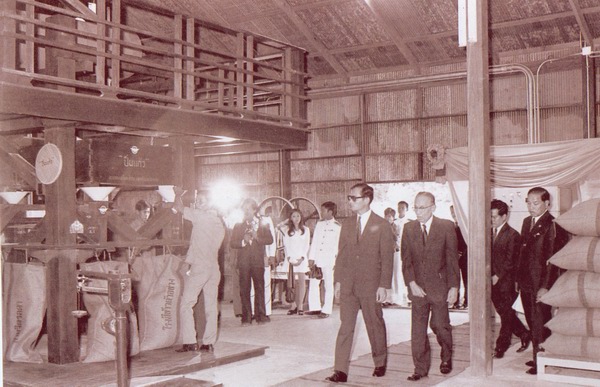
ไม่เพียงการพระราชทานแนวพระราชดำริเท่านั้น
พระบาทสมเด็จพระเจ้าอยู่หัวยังทรงพระราชทาน
โครงการตัวอย่าง ผลการศึกษาวิจัยมากมาย
โดยเฉพาะอย่างยิ่งโครงการส่วนพระองค์
สวนจิตรลดาได้กลายเป็นรากฐานที่สำคัญ
อย่างยิ่งของการพัฒนาพลังงานในปัจจุบัน
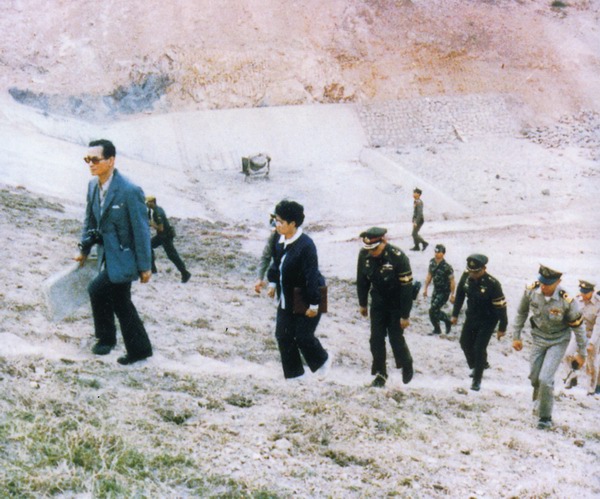
ครั้งหนึ่งพระบาทสมเด็จพระเจ้าอยู่หัวเสด็จฯ สกลนคร พระท่านเก่ง ใช้ปัญญานำ ตอนนั้นเสด็จพระราชดำเนินผ่านถานพระเด็กรุ่นใหม่คงไม่รู้จักถานพระ ไม่ใช่ฐานรองรับพระพุทธรูป แต่หมายถึงห้องน้ำ ส้วม ศัพท์โบราณเรียกว่าถาน ถานพระเรียงกันเป็นแถวพระท่านก็ให้ไปเก็บรวบรวมมาใส่เพื่อต่อท่อมาลงในหลุมก๊าซชีวภาพ แล้วก็ต่อท่อเข้าโรงครัว พระองค์ท่านเสด็จฯ มาถึงก็รับสั่งถามเจ้าอาวาสว่า.. "พระคุณเจ้า...ถานพระที่ใช้ถ่ายของเสียที่ถ่ายออกมาเป็นธรรมะหรือเป็นอธรรม" เจ้าอาวาสก็ตอบว่าเป็นอธรรม พระองค์ท่าก็เสด็จพระราชดำเนินไปตามท่อ ไปถึงบ่อชีวภาพที่กำลังเดือดปุดๆ ตรัสถาม "พระคุณเจ้า ตรงนี้เป็นธรรมะหรืออธรรม" พระคุณเจ้าก็กราบทูลว่า ยังเป็นอธรรมอยู่เพราะเป็นของบูด ของเสีย ของเน่า เมื่อพระองค์ท่านเสร็จพระราชดำเนินต่อไปตามท่อนั้น เข้าไปในครัว ปรากฏว่ากำลังต้มน้ำอยู่ เพื่อจะชงชาถวายพระองค์ท่านก็ตรัสถามอีก... "พระคุณเจ้าตอนนี้เป็นอธรรมหรือธรรมะ" พระคุณเจ้ากราบทูลว่าเป็นธรรมะแล้ว เพราะว่าเกิดประโยชน์ขึ้นแล้ว...
ธรรมะสอนอะไร เรื่องนี้สอนให้คนเราใช้ชีวิตครบวงจร ต้องใช้ให้ครบประโยชน์จึงเกิดขึ้นได้ บริโภคเข้าไป ถ่ายออกมา มีกระบวนการแปรสภาพออกมาเป็นก๊าซนำมาใช้ได้อีก มูลยังอยู่ในบ่อนั้น เมื่อล้างบ่อชีวภาพ มันอาจย่อยสลายไปหมด ก็นำไปใส่เป็นปุ๋ยที่ต้นไม้ ต้นไม้นั้นก็เกิดงอกงาม เป็นพลังงานให้ต้นไม้ ต้นไม้แตกกิ่งก้านสาขา แตกใบออกมาร่วงหล่น ไม้บางอันก็ถูกนำไปเผาเป็นถ่านต่อกันไปไม่รู้จบ เราเรียกกันอย่างง่ายๆ ว่า การพัฒนาอย่างยั่งยืนนั้นเอง...
การทำอะไรให้ยั่งยืนคือการทำให้ครบวงจร ทำอะไรที่เมื่อบริโภคแล้วได้ชดเชยกลับมา เราก็จะมีใช้ไม่รู้จบ นี่คือความหมายสั้นๆ ของคำว่าพัฒนาอย่างยั่งยืน...
พระองค์ท่านรับสั่งว่า "น้ำมันดินหมดแล้ว" คำว่าปิโตรเลียมทรงใช้คำโบราณว่าน้ำมันดิน หมายความว่าขุดลงไปถึงดิน นำมากลั่นใช้ พอน้ำมันดินจะหมดแล้ว จริงๆ แล้วยังมีแหล่งพลังงานอื่นอีกมากมาย แสงแดด สายลม จากธรรมชาติทั้งหมด...
ตอนนี้มาบอกให้ปลูกป่าทั่วประเทศเพื่อทำไบโอดีเซล คิดวันนี้ทำวันนี้ อีก 5 ปีเป็นอย่างเร็วถึงจะได้ใช้น้ำมันปาล์มบริสุทธิ์ใช้แทนน้ำมันดีเซล มีสิทธิบัตรเตรียมการไว้ก่อนแล้ว เอทานอล พระองค์ท่านก็ทรงผลักดันมาก่อน จำได้ว่าวันหนึ่งเมื่อหลายปีก่อน รับสั่งเรียกผมไปสั่งว่า "ไปดูซิ น้ำมันปาล์มนี่ทำดีเซลได้ไหม" จนกระทั้งเวลานี้มีปั๊มแล้ว ถึงจะเป็นโครงการทดลองแต่ก็เติมได้ มีปั๊มขึ้นมาถึง 2 ปั๊มในศูนย์ศึกษาการพัฒนาพิกุลทองที่จังหวัดนราธิวาส และที่มหาวิทยาลัยสงขลานครินทร์...
ถ้าใครติดตามข่าวจะเห็นว่าเมื่อ 2-3 วันมานี้ สมเด็จพระเทพฯ ทรงไปเติมให้เอง รถเมล์วิ่งอยู่ที่หาดใหญ่มาเติมพระองค์ท่านทรงเติมให้เองเลย ได้ข่าวว่ากลับบ้าน สูบน้ำมันออกแล้วตั้งบนโต๊ะบูชา ไม่กล้าใช้ สงสัยใส่เป็นขวดเล็กขวดน้อยแจกเป็นเครื่องรางของขลังไปแล้ว ตอนที่เริ่มวิจัยผมก็ไม่เข้าใจเหมือนกัน เพราะตอนนั้นดีเซลลิตรละไม่กี่บาทพระองค์ท่านรับสั่งว่าทำไปเถอะ แล้วไม่ต้องประกาศให้คนค้านว่าทำแล้วไม่คุ้ม พระองค์ท่านว่าทำไปเถิด แล้วเดี๋ยววันหนึ่งจะรู้เอง แล้ววันนี้ก็มาถึงอย่างรวดเร็ว
น้ำมันแพงทุกวันนี้ แม้กระทั้งน้ำมันพืชก็แพง ต้องยอมรับว่ามีระบบภาษีเข้ามา โครงการพระราชดำริก็เลยมุ่งไปแก้ปัญหาที่คนก่อน ให้เกษตรกรเล็กๆ รวมกลุ่มกัน พื้นที่ไหนเหมาะปลูกปาล์มได้ก็ปลูกปาล์ม พื้นที่ไหนปลูกสบู่ดำได้ก็ปลูกสบู่ดำ มีปลูกพืชเยอะแยะไปหมด แถวชุมพรใช้น้ำมันมะพร้าวกันมาตั้งนานแล้ว แต่เนื่องจากไม่มีเทคโนโลยีเข้าไปช่วยนานๆ ทีก็ต้องเอาเครื่องมาล้างที เพราะมันมีอะไรเข้าไปเกาะเครื่อง แต่อย่างไรก็ตาม ต้องเข้าไป เพื่อให้แต่ละกลุ่มเกษตรกรช่วยตัวเองให้ได้ก่อน สุดท้ายจะช่วยลดการนำเข้าได้ดี"
ดร. สุเมธ ตันติเวชกุล สรุปทิ้งท้ายถึงวิกฤติพลังงานในปัจจุบัน ซึ่งหากดำเนินชีวิตตามแนวพระราชดำริเศรษฐกิจพอเพียงก็จะช่วยแก้ปัญหาดังกล่าวได้ และไม่ใช่แต่เฉพาะสังคมไทยเท่านั้น ยังหมายรวมไปถึงสังคมโลกอีกด้วย

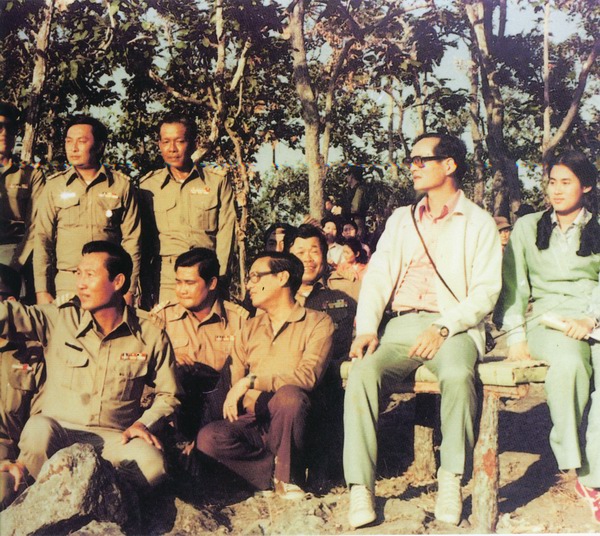
"คุณไปดูเถอะนะ ชีวิตทุกวันนี้มันยุ่ง ต้องเปิดไฟ ต้องเปิดแอร์ แล้วอยู่แค่คนเดียวสองคน ยิ่งโลกสมัยใหม่มีแค่ครอบครัวเล็กๆ เป็นครอบครัวที่ไม่สมบูรณ์ สังคมถึงได้บิดเบี้ยวอยู่ทุกวันนี้ สมัยก่อนนี่ตกเย็นนั่งพร้อมหน้าพร้อมตากัน ปู่ย่าตาทวด พ่อแม่ลูกหลาน นั่งกินข้าวร่วมกัน ได้เรียนรู้ซึ่งกันและกันโดยไม่รู้ตัว ต่างฝ่ายก็ผ่านประสบการณ์ของตัวมาทั้งนั้น ปู่ย่าตาทวดก็เล่าให้ลูกหลานฟัง ถ่ายทอดข่าวสารให้คนแก่รับทราบ เป็นสังคมที่สมบูรณ์มากที่สุด เดี๋ยวนี้มีแต่สังคมกับพ่อแม่ ได้ยินเสียงพ่อแม่จากโทรศัพท์ กลับจากงานดึก งานสังคม ลูกไปนอนแล้ว ไม่เคยพบปะกันเลย ลองถามตัวเองสิครับว่าวันๆ หนึ่งได้เจอลูกบ้างไหม สักกี่ครั้ง กี่นาที ดังนั้นไม่ต้องสงสัยว่าทำไมสังคมถึงปั่นป่วนอยู่ทุกวันนี้ สังคมที่ไม่ได้ใช้ปัญญาเป็นเครื่องนำทางจึงเกิดทุกข์ เพราะฉะนั้นกลับมาเถอะครับ กลับมาหาความสงบ ความเรียบง่าย ชาติบ้านเมืองต้องการการรักษา และต้องรักษาด้วยปัญญา รักษาด้วยสติ รักษาด้วยความเรียบง่าย อะไรที่มันเลยเถิดไปนั้น มันสร้างความทุกข์ให้ทั้งสิ้น
ขอจบท้ายด้วยว่าโลกกำลังโกรธเรา พระบาทสมเด็จพระเจ้าอยู่หัวรับสั่งว่า "เราไปรังแกธรรมชาติมากๆ เข้า เขาจึงสอนเรา" แล้วเวลานี้สอนแล้ว สอนรวดเดียวไม่กี่นาทีห้าแสนชีวิต ดินถล่มที่ฟิลิปปินส์ยังขุดไม่เจออีกพันกว่า ต้นตอทั้งหลายทั้งปวงมาจากการทำร้ายธรรมชาติ โลกเคลื่อนตัวมันก็มีสาเหตุทั้งนั้น ทดลองระเบิดปรมาณู เขาห้ามทดลองในอากาศก็ขุดหลุมลงไปทดลองในทะเล ทดลองในดิน ผลสุดท้ายโลกก็แบกรับภาระจากการกระทำของมนุษย์ เพราะฉะนั้นขอให้เอาสติกลับคืนมา เอาปัญญากลับคืนมา มาสู่โลกของความพอดี เศรษฐกิจพอเพียง...
คำว่าพอเพียงไม่ใช่ขาดแคลน ไม่ใช่ตระหนี่ถี่เหนียว แต่พอด้วยเหตุด้วยผลที่อยากแนะนำให้เราทุกคนแสวงหาคำว่าประโยชน์สุขอยู่ในความร่ำรวยที่ยั่งยืน อยู่ด้วยความสุขอันเป็นเป้าหมายปลายทางของชีวิต แล้วคิดว่าโลกคงจะสงบการทะเลาะเบาะแว้งในบ้านเมืองก็จะลดน้อยถอยลงไป เพราะเราอยู่บนความพอดี ผมขอจบเพียงแค่นี้ และขอให้ทุกคนมีความสุข ขอบคุณครับ"
คำว่าพอเพียงไม่ใช่ขาดแคลน
ไม่ใช่ตระหนี่ถี่เหนี่ยว
แต่พอด้วยเหตุผล
ที่มา : พระบิดาแห่งการพัฒนาพลังงานไทย
โครงการนำพลังงานทดแทนไปใช้งานที่โรงเรียนตำรวจตะเวนชายแดน จังหวัดนครพนม
โครงการนำพลังงานทดแทนไปใช้งานที่โรงเรียนตำรวจตระเวนชายแดน จังหวัดนครพนม
ระบบสูบน้ำบาดาลด้วยไฟฟ้าจากเซลส์แสงอาทิตย์ โดยกรมทรัพยากรธรณี (สนับสนุนโดยกองทุนเพื่อส่งเสริมการอนุรักษ์พลังงาน)
กรมทรัพยากรธรณี ได้นำระบบสูบน้ำบาดาลด้วยเซลล์แสงอาทิตย์มาติดตั้งที่โรงเรียนตำรวจตระเวน ชายแดน (ตชด.) จังหวัดนครพนม ประกอบด้วยเซลล์แสงอาทิตย์ขนาด 1,540 วัตต์ เครื่องแปลงกระแสไฟฟ้า 1 ชุด เครื่องสูบน้ำขนาด 2 แรงม้า จำนวน 1 เครื่อง อุปกรณ์ควบคุม 1 ชุด ถังเก็บน้ำหอถังสูง 12 เมตร ความจุ 12 ลูกบาศก์เมตร จำนวน 1 ถัง ถังกรองสนิมเหล็ก 1 ถัง และระบบท่อน้ำประปา โดยติดตั้ง 2 ระบบ เพื่อใช้ใน 2 พื้นที่ ได้แก่
1. โรงเรียน ตชด. ช่างกลปทุมวันอนุสรณ์ 8 ตั้งอยู่ที่บ้านโนนอุดมดี ตำบลดอนเตย อำเภอนาทม จังหวัดนครพนม ภายใต้โครงการพัฒนาพื้นที่ลุ่มน้ำห้วยบางทรายตอนบนอันเนื่องมาจากพระราชดำริ มีนักเรียน 66 คน ครู 15 คน เดิมใช้น้ำฝนและน้ำจากบ่อน้ำผิวดินเพื่อการอุปโภคบริโภค การเกษตร ปลูกผักสวนครัว และทำอาหารเที่ยงให้นักเรียน แต่มักประสบปัญหาขาดแคลนน้ำในช่วงหน้าแล้ง ทางกรมทรัพยากรธรณีจึงทำการเจาะบ่อบาดาลลึก 53 เมตร ได้น้ำคุณภาพดี 5 ลูกบาศก์เมตรต่อชั่วโมง สำหรับใช้อุปโภคบริโภคและกิจกรรมเกษตรภายในพื้นที่โรงเรียน
2. โรงเรียน ตชด. คอนราดเฮงเคล บ้านท่าสะอาดและบ้านโนนขาม ตำบลนาใน อำเภอโนนสวรรค์ จังหวัดนครพนม เป็นพื้นที่ในโครงการพื้นที่ลุ่มน้ำห้วยบางทรายตอนบนอันเนื่องมาจากพระราช ดำริ มีนักเรียน 61 คน ครู 10 คน กรมทรัพยากรธรณีได้เจาะบ่อบาดาลลึก 52 เมตร ได้น้ำคุณภาพดี 4.5 ลูกบาศก์เมตรต่อชั่วโมง สำหรับใช้อุปโภคบริโภคและกิจกรรมเกษตรภายในพื้นที่โรงเรียนและบ้านพักครู
นอกจากนี้ กองน้ำบาดาล กรมทรัพยากรธรณียังได้เจาะบ่อบาดาลเพิ่มให้อีก 4 บ่อ ด้วยงบประมาณของกรมทรัพยากรธรณี
สำหรับผลของการใช้งานระบบสูบน้ำบาดาลด้วยไฟฟ้าจากเซลล์แสงอาทิตย์ที่ โรงเรียน ตชด.ช่างกลปทุมวันอนุสรณ์ 8 และโรงเรียน ตชด. คอนราดเฮงเคล นั้น คุณศักดิ์ฉลาด ศรีวิชา หัวหน้าศูนย์น้ำบาดาล กรมทรัพยากรธรณี จังหวัดสกลนคร สังกัดฝ่ายพัฒนาน้ำบาดาล 3 ขอนแก่น ได้นำทีมงานเดินทางไปเยี่ยมชมการใช้งานของระบบในทั้งสองพื้นที่พร้อมทั้งให้ ข้อมูลความคิดเห็นที่เป็นประโยชน์ โดยกล่าวถึงการติดตั้งระบบที่โรงเรียน ตชด. ช่างกลปทุมวันอนุสรณ์ 8 เป็นแห่งแรกว่า
"เดิมทีทางโรงเรียนได้รับการสนับสนุนบ่อบาดาลแรกที่ทางช่างกลปทุมวันมา เจาะให้เมื่อประมาณปี '36 เป็นบ่อขนาด 4 นิ้ว ความลึกประมาณ 30 เมตร แล้วก็ลงปั๊มลงไป แต่หลังจากที่ใช้งานไปแล้วพบว่า ค่อนข้างมีปัญหามาตลอด เพราะได้น้ำไม่พอใช้ คาดว่าคงจะเป็นเพราะระดับน้ำลดลง ทำให้น้ำแห้ง กรมทรัพย์ฯ เลยมาแก้ไขให้เมื่อปี '42 คือมาเจาะบ่อบาดาลขนาด 6 นิ้ว ลึก 53 เมตร ซึ่งทำให้ได้ปริมาณน้ำประมาณ 20 แกลลอน หรือ 5 คิวต่อชั่วโมง แต่ตอนแรกระบบที่ทำให้เป็นระบบที่ใช้ไฟฟ้า 220 โวลต์ โรงเรียนจึงต้องมีค่าใช้จ่ายเพิ่มขึ้นเมื่อนำระบบเซลล์แสงอาทิตย์ มาใช้แทนก็ช่วยลดภาระเรื่องค่าไฟฟ้าลงได้มาก"
เมื่อเดินชมจุดติดตั้งระบบสูบน้ำบาดาลด้วยเซลล์แสงอาทิตย์ และพื้นที่ของโรงเรียนซึ่งประกอบด้วยอาคารเรียน โรงครัว พื้นที่เลี้ยงสัตว์ และแปลงเกษตรต่างๆ แล้ว จ.ส.ต. กรกฎ ไกรสิทธุ์ ครูใหญ่ของโรงเรียนได้เล่าถึงผลของการใช้งานระบบให้ฟังว่า "เมื่อก่อนนี้เราสูบน้ำด้วยพลังงานไฟฟ้า น้ำที่ได้ก็ใช้ในโรงเรียน อาคารเรียน ห้องน้ำ เลี้ยงสัตว์แล้วก็แปลงเกษตร ที่นี้พอได้รับโครงการนี้มา ผมก็ให้คณะครูเขาตัดระบบประปาที่ใช้ไฟฟ้าไปเลย แล้วให้ใช้ระบบเซลล์แสงอาทิตย์แทน ระบบใหม่นี้ก็ทำให้เราได้น้ำที่สามารถใช้ได้ตลอด ไม่มีติดขัด ด้านเกษตรก็เพียงพอ แล้วเราก็กำลังจะต่อระบบเพิ่มขึ้นอีก เพราะตอนนี้มีเพียงระบบประปาของโรงเรียนเท่านั้นที่ต่อเข้ากับระบบเซลล์แสง อาทิตย์
"ถ้าเปรียบเทียบกันแล้ว ระบบใหม่นี่ดีกว่าระบบเดิม เพราะว่าน้ำจะแรงกว่า แล้วก็มีมากพอใช้ ระบบเดิมที่ใช้ไฟฟ้าพอใช้ไปนานๆ เครื่องก็จะเสีย น้ำก็ขึ้นไม่เต็มที่ น้ำไม่เพียงพอ ถ้าเราเลี้ยงเป็ดไก่ หรือปลูกผักมากๆ ก็จะไม่พอ"
ส่วนโรงเรียน ตชด. คอนราดเฮงเคล ซึ่งทีมงานได้เดินทางไปถึงเป็นแห่งที่สองนั้น คุณศักดิ์ฉลาดได้ให้ข้อมูลว่า "บ่อบาดาลที่เจาะให้ที่นี่ เป็นบ่อลึก 52 เมตร การผลิตน้ำ 4.5 คิวต่อชั่วโมง ลักษณะของที่นี่ก็คล้ายๆ กับที่โรงเรียน ตชด. ช่างกลปทุมวันฯ คือยังไม่ได้งบประมาณจาก สปช. เหมือนกัน พอได้ระบบนี้มา ก็ช่วยตัดปัญหาค่าไฟออกไป เพราะเดิมใช้ไฟฟ้าสูบน้ำ ซึ่งทางกรมทรัพย์ฯ เราก็คิดว่าจะใช้ 2 โรงเรียนนี้เป็นตัวอย่างของระบบ และเป็นตัวอย่างของเกษตรนำร่องให้เกษตรกรที่สนใจได้เข้ามาดูด้วย"
เมื่อสอบถามถึงผลการใช้งานระบบสูบน้ำบาดาลที่นำมาติดตั้งนี้ ด.ต. อรุณ สร้อยคำ ครูใหญ่โรงเรียน ตชด.คอนราดเฮงเคล กล่าวว่า "เท่าที่ใช้มาระบบก็ไม่มีปัญหาอะไร ดีกว่าแต่ก่อน แต่ก่อนโรงเรียนใช้น้ำจากประปาหมู่บ้านระบบที่มาติดนี่ก็ใช้ภายในโรงเรียน ใช้กับกิจกรรมเกษตร ใช้ดื่ม ใช้อาบ คุณภาพน้ำดี สามารถดื่มได้"
ที่มา : พระบิดาแห่งการพัฒนาพลังงานไทย
โครงการนำพลังงานทดแทนไปใช้งานที่ศูนย์ศึกษาการพัฒนาภูพาน อันเนื่องมาจากพระราชดำริ
โครงการนำพลังงานทดแทนไปใช้งานที่ศูนย์ศึกษาการพัฒนาภูพาน อันเนื่องมาจากพระราชดำริ
ระบบน้ำบาดาลด้วยไฟฟ้าจากเซลล์แสงอาทิตย์ โดยกรมทรัพยากรธรณี (สนับสนุนโดยกองทุนเพื่อส่งเสริมการอนุรักษ์พลังงาน)
กรมพรัพยากรธรณีได้นำระบบสูบน้ำบาดาลด้วยเซลล์แสงอาทิตย์มาติดตั้งที่ศูนย์ฯ ประกอบด้วยเซลล์แสงอาทิตย์ขนาด 1,540 วัตต์ เครื่องแปลงกระแสไฟฟ้า 1 ชุด เครื่องสูบน้ำขนาด 2 แรงม้า จำนวน 1 เครื่อง อุปกรณ์ควบคุม 1 ชุด หอถังเก็บน้ำสูง 12 เมตร ความจุ 12 ลูกบาศก์เมตร จำนวน 1 ถัง ถังกรองสนิมเหล็ก 1 ถัง และระบบท่อส่งน้ำประปา โดยติดตั้ง 2 ระบบเพื่อใช้ใน 2 พื้นที่ ได้แก่
1. พื้นที่ศูนย์ ซึ่งมีความต้องการน้ำเพื่อการอุปโภคและบริโภค โดยแต่เดิมใช้เครื่องสูบน้ำด้วยมอเตอร์ ขนาด 1 แรงม้า สูบน้ำจากอ่างเก็บน้ำที่อยู่ห่างจากอาคารอำนวยการไปประมาณ 200 เมตร และมักประสบปัญหาขาดแคลนน้ำในช่วงฤดูแล้ง จึงทำการเจาะบ่อน้ำบาดาลลึก 66 เมตร และสูบน้ำด้วย ไฟฟ้าจากเซลล์แสงอาทิตย์ ได้น้ำคุณภาพดี 4.54 ลูกบาศก์เมตรต่อชั่วโมง สำหรับใช้กับอาคารต่างๆ ภายในศูนย์ฯ บ้านพักรับรอง และกิจกรรมการเกษตรใกล้เคียงได้
2. งานปศุสัตว์ เดิมสูบน้ำจากอ่างเก็บน้ำที่อยู่ห่างไป 2 กิโลเมตร ผ่านท่อพีวีซีด้วยแรงโน้มถ่วงแต่เนื่องจากระบบกรองน้ำมีคุณภาพต่ำจึงได้น้ำค่อนข้างขุ่น กรมทรัพยากรธรณีจึงได้ทำการเจาะบ่อ บาดาลลึก 42 เมตร และสูบน้ำด้วยไฟฟ้าจากเซลล์แสงอาทิตย์ ได้น้ำคุณภาพดี 4.54 ลูกบาศก์เมตรต่อชั่วโมง สำหรับใช้ในงานปศุสัตว์และแปลงเกษตรทฤษฎีใหม่อันเนื่องมาจากพระราชดำริที่อยู่ใกล้เคียง
นอกจากนี้ กองน้ำบาดาล กรมทรัพยากรธรณี ยังได้เจาะบ่อบาดาลเพิ่มให้อีก 2 บ่อ ด้วยงบประมาณของกรมทรัพยากรธรณี
ระบบสูบน้ำประปาหมู่บ้านด้วยไฟฟ้าจากเซลล์แสงอาทิตย์ที่ศูนย์ประสานงานโครงการพัฒนาพื้นที่ห้วยทรายตอนบนอันเนื่องมาจากพระราชดำริจังหวัดมุกดาหารโดยกรมโยธาธิการ (สนับสนุนโดยกองทุนเพื่อส่งเสริมการอนุรักษ์พลังงาน)
กรมโยธาธิการได้เข้าไปสำรวจและออกแบบเอติดตั้งระบบสูบน้ำด้วยไฟฟ้าจากเซลล์แสงอาทิตย์เพื่อใช้ในการอุปโภคบริโภคและกิจกรรมการเกษตรภายในพื้นที่ของศูนย์ประสานงานโครงการพัฒนาพื้นที่ห้วยบางทรายตอนบนฯ จังหวัดมุกดาหาร เป็นระบบที่ประกอบด้วยเซลล์แสงอาทิตย์ขนาด 3,500 วัตต์ เครื่องสูบน้ำมอเตอร์กระแสสลับ 2 เครื่อง เครื่องแปลงกระแสไฟฟ้า 2 ชุด ชุดควบคุม 2 ชุด และท่อส่งน้ำขนาดเส้นผ่านศูนย์กลาง 2.5 นิ้ว จำนวน 2 ท่อ โดยเครื่องสูบน้ำจะทำงานในเวลากลางวันด้วยไฟฟ้าจากเซลล์แสงอาทิตย์ สูบน้ำจากอ่างเก็บน้ำห้วยพุงได้ประมาณ 80 ลูกบาศก์เมตรต่อวัน ส่งผ่านท่อที่มีระยะยกน้ำสูง 50 เมตร ระยะทาง 2,300 เมตร ขึ้นไปเก็บไว้ในหอถังสูงที่มีอยู่เดิมในพื้นที่ สำหรับให้น้ำแก่พื้นที่เกษตรกรรมต่างๆ ของศูนย์ฯ และใช้เพื่อการอุปโภคบริโภคและการเกษตร โดยโครงการนี้ได้รับความร่วมมือจากกองกำกับการ ตชด. 23 ค่ายศรีสกุลวงศ์
ระบบผลิตไฟฟ้าด้วยเซลล์แสงอาทิตย์เชื่อมต่อสายส่งโดยการไฟฟ้าฝ่ายผลิตแห่งประเทศ (สนับสนุนโดยกองทุนเพื่อส่งเสริมการอนุรักษ์พลังงาน)
ระบบผลิตไฟฟ้าด้วยเซลล์แสงอาทิตย์เชื่อมต่อสายส่งนี้ติดตั้งที่อาคารสำนักงาน ประกอบด้วยเซลล์แสงอาทิตย์ขนาด 2,100 วัตต์ อุปกรณ์ควบคุม 1 ชุด เครื่องแปลงกระแสไฟฟ้า 1 ชุด และวัตต์มิเตอร์แสดงผลการผลิตไฟฟ้า 1 ชุดในเวลาที่มีแสงอาทิตย์ เซลล์แสงอาทิตย์จะทำหน้าที่เปลี่ยน พลังงานแสงเป็นพลังงานไฟฟ้ากระแสตรง จากการออกแบบระบบจะให้ไฟฟ้ากระแสตรงขนาดแรงดัน 220-240 โวลต์ และกระแสไฟฟ้า 6-8 แอมแปร์ ไฟฟ้ากระแสตรงที่ผลิตได้จะไหลผ่านเครื่องแปลงกระแสไฟฟ้าและถูกเปลี่ยนเป็นไฟฟ้ากระแสสลับ ที่มีแรงดัน 220 โวลต์ และมีคุณสมบัติเหมือนกับ กระแสไฟฟ้าในระบบไฟฟ้าที่มีอยู่เดิม ดังนั้น กระแสไฟฟ้าที่ผลิตได้จากระบบนี้จึงสามารถใช้ได้กับ เครื่องใช้ไฟฟ้าที่มี อยู่ทุกชนิดโดยในกรณีที่มีกระแสไฟฟ้าที่ผลิตได้จากเซลล์แสงอาทิตย์มีมากกว่าความต้องการใช้ไฟฟ้าในขณะนั้นกระแสไฟฟ้าส่วนเกินจะถูกขายคืนเข้าในระบบสายส่งของการไฟฟ้าฯ ในทางกลับกันหากความต้องการใช้กระแสไฟฟ้าในขณะนั้นมีมากกว่ากระแสไฟฟ้าที่ผลิตได้ กระแสไฟฟ้าส่วนที่ขาดก็จะถูกซื้อเสริมเข้ามาจากระบบสายส่งของการไฟฟ้าฯ ตามปกติ ซึ่งการทำงานของระบบได้รับการออกแบบให้เป็นการทำงานแบบอัตโนมัติ ดังนั้นจึงไม่ต้องมีการปิด-เปิดระบบแต่อย่างใดในแต่ละวัน
ผลจากการติดตั้งระบบ ทำให้ปริมาณกระแสไฟฟ้าที่ซื้อจากระบบสายส่งของการไฟฟ้าฯลดลง เท่ากับปริมาณกระแสไฟฟ้าที่ผลิตได้จากระบบเซลล์แสงอาทิตย์ซึ่งเท่ากับว่าจะสามารถช่วยลดการใช้เชื้อเพลิงบรรพชีวินเช่น น้ำมัน ก๊าซธรรมชาติ หรือถ่านหิน ในการผลิตกระแสไฟฟ้าลง อันจะส่งผลให้มลพิษที่เกิดจากการเผาไหม้เชื้อเพลิงดังกล่าวลดลงได้อีกทางหนึ่ง
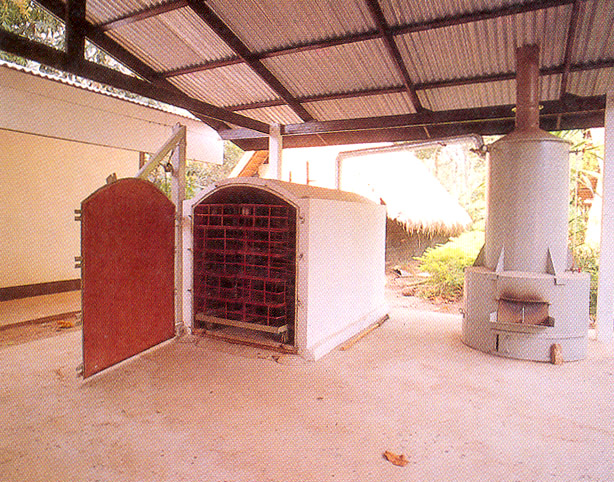
โดยกรมพัฒนาและส่งเสริมพลังงาน (สนับสนุนโดยกองทุนเพื่อส่งเสริมการอนุรักษ์พลังงาน)
เตานึ่งก้อนเชื้อเห็ดประสิทธิภาพสูง ใช้สำหรับนึ่งก้อนเชื้อเห็ดที่อยู่ภายในถุงพลาสติกเพื่อฆ่าเชื้อปนเปื้อนต่างฟ ก่อนที่จะนำไปทำการเพาะเห็ด ประกอบด้วยเตาซึ่งเป็นเป็นเตาฟืนชนิดมีตะแกรงรังผึ้ง ขนาดห้องเผาไหม้ 0.18 ลูกบบาศก์เมตร ทำด้วยวัสดุทนไฟและเก็บความร้อนได้ดี หม้อต้มไอน้ำเป็นชนิดมีท่อไฟในตัว ขนาดบรรจุ 230 ลิตร ทำด้วยวัสดุที่นำความร้อนได้ดี ตู้อบก้อนเชื้อเห็บ ขนาดความจุ 2.4 ลูกบาศก์เมตร ผิวด้านนอกหุ้มด้วยฉนวนเพื่อลดการสูญเสียความร้อนพร้อมอุปกรณ์วัดความดันและควบคุมความดันอย่างละ 1 ชุด จากการออกแบบตามหลักวิชาการดังกล่าวทำให้มีประสิทธิภาพเชิงความร้อนของเตามีค่าประมาณร้อยละ 33 และประหยัดไม้ฟืนได้ประมาณร้อยละ 49 เมื่อเปรียบเทียบกับเตารูปแบบเดิมที่มีการใช้อยู่ในศูนย์ และสะดวกในการใช้งาน
การทำงานของเตานึ่งก้อนเชื้อเห็ดประสิทธิภาพสูง คือ ไอน้ำจากหม้อต้มไอน้ำจะถูกดันเข้าไปยังตู้อบจนกระทั่งอุณหภูมิในตู้อบเท่ากับ 95-100 องศาเซลเซียส ทำการอบต่อไปอีก 1 ชั่วโมง 30 นาที แล้วปล่อยให้เย็นก่อนนำไปใช้เพาะเห็ด
เครื่องสกัดสารจำกัดศัตรูพืชด้วยพลังงานแสงอาทิตย์ โดยการไฟฟ้าฝ่ายผลิตแห่งประเทศไทย
เครื่องสกัดสารกำจัดศัตรูพืชด้วยพลังงานแสงอาทิตย์ เป็นการนำพลังงานแสงอาทิตย์มาใช้ประโยชน์ในการต้มสกัดสารชีวภาพ ซึ่งมีอยู่ในสมุนไพรบางชนิด เช่น ตะไคร้ หอม สะเดา ข่า เป็นต้น อุปกรณ์นี้ประกอบด้วยแผงรับพลังงานแสงอาทิตย์ ถังสกัดสาร ไส้กรอง ท่อน้ำเข้าถังและเข้าแผง วาล์วเช็คระดับน้ำและขาตั้งรองรับแผงและถังสกัดสาร
การทำงานจะเริ่มต้นขึ้นเมื่อแสงอาทิตย์ตกกระทบแผงรับแสงอาทิตย์ ซึ่งถูกออกแบบการวางให้ด้านหนึ่งเอียงขึ้น เพื่อให้การทำงานของระบบเป็นไปอย่างสมบูรณ์ พลังงานความร้อนจากแสงอาทิตย์จะถูกดูดซับและส่งถ่ายความร้อนให้กับน้ำที่อยู่ในระบบ เมื่อน้ำเริ่มร้อนก็จะเกิดการเคลื่อนที่ไปยังด้านบนของแผงผ่านไปตามท่อที่หุ้มไว้ด้วยฉนวนเข้าไปทางด้านบนของถังสกัดสารกำจัดศัตรูพืชหรือหม้อต้มซึ่งใส่สมุนไพรไว้ ทำให้น้ำที่อยู่ส่วนล่างของหม้อต้มก็จะไหลไปตามท่อหุ้มฉนวนเข้าไปในระบบทางอีกด้านหนึ่งของแผง การไหลเวียนของน้ำนี้จะเป็น ระบบไหลเวียนตามธรรมชาติ ซึ่งจะเกิดขึ้นตลอดเวลาที่แผงได้รับแสงอาทิตย์ จะทำให้น้ำในหม้อต้มจะมีอุณหภูมิสูงขึ้นเรื่อยๆ จนถึงประมาณ 90 องศาเซลเซียส ทำให้สารสกัดชีวภาพในพืชสมุนไพรถูกสกัดออกมาละลายอยู่ในน้ำ ในแต่ละวันการสกัดจะเกิดขึ้นอย่างต่อเนื่องเป็นเวลาวันละ 6-8 ชั่วโมง ทำให้เกษตรกรมีน้ำสารสกัดไว้ใช้งานได้วันละ 75-100 ลิตร ซึ่งสามารถช่วยลดค่าใช้จ่ายด้านเชื้อเพลิงและลดภาระการต้มสกัดสารได้เป็นอย่างดี นอกจากนี้การใช้สารสกัดชีวภาพฉีดพ่นพืชผักแทนการใช้ยาปราบศัตรูพืชที่เป็นสารเคมี ยังให้ความปลอดภัยทั้งเกษตรกรและผู้บริโภค อีกทั้งยังช่วยรักษาสิ่งแวดล้อมและลดการนำเข้ายาปราบศัตรูพืชจากต่างประเทศอีกด้วย
เครื่องวัดพลังงานแสงอาทิตย์ โดยมหาวิทยาลัยเทคโนโลยีพระจอมเกล้าธนบุรี
เครื่องวัดพลังงานแสงอาทิตย์ ประกอบด้วย 2 ส่วน ได้แก่
1. ส่วนเซนเซอร์หรือไพรานอมิเตอร์ ประกอบด้วยเซลล์แสงอาทิตย์ชนิดผลึกซิลิคคอนขนาด 1 ตารางเซนติเมตร และขั้วของเซลล์และอาทิตย์
2. ส่วนอินติเกรตสัญญาณ ทำหน้าที่แสดงผลและอินติเกรตค่าความเข้มรังสีดวงอาทิตย์เป็นพลังงาน
ประโยชน์ของเครื่องวัดพลังงานแสงอาทิตย์ คือสามารถวัดค่าพลังงานแสงอาทิตย์ในช่วงเวลาต่างๆ ซึ่งทำให้ทราบประสิทธิภาพการทำงานของระบบพลังงานทดแทนที่ใช้พลังงานแสงอาทิตย์ อันเป็นประโยชน์ต่อการพัฒนาระบบและอุปกรณ์ต่างๆ ในอนาคตได้
ชุดกรองน้ำดื่มระบบรีเวิร์สออสโมซิสทำงานด้วยไฟฟ้าจากเซลล์แสงอาทิตย์ โดยมหาวิทยาลัยเทคโนโลยีพระจอมเกล้าธนบุรี
ระบบไฟฟ้าแสงสว่างด้วยเซลล์แสงอาทิตย์ประกอบด้วยเซลล์แสงอาทิตย์ขนาด 75 วัตต์ จำนวน 3 แผง รวมเป็น 225 วัตต์ อุปกรณ์ควบคุมบริเวณศาลาทรงงาน ขนาด 12 โวลต์ 6 แอมแปร์ จำนวน 1 ชุด อุปกรณ์ควบคุม บริเวณโรงเลี้ยงไก่ ขนาด 12 โวลต์ 10 แอมแปร์ จำนวน 1 ชุด แบตเตอรี่ชนิดเจล ขนาด 6 โวลต์ 150 แอมแปร์ชั่วโมง จำนวน 4 ลูก หลอดไฟประหยัดพลังงาน ขนาด 12 โวลต์ 7 วัตต์ จำนวน 9 หลอด และหลอดไฟประหยัดพลังงาน ขนาด 12 โวลต์ 11 วัตต์ จำนวน 6 หลอด โดยติดตั้งระบบดังกล่าวไว้ในบริเวณสวนสมเด็จฯ 2 จุด ด้วยกัน คือ ที่ศาลาทรงงาน และที่โรงเลี้ยงไก่ ทั้ง 2 จุดนี้สามารถใช้งานได้ 4 ชั่วโมง คือ เปิดทำงานโดยอัตโนมัติตอนช่วงหัวค่ำ 3 ชั่วโมง และจะทำงานอีกครั้งในช่วงเช้ามืดอีก 1 ชั่วโมง (การทำงานโดยอัตโนมัติเป็นผลมาจากการทำงานของอุปกรณ์ควบคุมการปรับกระแสไฟฟ้า)
ชุดกรองน้ำดื่มระบบรีเวิร์สออสโมซิสเป็นเครื่องฟอกน้ำจืด น้ำกร่อย หรือ น้ำทะเลให้เป็นน้ำจืดบริสุทธิ์ โดยมีหลักในการทำงาน คือ ใช้เยื่อเมมเบรน (membrane) ซึ่งเป็นเยื่อบางๆ คล้ายแผ่นกระดาษแต่มีเนื้อละเอียดถึง 0.0001 ไมครอน ทำให้โมเลกุลของสารละลายในน้ำไม่สามารถลอดผ่านไปได้ โดยเยื้อเมมเบรนจะทำงานควบคู่กับเครื่องสูบน้ำแรงดันสูงที่ทำหน้าที่ผลักดันน้ำดิบให้ผ่านเยื่อเมมเบรนเครื่องสูบน้ำดังกล่าวทำงานด้วยไฟฟ้าที่ผลิตจากเซลล์แสงอาทิตย์
ระบบที่นำมาติดตั้งนี้ประกอบด้วยแผงเซลล์แสงอาทิตย์ขนาด 60 วัตต์ แบตเตอรี่ขนาด 624 วัตต์ต่อชั่วโมง ชุดควบคุม และเครื่องสูบน้ำแรงดันสูง โดยการทำงานจะเริ่มจากการเปิดวาล์วให้น้ำดิบเข้าสู่ระบบไฟฟ้าจากเซลล์แสงอาทิตย์จะเดินเครื่องสูบน้ำให้ทำงานเพื่อเพิ่มความดันให้น้ำดิบ อัดน้ำผ่านส่วนไส้กรองคาร์บอนทั้งชนิดเม็ดและชนิดผง ส่วนเยื่อกรองเมมเบรน และส่วนไส้กรองคาร์บอนอันสุดท้ายจนได้เป็นน้ำบริสุทธิ์
ชุดแสงไฟล่อแมลงด้วยเซลล์แสงอาทิตย์ โดยบริษัท สยามโซลาร์ แอนด์ อีเลคทรอนิคส์ จำกัด
แต่เดิมที่ศูนย์ศึกษาการพัฒนาพิกุลทองฯ ยังไม่มีเครื่องล่อแมลงที่จะใช้กำจัดแมลงบางชนิดที่เป็นศูนย์พืช จึงได้นำชุดแสงไฟล่อแมลงด้วยเซลล์แสงอาทิตย์มาติดตั้งภายในบริเวณศูนย์ฯ อุปกรณ์ชนิดนี้ประกอบด้วยเซลล์แสงอาทิตย์ขนาด 10 วัตต์ จำนวน 1 แผง หลอดไฟฟลูออเรสเซนต์ 6 วัตต์ จำนวน 1 ชุด แบตเตอรี่ขนาด 12 โวลต์ 4 แอมแปร์ชั่วโมง จำนวน 1 ลูก เซนเซอร์วัดความสว่าง 1 ชุด ชุดตั้งเวลาการทำงานของหลอดไฟกับพัดลม 1 ชุด พัดลมขนาด 2 นิ้ว 1 เครื่องชุดแสดงผลความจุแบตเตอรี่ 1 ชุด ถุงผ้าดักแมลง 1 ถุง และขาตั้งแบบเคลื่อนย้ายได้ 1 ชุด
เซลล์แสงอาทิตย์จะประจุกระแสไฟฟ้าลงในแบตเตอรี่ในเวลากลางวัน เมื่อดวงอาทิตย์ตกดิน เซนเซอร์วัดความสว่างจะสั่งให้หลอดไฟสว่างและพัดลมหมุนเป็นเวลา 2 ชั่วโมง เพราะโดยปกติแมลงจะออกมาเล่นไฟประมาณ 2 ชั่วโมง โดยในขณะที่หลอดไฟสว่างและพัดลมหมุนนั้น หากมีแมลงบินเข้าใกล้ก็จะถูกดูดให้ตกลงไปในถุง และแมลงที่ได้นี้สามารถนำไปใช้เลี้ยงปลาได้ นอกจากนี้ ชุดแสงไฟล่อแมลงยังสามารถติดตั้งไว้กลางบ่อเลี้ยงปลาเพื่อให้แมลงตกลงไปในบ่อปลาโดยตรงได้ด้วย
ระบบเครื่องขยายเสียงพลังงานแสงอาทิตย์ โดยบริษัท โซลาร์ตรอน จำกัด
ระบบประกอบด้วยแผงเซลล์แสงอาทิตย์ขนาด 6 วัตต์ 12 โวลต์ 0.3 แอมแปร์ จำนวน 1 แผง แบตเตอรี่แบบ sealed lead acid ขนาด 12 โวลต์ 0.7 แอมแปร์ จำนวน 1 ลูก และเครื่องขยายเสียง พร้อมไมโครโฟนแบบมีสายและแบบไร้สาย จำนวน 1 ชุด ชุดเครื่องขยายเสียงถูกดัดแปลงให้สามารถใช้ได้ทั้งไฟฟ้ากระแสตรงและไฟฟ้ากระแสสลับ มีขนาดกำลังขยาย 50 วัตต์ โดยสามารถใช้งานได้ทั้งไมโครโฟนแบบมีสายและแบบไร้สายซึ่งใช้กระแสไฟฟ้าขนาด 0.5 แอมแปร์ และสามารถใช้งานติดต่อกันเป็นเวลา 3 ชั่วโมงต่อวัน เหมาะสำหรับการใช้งานในภาคสนามและเลือกใช้ตามความเหมาะสมได้อีกด้วย
คุณเสน่ห์ แก้วบุญเรือง ผู้อำนวยการศูนย์ศึกษาการพัฒนาภูพาน อันเนื่องมาจากพระราชดำริ ได้แสดงความเห็นเกี่ยวกับการนำโครงการพลังงานทดแทนมาใช้งานภายในศูนย์การพัฒนาภูพานฯ ดังนี้
ผลของโครงการระบบพลังงานทดแทนที่ติดตั้งภายในศูนย์ฯ
คุณเสน่ห์ : "ระบบหลักที่ติดตั้งในศูนย์ฯ เป็นระบบสูนน้ำด้วยเซลล์แสงอาทิตย์ ซึ่งที่ศูนย์ฯ เรามีอ่างเก็บน้ำอยู่ 2 ตัว แต่เพราะเรามีกิจกรรมต่างๆ มากมาย น้ำจึงไม่เพียงพอ เพราะส่วนหนึ่งเราต้องส่งไปใช้ในกิจกรรมต่างๆ ทั้งปศุสัตว์และการเกษตร แปลงทดสอบทดลองต่างๆ อีกส่วนก็เป็นน้ำสำหรับอุปโภคบริโภคซึ่งต้องผ่านระบบกรองของประชาชนมาใช้ในส่วนของอาคารต่างๆ ในศูนย์ และบ้านพัก ซึ่งบางปีถ้าน้ำในอ่างไม่มากก็ไม่เพียงพอ พอได้ระบบสูบน้ำบาดาลด้วยเซลล์แสงอาทิตย์มาช่วยก็รู้สึกว่าดีขึ้นประหยัดน้ำลงได้ส่วนหนึ่ง และน้ำที่สูบขึ้นมาก็มีคุณภาพดี สะอาด ทำให้ไม่มีปัญหาเรื่องน้ำขาดแคลนสำหรับน้ำอาบน้ำกินในศูนย์ฯ
"สำหรับปัญหาของระบบนี้ก็มีบ้าง อย่างครั้งแรกที่เจาะลงไปลึกประมาณ 60 เมตร ปรากฏว่าไม่เจอน้ำ เจอแต่หินเจอแต่อะไรต่างๆ ก็ถอย ก็มาเจาะที่บ่อสอง ห่างประมาณ 200 เมตร เจาะลงไปไม่ถึง 40 เมตร ก็ได้น้ำสะอาด"
ที่มา : พระบิดาแห่งการพัฒนาพลังงานไทย
โครงการนำพลังงานทดแทนไปใช้งานที่ศุนย์อนุรักษ์ช้างไทย จ.ลำปาง
โครงการนำพลังงานทดแทนไปใช้งานที่ศูนย์อนุรักษ์ช้างไทย จ.ลำปาง
ระบบผลิตก๊าซชีวภาพ จากมูลช้าง โดยกรมพัฒนาและส่งเสริมพลังงาน (สนับสนุนโดยกองทุนเพื่อส่งเสริมการอนุรักษ์พลังงาน)
โรงช้างต้น ซึ่งมีช้างสำคัญ 6 เชือก มีมูลช้างประมาณวันละ 250-300 กิโลกรัม และไม่เคยนำมูลช้างปริมาณมากเช่นนี้ไปใช้ประโยชน์ ดังนั้นโครงการเฉลิมพระเกียรติฯ จึงได้ติดตั้งระบบผลิตก๊าซชีวภาพ เพื่อใช้ประโยชน์จากมูลช้าง โดยจะไม่มีผลกระทบต่อสิ่งแวดล้อม และยังได้พลังงานในรูปของก๊าซชีวภาพ เป็นผลพลอยได้ที่สำคัญอีก ระบบฯดังหล่าวประกอบด้วยบ่อเติมมูล บ่อหมักมูลแบบโดมคงที่ขนาด 50 ลูกบาศก์เมตร จำนวน 1 บ่อ บ่อมูลล้น และลานตากมูลล้าน
การทำงานของระบบจะเริ่มต้นโดยการนำมูลช้างและน้ำมาผสมเป็นเนื้อเดียวกัน ที่บ่อเติมมูลแล้วปล่อยลงสู่บ่อหมัก เพื่อให้เกิดการย่อยสลายโดยแบคทีเรียชนิดไม่ใช้ออกซิเจน และได้ก๊าซชีวภาพ ประมาณวันละ 15-20 ลูกบาศก์เมตร องค์ประกอบหลักเป็นก๊าซมีเทน นำไปใช้เป็นเชื้อเพลิงในการหุงต้มอาหารและเดินเครื่องยนต์สูบน้ำเพื่อการ เกษตร ส่วนมูลที่ถูกย่อยสลายแล้วจะไหลลงสู่บ่อมูลล้น เข้าลานตากมูลเพื่อนำไปทำปุ๋ยบำรุงดิน หรืออัดเป็นแท่งเพาะชำต่อไป
นอกจากนี้ โครงการฯ ยังได้นำระบบผลิตก๊าซชีวภาพดังหล่าวมาใช้ ณ โรงเลี้งช้าง ซึ่งมีช้างสำหรับลานแสดงจำนวน 47 เชือก สามารถเก็บมูลได้ประมาณวันละ 1,500-2,000 กิโลกรัม โดยใช้ระบบบ่อหมักแบบโดมคงที่ขนาด 100 ลูกบาศก์เมตร จำนวน 2 บ่อ ซึ่งสามารถผลิตก๊าซชีวภาพได้ประมาณวันละ 75-100 ลูกบาศก์เมตร ก๊าซที่ได้นำไปใช้เป็นเชื้อเพลิงในการหุงต้มอาหาร และเดินเครื่องยนต์เพื่อผลิตกระแสไฟฟ้า ส่วนมูลที่ย่อยสลายแล้วก็นำไปเป็นปุ๋ยบำรุงดินเช่นกัน
ระบบผลิตไฟฟ้าด้วยเซลส์แสงอาทิตย์เพื่อแสงสว่างแบบแยกตามบ้าน โดยกรมพัฒนาและส่งเสริมพลังงาน (สนับสนุนโดยกองทุนเพื่อส่งเสริมการอนุรักษ์พลังงาน)
โรงเรียนฝึกควาญช้างที่อยู่ทางด้านหลังของศูนย์ฯ ยังไม่มีไฟฟ้าเข้าถึง จึงต้องใช้ตะเกียงน้ำมันก๊าดเพื่อแสงสว่าง ในเรือนโรงเรียน 1 หลัง และบ้านพัก 2 หลัง
ดังนั้น โครงการฯ จึงได้นำระบบผลิตไฟฟ้าด้วยเซลส์แสงอาทิตย์เพื่อแสงสว่างแบบแยกตามบ้านจำนวน 4 ระบบ ไปติดตั้งให้เรือนโรงเรียน 2 ระบบ และบ้านพักหลังละ 1 ระบบ ซึ่งแต่ละระบบประกอบด้วยแผงเซลส์แสงอาทิตย์ขนาด 75 วัตต์ จำนวน 2 แผง ติดตั้งบนเสาเหล็กอาบสังกะสีสูง 3 เมตร แบตเตอรี่ขนาด 100 แอมแปร์ชั่วโมง 12 โวลต์ จำนวน 2 ลูก อุปกรณ์ควบคุมการประจุแบตเตอรี่ 1 ชุด ขนาด 2 แอมแปร์ 12 โวลต์ และหลอดไฟฟ้าฟลูออเรสเซนต์ขนาด 18 วัตต์ จำนวน 4 หลอด ขั้นตอนการทำงานของระบบ คือ เวลากลางวันที่มีแสงแดด เซลส์แสงอาทิตย์ จะประจุไฟฟ้าลงในแบตเตอรี่เพื่อเก็บไว้ใช้ในเวลากลางคืน พลังงานไฟฟ้าที่ผลิตได้ ของแต่ละระบบประมาณ 450-520 วัตต์ชั่วโมงต่อวัน เป็นพลังงานไฟฟ้ากระแสตรงที่สามารถใช้กับหลอดไฟฟลูออเรสเซนต์เพื่อแสงสว่าง ทั้ง 4 หลอด ได้ประมาณวันละ 5 ชั่วไมง และยังสามารถนำไปใช้กับอุปกรณ์โสตทัศน์ที่ใช้กระแสไฟฟ้ากระแสตรง เช่น เครื่องขยายเสียง วิทยุเทป และโทรทัศน์ เป็นต้น
ระบบสูบน้ำบาดาลด้วยไฟฟ้าจากเซลส์แสงอาทิตย์ โดยกรมทรัพยากรธรณี (สนับสนุนโดยกองทุนเพื่อส่งเสริมการอนุรักษ์พลังงาน)
เนื่องจากศูนย์อนุรักษ์ช้างไทยมีน้ำผิวดินจำกัดและประสบปัญหาขาดแคลนใน ช่วงหน้าแล้ง ซึ่งแต่เดิมมีการสูบน้ำด้วยไฟฟ้าจากบ่อเปิด หรือใช้รถบรรทุกน้ำจากบ่อบาดาลระดับตื้นโดยใช้ระบบมือโยกมาใช้ กรมทรัพยากรธรณีจึงนำระบบสูบน้ำบาดาลด้วยเซลส์แสงอาทิตย์ ประกอบด้วยเซลส์แสงอาทิตย์ขนาด 1,540 วัตต์ เครื่องแปลงกระแสไฟฟ้า 1 ชุด เครื่องสูบน้ำขนาด 2 แรงม้า จำนวน 1 เครื่อง อุปกรณ์ควบคุม 1 ชุด ถังเก็บน้ำหอถังสูง 12 เมตร ความจุ 12 ลูกบาศก์เมตร จำนวน 1 ถัง ถังกรองสนิมเหล็ก 1 ถัง และระบบท่อส่งน้ำประปา มาติดตั้งที่ โรงเรียนฝึกควาญช้างโดย เครื่องสูบน้ำจะทำงานด้วยไฟฟ้าจากเซลส์แสงอาทิตย์ในเวลากลางวัน เพื่อสูบน้ำไปเก็บในหอถังสูง แล้วใช้แรงโน้มถ่วงในการส่งน้ำผ่านท่อน้ำ ซึ่งระบบดังกล่าว สามารถสูบน้ำได้ 8,452 ลูกบาศก์เมตรต่อปี
นอกจากระบบสูบน้ำบาดาลด้วยเซลส์แสงอาทิตย์แล้ว กรมทรัพยากรธรณียังดำเนินการเจาะบ่อน้ำบาดาลโดยไม่ใช่เซลส์แสงอาทิตย์ ในพื้นที่ 3 แห่งของศูนย์ฯ คือ
1.บริเวณหน้าศูนย์อำนวยการ จำนวน 2 บ่อ
2.บริเวณปากทางเข้าศูนย์ฯ หรือบริเวณโรงช้างต้นจำนวน 2 บ่อ โดยเจาะที่ 70 เมตร และ 130 เมตร และติดตั้งมอเตอร์ไฟฟ้าขนาด 0.5 แรงม้า และ 2 แรงม้า ตามลำดับ บ่อดังกล่าวได้น้ำช่วง 30-40 เมตร ปริมาณ 2 ลูกบาศก์เมตร และ 7 ลูกบาศก์เมตร
3.สวนป่าทุ่งเกวียนจำนวน 1 บ่อ
คุณนิปกรณ์ สิงหพุทธางกูร หัวหน้าโครงการอนุรักษ์ช้างไทย ได้ให้สัมภาษณ์และแสดงความคิดเห็นเกี่ยวกับระบบพลังงานทดแทนที่นำมาติดตั้ง ในศูนย์อนุรักษ์ช้างไทยไว้อย่างน่าสนใจ โดยมีรายละเอียดดังต่อไปนี้
ลักษณะการใช้นำระบบพลังงานทดแทนมาใช้ในศูนย์ฯ เป็นไปในลักษณะใด
คุณนิปกรณ์ : "ที่นี่จริงๆ แล้วก็มีไฟฟ้าเข้าถึง แต่ว่าไฟฟ้าจะค่อนข้างตก เพราะเป็นแค่สายไฟฟ้าสองสาย ซึ่งไฟสองสายนี่ถ้าพูดไป จะใช้ในกิจกรรมดำเนินงานของตัวศูนย์ฯ เองก็ไม่เพียงพออยู่แล้วระบบพลังงานทดแทนที่เข้ามาเสริมก็ช่วยให้ได้ ประโยชน์อีกเยอะอย่างระบบผลิตไฟฟ้าแสงสว่างด้วยเซลล์แสงอาทิตย์ไม่เพียงแต่ จะทำให้เจ้าหน้าที่และควาญช้างในหมู่บ้านมีไฟฟ้าแสงสว่างใช้ แต่ยังทำให้ความรู้สึก ความคุ้นเคยเดิมของควาญช้าง ที่เมื่อก่อนเขาเคยอยู่หมู่บ้านที่ห่างไกลและไม่มีไฟฟ้าใช้อยู่แล้ว ระบบนี้ก็เป็นเหมือนนิมิตหมายใหม่ที่ดีอย่างหนึ่งคือ เหมือนกับเขาได้กลับเข้าสู่บรรยากาศเดิมๆ และได้ใช้ไฟจากธรรมชาติจริงๆ
"แล้วที่ของเรานี่ก็เป็นเหมือนที่สาธารณะ เป็นที่สำหรับสังคม อย่างที่สวนป่าทุ่งเกวียนนี่ ตอนนี้เรามีเด็กมาเข้าค่ายตั้งแค้มป์กันเยอะ ก็มีปัญหาเรื่องน้ำอยู่มากเพราะว่าน้ำไม่เพียงพอสำหรับใช้ อย่างถ้าใช้เฉพาะเจ้าหน้าที่มันก็พออยู่ แต่สำหรับการบริการนักท่องเที่ยว หรือเด็กที่มาเข้าค่ายลูกเสือเนตรนารีนี่เรื่องน้ำก็จำเป็นมาก พอดีได้โครงการฯ เข้ามาติดตั้งระบบสูบน้ำบาดาลก็ช่วยได้เยอะ จากแต่เดิมเราใช้น้ำจากอ่างเก็บน้ำ ซึ่งเป็นแค่น้ำดิบเอามากรอง เราก็สามารถสูบน้ำมาจากใต้ดินขึ้นมาใช้เพิ่มเติมได้"
ระบบพลังงานทดแทนสามารถตอบสนองการใช้ประโยชน์ของศูนย์ฯ ในด้านใดบ้าง
คุณนิปกรณ์ : "ในความจำเป็นของที่นี่มีความต้องการพื้นฐานอยู่แล้วที่ว่า เราต้องการจะนำมูลช้างมาใช้ประโยชน์อย่างอื่น อย่างในลักษณะของการนำมาบำรุงต้นไม้ แต่ในขั้นตอนจริงๆ แล้ว มูลช้างโดยตัวมันเองนี่จะนำไปใช้โดยตรงได้ไม่สมบูรณ์แบบ เมื่อมีระบบผลิตก๊าซชีวภาพเข้ามาใช้นี่จึงเป็นสิ่งที่ตรงประเด็นที่สุด เพราะว่านอกจากจะทำให้เรามีที่เก็บมูลช้างเป็นที่แล้ว การนำมูลช้างไปทำเป็นปุ๋ยก็ต้องผ่านการหมักก๊าซชีวภาพนี่เสียก่อน ซึ่งถ้าเราไม่มีระบบน้ำนี้เข้ามาช่วย เราคงจะต้องประสบปัญหาเกี่ยวกับการจัดการเรื่องมูลช้างอยู่มาก ดังนั้น ผมคิดว่าระบบนี้ช่วยเราแบ่งเบาภาระเรื่องนี้ของเราไปได้มาก
"แล้วนอกจากจะทำให้เราจัดการเรื่องมูลสัตว์และได้ผลผลิตเป็นปุ๋ยมักแล้ว เราก็ยังได้ก๊าซเพื่อนำมาใช้ประโยชน์ได้อีก นำไปใช้เสริมในเรื่องของไฟฟ้าได้และทำให้เราลดค่าใช้จ่ายตรงนี้ลงไปได้ ซึ่งแต่เดิมศูนย์ฯ เราก็ไม่รู้จะทำอย่างไรกับเรื่องนี้ ถ้าไม่มีโครงการฯ นี้เข้ามา ก็คงจะต้องแก้ไขกันไปอีกนาน
"ในส่วนของระบบผลิตไฟฟ้าแสงสว่างด้วยเซลล์แสงอาทิตย์ที่โรงเรียนฝึกควาญ ช้าง ก็สามารถสร้างความกลมกลืนกับธรรมชาติด้วย เพราะว่าเราคิดว่าถ้าปักเสาพาดสายไฟฟ้าเข้าไป สภาพคงจะไม่สวยเลย มันจะขัดกับธรรมชาติ แล้วก็ค่าใช้จ่ายค่อนข้างสูง ระบบตรงนี้จึงทำให้เราได้บรรยากาศของการเป็นทั้งโรงเรียนฝึกควาญ เป็นที่ฝึกช้าง และตรงจุดนั้นเราจะทำเป็นที่ฝึกช้างเล็กด้วย ซึ่งเราจะไม่มีการสร้างอาคารใหญ่โตตอนนี้ก็มีอาคารที่ทำการชั่วคราว แล้งก็บ้านพักควาญอยู่ แต่เดิมไม่มีไฟฟ้าใช้เลย แต่ระบบนี้เข้ามาช่วยให้มีแสงสว่างสำหรับให้พวกควาญใช้ เท่านี้เราก็พอใจแล้ว"
ความคิดเห็นเกี่ยวกับระบบพลังงานทดแทนกับการสร้างจิตสำนึกที่ดีแก่ประชาชน
คุณนิปกรณ์ : "ในความคิดเห็นของผมสิ่งที่สำคัญมากก็คือ ระบบพลังงานทดแทนที่นำมาติดตั้งที่นี่เป็นสิ่งที่สะท้อนให้เห็นถึงความ เกื้อกูลกันและการอยู่ร่วมกันของคนและช้างได้ จึงช่วยสร้างจิตสำนึกของการอนุรักษ์ธรรมชาติและช้างไทยได้ตามวัตถุประสงค์ ของศูนย์ฯ ที่ได้ตั้งไว้"
การติดตั้งระบบพลังงานทดแทนภายในศูนย์อนุรักษ์ช้างไทย จะสามารถก่อให้เกิดประโยชน์ที่เห็นผลเป็นรูปธรรมได้มากน้อยเพียงใดนั้น คุณสวัสดิ์ ตวงรัตน์หรดี หัวหน้าโครงการศูนย์อนุรักษ์ช้างไทย ได้แสดงความคิดเห็นไว้ ดังต่อไปนี้
ประโยชน์ที่ทางศูนย์ ฯ ได้รับจากการใช้งานระบบผลิตก๊าซชีวภาพด้วยมูลช้าง
คุณสวัสดิ์ : "สำหรับระบบผลิตก๊าซชีวภาพโดยใช้มูลช้าง ผมคิดว่าเป็นโครงการที่ดีมาก เพราะว่าในศูนย์ฯ ของเรานี่มีช้างอยู่ 47 เชือก และเราจะมีมูลช้างถึงวันละ 1.5-2 ตัน ซึ่งมูลช้างนี่จะเหลือเยอะ บางทีเราก็เอาไปใส่ต้นไม้หรือทำปุ๋ยหมักบ้าง แต่ด้วยความที่มันมีมากเราก็เลยปล่อยให้ใครที่อยากได้ก็มาตักเอาไปแล้วบางที ก็เหลือเพราะมันมีเยอะมาก เราก็คิดว่าในอนาคตอาจจะมีปัญญาที่เกิดจากมูลช้าง และเราจะกำจัดอย่างไรเพื่อไม่ให้เกิดผลกระทบต่อสิ่งแวดล้อม เพราะว่ามูลช้างใหม่ๆ จะมีความเค็ม แล้วถ้ามันไหลลงแม่น้ำลำห้วยไปถึงที่ที่ราษฎรอาศัยอยู่อาจจะทำให้ราษฎรเดือด ร้อน เช่น อาจจะทำให้น้ำเสีย ก็พอดีโครงการฯ นำระบบนี้เข้ามา ซึ่งตรงกับความต้องการของเราพอดีว่า เราจะทำอย่างไรให้มูลช้างก่อเกิดประโยชน์มากที่สุดก็ด้วยการนำมาผลิตก๊าซ ชีวภาพ เพื่อเอามาใช้เป็นก๊าซหุงต้มภายในหมู่บ้านควาญช้าง ซึ่งเจ้าหน้าที่หรือว่าควาญช้างเหล่านี้มีรายได้ไม่มากนัก ก็จะช่วยประหยัดค่าใช้จ่ายในการซื้อก๊าซหุงต้มได้
" ส่วนก๊าซที่ผลิตได้อีกส่วนหนึ่งเราก็นำมาผลิตไฟฟ้า เพื่อจะลดค่าใช้จ่ายด้านไฟฟ้าของศูนย์ฯเพราะทุกวันนี้ ศูนย์อนุรักษ์ช้างไทยมีภาระเรื่องค่าไฟฟ้าเยอะถึงประมาณเดือนละ 16,000-18,000 บาท จึงคิดว่าก๊าซที่ผลิตได้และเหลือจากการใช้เป็นก๊าซหุงต้ม และเรานำมาผลิตไฟฟ้าก็จะทำให้ที่นี่ลดค่าใช้จ่ายลงไปบ้าง
"นอกจากนี้ มูลช้างที่ผลิตก๊าซออกมาแล้วยังสามารถนำไปเป็นปุ๋ยได้เลย เพราะว่าความเค็มไม่มีแล้ว ซึ่งเรามีความคิดที่ต่อเนื่องไปอีกว่า ถ้านำมูลช้างที่ผลิตก๊าซแล้วมาทำเชื้อเพลิงเขียวล่อจะได้หรือเปล่าอย่างผม ทราบว่าประเทศอินเดียเขาทำได้ เขาเอามูลวัวมูลควายมาผสมดินแล้วทำเป็นเชื้อเพลิงใช้ในครัวเรือนได้ถ้าเราทำ มูลช้างเป็นเชื้อเพลิงเขียวได้ เริ่มแรกอาจจะเอามาให้เจ้าหน้าที่ที่นี่ลองใช้ดูว่าดีไหม และต่อไปถ้าเราผลิตได้มากขึ้น ก็อาจจะเปิดจำหน่ายให้ประโยชน์ให้ประชาชนทั่วไปเอาไปใช้ ส่วนหนึ่งเพื่อลดการใช้ถ่านไม้ แม้จะช่วยลดได้บางส่วน อาจจะนิดเดียวก็ยังดี ก็จะเป็นการช่วยลดการใช้ไม้จากป่าธรรมชาติมาทำฟืน
"และน้ำที่เหลือจากการผลิตก๊าซชีวภาพนี่ ส่วนหนึ่งจะไหลกลับเข้าไปละลายมูลช้าง อีกส่วนจะเป็นน้ำที่มีจุลินทรีย์ต่างๆ เราก็สามารถสูบน้ำไปรดต้นไม้ได้ แล้วก็มีอาจารย์บางคนที่เขามาศึกษาบอกว่าน่าจะต่อเนื่องต่อไปได้ เช่น นำไปผลิตเป็นสาหร่ายเกลียวทองสำหรับเป็นอาหารช้าง ซึ่งเราอาจจะมีโครงการศึกษาต่อไปอีก ระบบพลังงานทดแทนจึงถือว่าเป็นความคิดที่เป็นประโยชน์ต่อศูนย์ฯ มาก เพราะเราสามารถใช้สิ่งที่เมื่อก่อนศูนย์ฯ ไม่ต้องการมาใช้ให้เกิดประโยชน์สูงสุด"
ประโยชน์ที่ทางศูนย์ ได้รับจากการใช้งานระบบผลิตไฟฟ้าด้วยเซลล์แสงอาทิตย์
คุณสวัสดิ์ : "ส่วนการใช้พลังงานแสงอาทิตย์เพื่อแสงสว่างหรือนำไปใช้เพื่อสูบน้ำ ก็เป็นสิ่งที่เราคิดมานานแล้วเหมือนกันแต่ยังไม่สามารถทำได้ เพราะว่าทางศูนย์ฯ เราค่อนข้างได้งบประมาณที่จำกัด แล้วความรู้ที่เกี่ยวกับเรื่องดังกล่าวเรายังไม่มี พอดีทางโครงการฯ นี้เข้ามาพอดี ซึ่งเราคิดว่าเป็นสิ่งที่ดี เพราะพลังงานแสงอาทิตย์นี่มีอยู่เหลือเฟือ อีกอย่างหนึ่ง ตอนเราตั้งโรงเรียนฝึกควาญช้างนี่ เราต้องการจะคงความเป็นธรรมชาติไว้ให้มากที่สุด จึงไม่มีการเดินสายไฟฟ้า ก็พอดีโครงการฯ นี้มาสอดรับพอดี เป็นรูปแบบการใช้พลังงานที่เป็นธรรมชาติที่สุดโดยการใช้เซลล์แสงอาทิตย์"
ความคิดเห็นเกี่ยวกับการขยายผลการใช้ระบบพลังงานทดแทนต่อไปในวงกว้าง
คุณสวัสดิ์ : "การนำระบบพลังงานทดแทนมาใช้ที่นี่ เราก็สามารถเผยแพร่ให้ประชาชนที่มาชมการแสดงหรือว่าผ่านมาดู ได้เห็นว่าพลังงานแสงอาทิตย์สามารถนำมาผลิตไฟฟ้าใช้ในครัวเรือนได้ หรือสามารถผลิตก๊าซชีวภาพมาใช้เพื่อช่วยประหยัดค่าใช้จ่ายได้ แล้วก็ยังมีผลทางอ้อมคือ เราจะได้ช่วยประหยัดการผลิตไฟฟ้าของการไฟฟ้าฯ ลง ช่วยทำให้การใช้ทรัพยากรหรือวัตถุดิบในการผลิตไฟฟ้าน้อยลง แม้ที่นี่จะเป็นเพียงหน่วยเล็ก ๆ แต่ก็อาจจะเป็นหน่วยนำร่องที่เป็นตัวอย่างให้กับที่อื่นต่อไป"
ที่มา : พระบิดาแห่งการพัฒนาพลังงานไทย
โครงการนำพลังงานทดแทนไปใช้งานที่ศูนย์ศึกษาการพัฒนาห้วยทราย อันเนื่องมาจากพระราชดำริ
โครงการนำพลังงานทดแทนไปใช้งานที่ศูนย์ศึกษาการพัฒนาห้วยทราย อันเนื่องมาจากพระราชดำริ
ระบบสูบน้ำเพื่อทำระบบป่าเปียกด้วยไฟฟ้าจากเซลล์แสงอาทิตย์ บริเวณเขาบ่อขิง โดยกรมโยธาธิการ
กรมโยธาธิการได้เข้าไปสำรวจและออกแบบเพื่อติดตั้งระบบสูบน้ำด้วยไฟฟ้าจากเซลล์แสงอาทิตย์ สำหรับใช้ในการทำระบบป่าเปียกในการฟื้นฟูสภาพป่าในบริเวณเขาบ่อขิง ซึ่งแต่เดิมยังไม่มีระบบสูบน้ำหรืออ่างเก็บน้ำบนยอดเขา และมักประสบกับปัญหาสภาพป่าค่อยข้างแห้งแล้งในช่วงฤดูแล้งเสมอ
ระบบสูบน้ำด้วยไฟฟ้าจากเซลล์แสงอาทิตย์ที่นำไปติดตั้งนี้ ประกอบด้วยเซลล์แสงอาทิตย์ขนาด 2,200 วัตต์ เครื่องสูบน้ำมอเตอร์กระแสตรง 2 เครื่อง ชุดควบคุม 2 ชุด ถังเก็บน้ำคอนกรีตขนาด 20 ลูกบาศก์เมตร จำนวน 2 ถัง และท่อส่งน้ำขนาดเส้นผ่าศูนย์กลาง 2 นิ้ว เป็นระยะทาง 1,150 เมตร จำนวน 2 ท่อ ซึ่งในระบบนี้ เครื่องสูบน้ำจะทำงานในเวลากลางวันด้วยไฟฟ้าจากเซลล์แสงอาทิตย์ สูบน้ำจากอ่างเก็บน้ำห้วยทราบได้ประมาณ 50 ลูกบาศก์เมตรต่อวัน ส่งผ่านท่อที่มีระยะยกน้ำสูง 110 เมตร ขึ้นไปเก็บไว้ในถังคอนกรีตบนยอดเขาบ่อขิง สำหรับให้น้ำแก่พื้นที่ป่าไม้บนภูเขา โดยระบบดังกล่าวมีความสามารถในการสูบน้ำได้ถึง 5,100 ลูกบาศก์เมตรต่อปี
ระบบสูบน้ำเพื่อการเกษตรด้วยไฟฟ้าจากเซลล์แสงอาทิตย์ ที่สวนสมเด็จพระศรีนครินทราบรมราชชนนี และอ่างเก็บน้ำห้วยตะแปด โดยกรมโยธาธิการ (สนับสนุนโดยกองทุนเพื่อส่งเสริมการอนุรักษ์พลังงาน)
ก่อนการดำเนินการติดตั้งระบบเซลล์แสงอาทิตย์ในพื้นที่ที่พัฒนาแล้วจำนวน 240 ไร่ของสวนสมเด็จฯ มีเครื่องยนต์ดีเซลสูบน้ำจากอ่างเก็บน้ำห้วยตะแปดไปเก็บไว้ในสระขนาด 6,400 ลูกบาศก์เมตร แล้วปล่อยน้ำโดยใช้แรงโน้มถ่วงเข้าสู่พื้นที่ด้านบนของสวนสมเด็จฯ แต่ปัจจุบันระบบเครื่องยนต์ดีเซลดังกล่าวไม่ได้ใช้งานเนื่องจากมีค่าเชื้อเพลิงที่สูงมาก เพราะเป็นระบบขนาดใหญ่ที่มีการสูบน้ำจำนวนมากและส่งน้ำไปในท่อระยะไกล
กรมโยธาธิการได้เข้าไปติดตั้งระบบสูบน้ำด้วยพลังแสงอาทิตย์ที่ประกอบด้วยเซลล์แสงอาทิตย์ขนาด 6,600 วัตต์ เครื่องสูบน้ำมอเตอร์กระแสสลับ (positive displacement) ขนาด 4.5 แรงม้า จำนวน 4 เครื่อง อุปกรณ์ควบคุม 1 ชุด เครื่องแปลงกระแสไฟฟ้าและท่อส่งน้ำขนาดเส้นผ่าศูนย์กลาง 5 นิ้ว เป็นระยะทาง 1,600 เมตร จำนวน 1 ชุด โดยเครื่องสูบน้ำจะทำงานด้วยไฟฟ้าจากเซลล์แสงอาทิตย์ในเวลากลางวัน สูบน้ำจากอ่างเก็บน้ำห้วยตะแปดไปเก็บไว้ในสระน้ำทางด้านบนของสวนสมเด็จฯ ที่มีความจุ 2,000 ลูกบาศก์เมตร มีระยะยกน้ำสูง 15 เมตร เพื่อปล่อยน้ำลงพื้นที่เกษตร และไม่มีค่าใช้จ่ายด้านพลังงานรายวัน จึงทำให้ลดค่าดำเนินการและซ่อมบำรุงไปได้ อีกทั้งยังไม่ก่อให้เกิดมลพิษแก่สิ่งแวดล้อม และไม่มีเสียงดังรบกวนจากเครื่องยนต์ดีเซล
ระบบสูบน้ำด้วยไฟฟ้าจากเซลล์แสงอาทิตย์เพื่อการเกษตร ที่สวนสมเด็จพระศรีนครินทราบรมราชชนนี โดยมหาวิทยาลัยนเรศวร (สนับสนุนโดยกองทุนเพื่อส่งเสริมการอนุรักษ์พลังงาน)
จากการสำรวจพื้นที่ที่พัฒนาแล้ว 240 ไร่ในบริเวณสวนสมเด็จพระศรีนครินทราบรมราชชนนี พบว่า มีปัญหาในระบบสูบน้ำเพื่อใช้ในโครงการ ซึ่งเดิมกรมชลประทานได้ขุดบ่อน้ำไว้ตามพื้นที่เกษตรต่างๆ เป็นจำนวน 5 บ่อหลัก ซึ่งสามารถรองรับปริมาณน้ำจากคลองชลประทานได้ โดยแต่ละบ่อใช้เครื่องยนต์ดีเซลขนาด 11 แรงม้า สูบน้ำได้วันละ 100 ลูกบาศก์เมตร เพื่อนำไปใช้รดน้ำต้นไม้ แต่ยังมีปริมาณน้ำไม่เพียงพอต่อความต้องการใช้น้ำที่มีปริมาณ 200 ลูกบาศก์เมตรต่อวัน นอกจากนี้ยังทำให้เกิดปัญหามลภาวะจากการใช้เครื่องยนต์ดีเซลขึ้นอีกด้วย มหาวิทยาลัยนเรศวรจึงดำเนินการติดตั้งระบบสูบน้ำด้วยเซลล์แสงอาทิตย์ จำนวน 5 ระบบขึ้นในพื้นที่ ได้แก่
ระบบน้ำเพื่อการเกษตรด้วยเซลล์แสงอาทิตย์ 1 ระบบ บริเวณทฤษฎีใหม่ (น้ำฝน) ประกอบด้วยเซลล์แสงอาทิตย์ขนาด 150 วัตต์ เครื่องสูบน้ำมอเตอร์กระแสตรงขนาด 0.5 แรงม้า จำนวน 1 เครื่อง อุปกรณ์ควบคุม 1 ชุด และหัวฉีดกระจายจ่ายน้ำ โดยเครื่องสูบน้ำจะทำงานด้วยไฟฟ้าจากเซลล์แสงอาทิตย์ในเวลากลางวัน สูบน้ำจากอ่างเก็บน้ำไปเก็บในถังเก็บน้ำแล้วส่งน้ำไปตามท่อด้วยแรงโน้มถ่วงผ่านหัวฉีดกระจายจ่ายน้ำไปใช้ในพื้นที่ซึ่งมีความต้องการใช้น้ำประมาณวันละ 4 ลูกบาศก์เมตร
ระบบสูบน้ำเพื่อการเกษตรด้วยเซลล์แสงอาทิตย์ 4 ระบบ ประกอบด้วยเซลล์แสงอาทิตย์ขนาด 600 วัตต์ จำนวน 4 ชุด เครื่องสูบน้ำมอเตอร์กระแสตรงขนาด 1 แรงม้า จำนวน 4 เครื่อง อุปการณ์ควบคุม 4 ชุด ถังสูงเก็บน้ำความจุ 8 ลูกบาศก์เมตร สูง 10 เมตร จำนวน 4 ถัง ท่อส่งน้ำ 4 ชุด และหัวฉีดกระจายจ่ายน้ำ โดยเครื่องสูบน้ำจะทำงานด้วยไฟฟ้าจากเซลล์แสงอาทิตย์ในเวลากลางวัน สูบน้ำจากอ่างเก็บน้ำไปเก็บในถังสูง แล้วส่งไปตามท่อด้วยแรงโน้มถ่วงผ่านหัวฉีดกระจายจ่ายน้ำเพื่อรดแปลงผัก ผลไม้ ไม้ดอก ได้วันละ 100 ลูกบาศก์เมตร เป็นการเสริมกับระบบสูบน้ำเครื่องยนต์ดีเซลเดิมที่สามารถสูบได้วันละ 100 ลูกบาศก์เมตร รวมเป็น 200 ลูกบาศก์เมตร ซึ่งสอดคล้องกับความต้องการใช้น้ำจริงๆ ของพื้นที่สวนเกษตรจำนวน 240 ไร่ภายในสวนสมเด็จ
ระบบสูบน้ำเพื่อการเกษตรด้วยไฟฟ้าจากเซลล์แสงอาทิตย์ บริเวณทฤษฎีใหม่ (น้ำชลประทาน) โดยบริษัท โซลาร์ตรอน จำกัด
ระบบสูบน้ำด้วยไฟฟ้าพลังงานแสงอาทิตย์ขนาด 375 วัตต์ ประกอบด้วยแผงเซลล์แสงอาทิตย์โซลาร์ตรอน ขนาด 75 วัตต์ จำนวน 5 แผง รวมเป็น 375 วัตต์ เครื่องปรับแรงดันไฟฟ้า MPPT ขนาด 400 วัตต์ จำนวน 1 ชุด และเครื่องสูบน้ำแบบผิวดิน CP-1600 จำนวน 1 ชุด ซึ่งได้ทำการติดตั้งโดยสูบน้ำจากแหล่งน้ำผิวดินไปเก็บไว้ในแทงก์น้ำปลอกคอนกรีต ขนาดความจุไม่น้อยกว่า 8 ลูกบาศก์เมตร ซึ่งมีระดับความสูงของทางส่งน้ำที่ 15 เมตร สามารถสูบน้ำได้ประมาณ 15,000 ลิตร/วัน เพื่อนำไปใช้งานบริเวณแปลงเกษตรสาธิตทฤษฎีใหม่น้ำชลประทาน สวนสมเด็จพระศรีนทราบรมราชชนนี เพื่อการจัดสรรน้ำในการเพาะปลูก
ระบบสูบน้ำสำหรับประปาหมู่บ้านด้วยไฟฟ้าจากเซลล์แสงอาทิตย์ โดยกรมโยธาธิการ
ระบบสูบน้ำสำหรับประปาหมู่บ้านด้วยไฟฟ้าจากเซลล์แสงอาทิตย์นี้ ติดตั้งอยู่หมู่บ้านชาวไทยมุสลิมอันเนื่องมาจากพระราชดำริ ซึ่งมีประชากร 35 ครัวเรือน ซึ่งแต่เดิมมีระบบสูบน้ำเพื่อการอุปโภคและบริโภคซึ่งใช้ไฟฟ้าจากระบบสายส่งในการเดินเครื่องสูบน้ำเพื่ออุปโภคและบริโภคอยู่แล้วแต่มีภาระด้านค่าไฟฟ้าสูง ทางกรมโยธาธิการ จึงได้ออกแบบและทำการติดตั้งระบบสูบน้ำด้วยเซลล์แสงอาทิตย์ ประกอบด้วยเซลล์แสงอาทิตย์ขนาด 53 วัตต์ จำนวน 21 แผง รวม 1,113 วัตต์ เครื่องสูบน้ำมอเตอร์กระแสสลับ 1 เครื่อง เครื่องแปลงกระแสไฟฟ้า 1 ชุด อุปกรณ์ควบคุม 1 ชุด เพื่อทดแทนระบบเดิม โดยเครื่องสูบน้ำด้วยระบบเซลล์แสงอาทิตย์จะทำงานในเวลากลางวัน สูบน้ำจากอ่างเก็บน้ำส่งเข้าท่อประปาให้กับหมู่บ้านได้วันละ 23 ลูกบาศก์เมตร หรือคิดเป็นปริมาณปีละ 8,100 ลูกบาศก์เมตร
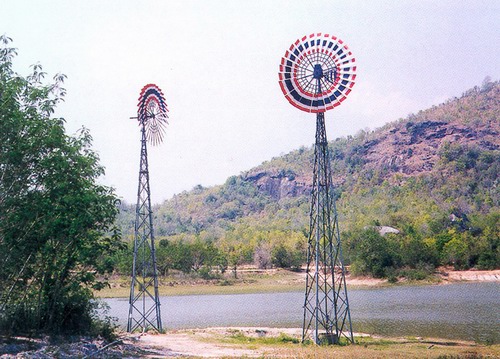
ระบบไฟฟ้าแสงสว่างด้วยเซลล์แสงอาทิตย์ โดยบริษัท โซลาร์ตรอน จำกัด
ระบบไฟฟ้าแสงสว่างด้วยเซลล์แสงอาทิตย์ประกอบด้วยเซลล์แสงอาทิตย์ขนาด 75 วัตต์ จำนวน 3 แผง รวมเป็น 225 วัตต์ อุปกรณ์ควบคุมบริเวณศาลาทรงงาน ขนาด 12 โวลต์ 6 แอมแปร์ จำนวน 1 ชุด อุปกรณ์ควบคุม บริเวณโรงเลี้ยงไก่ ขนาด 12 โวลต์ 10 แอมแปร์ จำนวน 1 ชุด แบตเตอรี่ชนิดเจล ขนาด 6 โวลต์ 150 แอมแปร์ชั่วโมง จำนวน 4 ลูก หลอดไฟประหยัดพลังงาน ขนาด 12 โวลต์ 7 วัตต์ จำนวน 9 หลอด และหลอดไฟประหยัดพลังงาน ขนาด 12 โวลต์ 11 วัตต์ จำนวน 6 หลอด โดยติดตั้งระบบดังกล่าวไว้ในบริเวณสวนสมเด็จฯ 2 จุด ด้วยกัน คือ ที่ศาลาทรงงาน และที่โรงเลี้ยงไก่ ทั้ง 2 จุดนี้สามารถใช้งานได้ 4 ชั่วโมง คือ เปิดทำงานโดยอัตโนมัติตอนช่วงหัวค่ำ 3 ชั่วโมง และจะทำงานอีกครั้งในช่วงเช้ามืดอีก 1 ชั่วโมง (การทำงานโดยอัตโนมัติเป็นผลมาจากการทำงานของอุปกรณ์ควบคุมการปรับกระแสไฟฟ้า)
ระบบผลิตไฟฟ้าด้วยเซลล์แสงอาทิตย์เชื่อมต่อสายส่ง โดยการไฟฟ้าฝ่ายผลิตแห่งประเทศไทย (สนับสนุนโดยกองทุนเพื่อส่งเสริมการอนุรักษ์พลังงาน)
ระบบผลิตไฟฟ้าด้วยเซลล์แสงอาทิตย์ เชื่อมต่อสายส่งนี้ติดตั้งที่อาคารห้องประชุมสำนักงานประกอบด้วยเซลล์แสงอาทิตย์ขนาด 2,100 วัตต์ อุปกรณ์ควบคุม 1 ชุด เครื่องแปลงกระแสไฟฟ้า 1 ชุด และวัตต์มิเตอร์แสดงผลการผลิตไฟฟ้า 1 ชุด
ในเวลาที่มีแสงอาทิตย์ เซลล์แสงอาทิตย์จะทำหน้าที่เปลี่ยนพลังงานแสงเป็นพลังงานไฟฟ้ากระแสตรง จากการออกแบบระบบจะให้ไฟฟ้ากระแสตรงขนาดแรงดัน 220-240 โวลต์ และกระแสไฟฟ้า 6-8 แอมแปร์ ไฟฟ้ากระแสตรง ที่ผลิตได้จะไหลผ่านเครื่องแปลงกระแสไฟฟ้าและถูกเปลี่ยนเป็นไฟฟ้ากระแสสลับที่มีแรงดัน 220 โวลต์ และมีคุณสมบัติเหมือนกับกระแสไฟฟ้าในระบบไฟฟ้าที่มีอยู่เดิม ดังนั้นกระแสไฟฟ้าที่ผลิตได้จากระบบนี้จึงสามารถใช้ได้กับเครื่องใช้ไฟฟ้าที่มีอยู่ทุกชนิด โดยในกรณีที่กระแสไฟฟ้าที่ผลิตได้จากเซลล์แสงอาทิตย์มีมากกว่าความต้องการใช้ไฟฟ้าในขณะนั้น กระแสไฟฟ้าส่วนเกินจะถูกขายคืนเข้าในระบบสายส่งของการไฟฟ้าฯ ในทางกลับกันหากความต้องการใช้กระแสไฟฟ้าในขณะนั้นมีมากกว่ากระแสไฟฟ้าที่ผลิตได้ กระแสไฟฟ้าส่วนที่ขาดก็จะถูกซื้อเสริมเข้ามาจากระบบสายส่งของการไฟฟ้าฯ ตามปกติ ซึ่งการทำงานของระบบได้รับการออกแบบให้เป็นการทำงานแบบอัตโนมัติ ดังนั้น จึงไม่ต้องมีการปิด-เปิดระบบแต่อย่างใดในแต่ละวัน
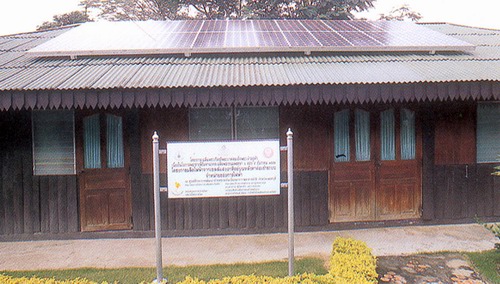
ผลจากการติดตั้งระบบ ทำให้ปริมาณกระแสไฟฟ้าที่ซื้อจากระบบสายส่งของการไฟฟ้าฯ ลดลงเท่ากับปริมาณกระแสไฟฟ้าที่ผลิตได้จากระบบเซลล์แสงอาทิตย์ ซึ่งเท่ากับว่าจะสามารถช่วยลดการใช้เชื้อเพลิงบรรพชีวิน เช่น น้ำมัน ก๊าซธรรมชาติ หรือถ่านหิน ในการผลิตกระแสไฟฟ้าลง อันจะส่งผลให้มลพิษที่เกิดจากการเผาไหม้เชื้อเพลิงดังกล่าวลดลงได้อีกทางหนึ่ง
ชุดแสงไฟล่อแมลงด้วยเซลล์แสงอาทิตย์ โดยบริษัท สยามโซลาร์ แอนด์ อีเลคทรอนิคส์ จำกัด
ลักษณะบ่อผลิตก๊าซชีวภาพเป็นบ่อแบบโดมคงที่ขนาด 8 ลูกบาศก์เมตร โดยใช้วัตถุดิบที่ใช้ในการหมักเพื่อผลิตเป็นก๊าซชีวภาพนั้น ใช้มูลจากคอกโคนมสาธิตจำนวน 6 ตัว สามารถผลิตก๊าซชีวภาพได้ประมาณวันละ 3-5 ลูกบาศก์เมตร ซึ่งพอเพียงที่จะนำมาใช้เป็นพลังงานในการต้มนมแพะและโคนมที่ผลิตได้ภายในศูนย์ฯ ใช้เป็นพลังงานในการกกลูกไก่และลูกเป็ด ทำให้ประหยัดพลังงานก๊าซหุงต้มเดือนละ 2 ถัง (ขนาด 15 กิโลกรัม) ส่วนพลังงานที่เหลือทางศูนย์ฯ จะเดินท่อก๊าซไปบ้านพักคนงานบริเวณโดยรอบเพื่อนำไปใช้ประโยชน์
ชุดแสงไฟล่อแมลงด้วยเซลล์แสงอาทิตย์นี้ออกแบบและผลิตโดยคนไทย เป็นอุปกรณ์ที่สามารถเคลื่อนย้ายได้ง่ายการติดตั้งสะดวก และมีต้นทุนการผลิตต่ำประกอบด้วยเซลล์แสงอาทิตย์ขนาด 10 วัตต์ จำนวน 1 แผง หลอดไฟฟลูออเรสเซนต์ 6 วัตต์ จำนวน 1 ชุด แบตเตอรี่ขนาด 12 โวลต์ 4 แอมแปร์ชั่วโมง จำนวน 1 ลูก เซนเซอร์วัดความสว่าง 1 ชุด ชุดตั้งเวลาการทำงานของหลอดไฟกับพัดลม 1 ชุด พัดลมขนาด 2 นิ้ว 1 เครื่องชุดแสดงผลความจุแบตเตอรี่ 1 ชุด ถุงผ้าดักแมลง 1 ถุง และขาตั้งแบบเคลื่อนย้ายได้ 1 ชุด
สำหรับศูนย์ศึกษาการพัฒนาห้วยทรายฯ พบว่า ยังไม่มีเครื่องล่อแมลงที่จะใช้กำจัดแมลงบางชนิดที่เป็นศูตรูพืช จึงได้นำชุดอุปกรณ์นี้มาใช้เพื่อช่วยแก้ปัญหาในเรื่องดังกล่าว ซึ่งลักษณะการทำงานของระบบเป็นไปโดยเซลล์แสงอาทิตย์จะประจุกระแสไฟฟ้าลงในแบตเตอรี่ในเวลากลางวัน เมื่อดวงอาทิตย์ตกดินเซนเซอร์วัดความสว่างจะสั่งให้หลอดไฟสว่างและพัดลมหมุนเป็นเวลา 2 ชั่วโมง ในขณะที่หลอดไฟสว่างและพัดลมหมุนนั้น หากมีแมลงบินเข้าใกล้ก็จะถูกดูดให้ตกลงไปในถุงผ้า แมลงที่จับได้นี้อาจนำไปใช้ประโยชน์เช่น นำไปเลี้ยงปลา นอกจากนี้ ชุดแสงไฟล่อแมลงยังสามารถติดตั้งไว้กลางบ่อเลี้ยงปลาเพื่อให้แมลงตกลงไปในบ่อปลาโดยตรงได้ด้วย
เครื่องสกัดสารกำจัดศัตรูพืชด้วยพลังงานแสงอาทิตย์ โดยบริษัท โซลาร์ตรอน จำกัด
เครื่องสกัดสารกำจัดศัตรูพืชด้วยพลังงานแสงอาทิตย์ประกอบด้วยแผงรับพลังงานแสงอาทิตย์ 1 ชุด ถังสกัดสารไส้กรอง ท่อน้ำเข้าถังและท่อน้ำเข้า แผงวาล์วเช็คระดับน้ำ ขารับแผงและถัง เป็นอุปกรณ์ที่นำพลังงานความร้อนจากแสงอาทิตย์มาใช้ ประโยชน์ในการต้มสกัดสารชีวภาพ ซึ่งมีอยู่ในสมุนไพรบางชนิด เช่น ตะไคร้ หอม สะเดา ข่า และอื่นๆ โดยการทำงานจะเริ่มต้นขึ้นเมื่อแสงอาทิตย์ตกกระทบแผงรับแสงอาทิตย์ พลังงานความร้อนจะถูกดูดซับและส่งถ่ายความร้อนให้กับน้ำที่อยู่ในระบบ ทำให้น้ำร้อนและลอยตัวขึ้นที่สูงแล้วไหลไปตามท่อหุ้มฉนวนเข้าสู่ถังสกัดสารกำจัดศัตรูพืชหรือหม้อต้มซึ่งใส่สมุนไพรไว้ ขณะเดียวกันน้ำส่วนล่างของหม้อต้มก็จะไหลไปตามท่อหุ้มฉนวนด้านตรงข้ามเข้าสู่แผงรับแสงอาทิตย์เพื่อรับพลังงานความร้อนจากแผงเป็นวัฏจักรเรียกว่า ระบบไหลเวียนตามธรรมชาติ น้ำในหม้อต้มจะมีอุณหภูมิสูงขึ้นเรื่อยๆ จนถึงประมาณ 90 องศาเซลเซียส โดยใช้เวลาวันละ 6-8 ชั่วโมง ก็จะได้น้ำสารสกัดจากพืชสมุนไพร 75-100 ลิตรต่อวัน เมื่อปล่อยให้เย็นก็สามารถนำน้ำสารสกัดไปฉีดพ่นพืชผักผลไม้ได้ทันที เพื่อป้องกันศัตรูพืชที่จะมาทำลาย
เครื่องวัดพลังงานแสงอาทิตย์ โดยมหาวิทยาลัยเทคโนโลยีพระจอมเกล้าธนบุรี
เครื่องวัดพลังงานแสงอาทิตย์ ประกอบด้วย 2 ส่วน ได้แก่
1. ส่วนเซนเซอร์หรือไพรานอมิเตอร์ ประกอบด้วยเซลล์แสงอาทิตย์ชนิดผลึกซิลิคคอนขนาด 1 ตารางเซนติเมตร และขั้วของเซลล์และอาทิตย์
2. ส่วนอินติเกรตสัญญาณ ทำหน้าที่แสดงผลและอินติเกรตค่าความเข้มรังสีดวงอาทิตย์เป็นพลังงาน
ประโยชน์ของเครื่องวัดพลังงานแสงอาทิตย์ คือสามารถวัดค่าพลังงานแสงอาทิตย์ในช่วงเวลาต่างๆ ซึ่งทำให้ทราบประสิทธิภาพการทำงานของระบบพลังงานทดแทนที่ใช้พลังงานแสงอาทิตย์ อันเป็นประโยชน์ต่อการพัฒนาระบบและอุปกรณ์ต่างๆ ในอนาคตได้
มุ้งแอร์สุขภาพรุ่นประหยัดพลังงาน โดยนายศฤงคาร รัตนางศุ (สมาคมการประดิษฐ์ไทย)
มุ้งติดแอร์ ประกอบด้วยโครงเหล็กขนาดเล็กแบบถอดประกอยได้ มีหลังคาทรงโค้งคล้ายทรงโดมและมีทางเข้าออก โดยตัวมุ้งผลิตจากผ้าชนิดพิเศษและมีน้ำหนักเบาเป็นลักษณะ 2 ชั้น ชั้นนอกโปร่งและชั้นในทึบเพื่อเป็นฉนวนความร้อน โดยมีช่องแอร์สำหรับต่อเข้ากับเครื่องปรับอากาศเคลื่อนที่ขนาดเล็กที่มีระบบฟอกอากาศ ด้านหน้าพ่นลมเย็น ด้านหลังพ่นลมร้อนซึ่งสามารถใช้เป็นเครื่องทำความอุ่นให้กับมุ้งติดแอร์ได้ เครื่องปรับอากาศเคลื่อนที่ขนาดเล็กนี้สามารถนำมาใช้ทดแทนพัดลมซึ่งให้ลมเย็นกว่าพัดลมไอน้ำ และเนื่องจากเป็นเครื่องปรับอากาศเล็กจึงสิ้นเปลืองพลังงานไฟฟ้าน้อยมาก
ระบบเครื่องขยายเสียงพลังงานแสงอาทิตย์ โดยบริษัท โซลาร์ตรอน จำกัด
เครื่องขยายเสียงพลังงานแสงอาทิตย์ ประกอบด้วยแผงเซลล์แสงอาทิตย์ขนาด 6 วัตต์ 12 โวลต์ 0.3 แอมแปร์ จำนวน 1 แผง ขนาด 12 โวลต์ 7 แอมแปร์ จำนวน 1 ลูก และเครื่องขยายเสียง พร้อมไมโครโฟนแบบมีสายและแบบไร้สาย จำนวน 1 ชุด ชุดเครื่องขยายเสียงถูกดัดแปลงให้สามารถใช้ได้ทั้งไฟฟ้ากระแสตรงและไฟฟ้ากระแสสลับ มีขนาดกำลังขยาย 50 วัตต์ โดยสามารถใช้งานได้ทั้งไมโครโฟนแบบมีสายและแบบไร้สายซึ่งใช้กระแสไฟฟ้าขนาด 0.5 แอมแปร์ และสามารถใช้งานติดต่อกันเป็นเวลา 3 ชั่วโมงต่อวัน เหมาะสำหรับการใช้งานในภาคสนามและเลือกใช้ตามความเหมาะสมได้อีกด้วย
ชุดกรองน้ำดื่มระบบรีเวิร์สออสโมซิสทำงานด้วยไฟฟ้าจากเซลล์แสงอาทิตย์ โดยมหาวิทยาลัยเทคโนโลยีพระจอมเกล้าธนบุรี
ชุดกรองน้ำดื่มระบบรีเวิร์สออสโมซิสเป็นเครื่องฟอกน้ำจืด น้ำกร่อย หรือ น้ำทะเลให้เป็นน้ำจืดบริสุทธิ์ โดยมีหลักในการทำงาน คือ ใช้เยื่อเมมเบรน (membrane) ซึ่งเป็นเยื่อบางๆ คล้ายแผ่นกระดาษ แต่มีเนื้อละเอียดถึง 0.0001 ไมครอน ทำให้โมเลกุลของสารละลายในน้ำไม่สามารถลอดผ่านไปได้ โดยเยื้อเมมเบรนจะทำงานควบคู่กับเครื่องสูบน้ำแรงดันสูงที่ทำหน้าที่ผลักดันน้ำดิบให้ผ่านเยื่อเมมเบรนเครื่องสูบน้ำดังกล่าวทำงานด้วยไฟฟ้าที่ผลิตจากเซลล์แสงอาทิตย์
ระบบที่นำมาติดตั้งนี้ประกอบด้วยแผงเซลล์แสงอาทิตย์ขนาด 60 วัตต์ แบตเตอรี่ขนาด 624 วัตต์ต่อชั่วโมง ชุดควบคุม และเครื่องสูบน้ำแรงดันสูง โดยการทำงานจะเริ่มจากการเปิดวาล์วให้น้ำดิบเข้าสู่ระบบไฟฟ้าจากเซลล์แสงอาทิตย์จะเดินเครื่องสูบน้ำให้ทำงานเพื่อเพิ่มความดันให้น้ำดิบ อัดน้ำผ่านส่วนไส้กรองคาร์บอนทั้งชนิดเม็ดและชนิดผง ส่วนเยื่อกรองเมมเบรน และส่วนไส้กรองคาร์บอนอันสุดท้ายจนได้เป็นน้ำบริสุทธิ์
พ.ต.ท. พีระพงศ์ ช่างสุพรรณ รองผู้กำกับการ 1 กอบบังคับการฝึกพิเศษ และรองหัวหน้ากองอำนวยการศูนย์ฯ ปฎิบัติหน้าที่แทนผู้อำนวยการศูนย์ฯ ได้ให้สัมภาษณ์ถึงผลจากการนำโครงการพลังงานทดแทนมาใช้งานภายในศูนย์การพัฒนาห้วยทรายฯ ดังนี้
สภาพการใช้พลังงานที่มีอยู่เดิมภายในศูนย์
พ.ต.ท. พีระพงศ์ : "แต่เดิม ในศูนย์ฯ มีการใช้พลังงานทดแทนอยู่บ้างแล้ว คือ พลังงานแสงอาทิตย์และพลังงานลม โดยแรกเริ่มก็ติดตั้งกังหันลมไว้ 6 ตัว กระจายอยู่ตามบริเวณต่างๆ แล้วก็มีเซลล์แสงอาทิตย์ที่ทางญี่ปุ่นนำมาติดตั้งให้ที่เขาเสวยกะปิเพื่อใช้ในระบบสูบน้ำขึ้นเขา แต่ปัญหาก็คือระบบเดิมนี้อาจจะยังมีเทคโนโลยีที่ยังพัฒนาไม่สมบูรณ์จึงไม่สมบูรณ์จึงไม่สามารถจะดันน้ำขึ้นไปยอดเขาได้ ดังนั้นพื้นที่ที่รับน้ำจากจุดนี้ได้จึงมีน้อย ถือว่ายังไม่ประสบความสำเร็จมากนัก แต่ในส่วนของกังหันนั้นถือว่าได้ผลดี เพราะพื้นที่ที่ได้รับผลอยู่ในบริเวณไม่ไกลกัน และน้ำที่สูบได้ก็ใช้เฉพาะในแปลงงานต่างๆ ซึ่งการใช้พลังงานทดแทนที่นี่เน้นในเรื่องของระบบสูบน้ำ เพราะเราใช้เฉพาะในแปลงงานต่างๆ ซึ่งการใช้พลังงานทดแทนที่นี่เน้นในเรื่องของระบบสูบน้ำ เพราะเราใช้ในการฟื้นฟูระบบนิเวศเป็นหลัก
"แล้วเราก็มีการใช้ระบบเครื่องยนต์ดีเซลและระบบเครื่องยนต์เบนซินในการสูบน้ำ โดยระบบเครื่องยนต์เบนซินจะเป็นปั๊มน้ำขนาดเล็กที่เคลื่อนย้ายได้ง่าย ซึ่งเราได้รับการสนับสนุนจากมูลนิธิชัยพัฒนาแต่ปั๊มที่ใช้สูบน้ำประจำที่มีขนาดใหญ่และใช้ในแปลงที่ทำงานศึกษาด้านวิชาการเกษตรนั้น จะเป็นเครื่องยนต์ดีเซลเสียส่วนใหญ่"
การนำโครงการพลังงานทดแทนมาใช้งานภายในศูนย์ฯ เป็นไปในลักษณะใด
พ.ต.ท. พีระพงศ์ : "โครงการนี้นำมาใช้ทดแทนการใช้พลังงานในบางส่วนได้ โดยในศูนย์ของเราจะยังคงใช้ทั้ง 2 ระบบผสมผสานกัน อย่างที่สวนสมเด็จฯ ซึ่งเป็นจุดทดลองงานวิชาการเกษตรต่างๆ ได้แก่ เกษตรผสมผสาน วนเกษตร ทฤษฎีใหม่แบบน้ำฝนหรือชลประทาน เป็นงานที่ใช้น้ำค่อนข้างมาก แต่เดิมเราใช้เครื่องยนต์ดีเซลเป็นหลักอยู่ ก็นำเอาพลังงานทดแทนนี้มาใช้แทนมากขึ้น และพยายามลดการใช้เครื่องยนต์ดีเซลลงเนื่องจากใช้งานหนัก แต่จะใช้เครื่องดีเซลตัวเก่าเพื่อเสริมเฉพาะในช่วงหน้าแล้งจัด คาดว่าจะสามารถลดการใช้น้ำมันดีเซลลงได้ไม่น้อยกว่า 80%"
ผลที่ได้รับจากการนำโครงการพลังงานทดแทนมาใช้งานภายในศูนย์ฯ
พ.ต.ท. พีระพงศ์ : "เมื่อประเมินผลจากจุดแรกที่ติดตั้งคือที่เขาบ่อขิงการติดตั้งระบบพลังงานแสงอาทิตย์ จากโครงการนี้ ค่อนข้างจะมีประสิทธิภาพสูง เนื่องจากมีระยะยกน้ำสูงถึง 100 เมตร และความยาวของท่อปั๊มซึ่งมีปั๊ม 2 ตัว ก็มีความยาวประมาณ 1 กิโลเมตร ทำให้สามารถสูบน้ำขึ้นไปถึงยอดเขาได้ อาจกล่าวได้ว่า ผลในด้านการใช้งานในระบบสูบน้ำนี้เป็นที่น่าพอใจในระดับหนึ่ง
"ในส่วนผลดีด้านอื่นๆ คงจะเป็นในด้านการประหยัดค่าใช้จ่ายพลังงาน แล้วก็เป็นพลังงานสีขาวที่ไม่ก่อมลพิษ ส่วนอีกประการที่คิดว่าน่าจะเป็นประโยชน์มากเลยทีเดียว ก็คือ พลังงานทดแทนที่ติดตั้งในศูนย์ฯ จะเป็นรูปแบบการสาธิตที่คนทั่วไปสามารถเข้ามาดูงานและได้เห็นภาพการทำงานจริง เพราะที่นี่เป็นจุดหนึ่งที่ไม่ไกลจากกรุงเทพฯ มากนัก นักศึกษาตามสถาบันต่างๆ จะได้มาศึกษา ได้มาดูการดำเนินงานในพื้นที่จริงๆ และเป็นพื้นที่ที่ใหญ่ รวมทั้งในส่วนของราชการด้วย ซึ่งส่วนราชการบางแห่งอาจจะมีปัญหาในด้านการใช้จ่ายเรื่องของน้ำมัน เรื่องของการทำงาน ก็อาจจะมาดูรูปแบบ และจะได้รู้ว่าจะติดต่อได้ที่ไหน มีการติดตั้งอย่างไร และใช้งบประมาณเท่าไร ในส่วนอื่นก็คงจะเป็นผลพลอยได้ อย่างป่าก็จะได้รับน้ำเพิ่มขึ้นจากระบบนี้"
ที่มา : พระบิดาแห่งการพัฒนาพลังงานไทย
โครงการในหลวงกับพลังน้ำ
ในหลวงกับพลังน้ำ
วันที่ 9 พฤษภาคม พ.ศ. 2549 กระทรวงพลังงานร่วมกับสถาบันปิโตรเลียมแห่งประเทศไทยและการไฟฟ้าฝ่ายผลิตแห่งประเทศไทย จัดเสวนาเฉลิมพระเกียรติพระบาทสมเด็จพระเจ้าอยู่หัว เนื่องในวโรกาสทรงครองสิริราชสมบัติครบ 60 ปี ในหัวข้อ "ในหลวงกับน้ำ" ณ หอประชุมอาคารประชาสัมพันธ์ การไฟฟ้าฝ่ายผลิตแห่งประเทศไทยโดยมีพลอากาศตรี กำธน สินธวานนท์ องคมนตรี อดีตผู้ว่าการไฟฟ้าฝ่ายผลิตแห่งประเทศไทยและประธานคณะกรรมการมูลนิธิเพื่อสถาบันปิโตรเลียมแห่งประเทศไทย และคุณเกษม จาติกวณิช อดีตผู้ว่าการไฟฟ้าฝ่ายผลิตแห่งประเทศไทย เป็นวิทยากรในการเสวนาดังกล่าว ซึ่งสามารถสรุปได้ดังนี้
เป็นที่รู้กันมานานแล้วว่า พระบาทสมเด็จพระเจ้า-
อยู่หัวทรงสนพระทัยและทรงเชี่ยวชาญเรื่อง
น้ำมากเป็นพิเศษ อย่างไรก็ตาม โครงการ
พัฒนาแหล่งน้ำเหล่านี้นับตั้งแต่เริ่มแรกก็เป็นการ
ดำเนินการที่ควบคู่ไปกับรัฐบาล โดยระมัดระวัง
ไม่ให้ซ้ำซ้อนกับงานพัฒนาของรัฐบาล
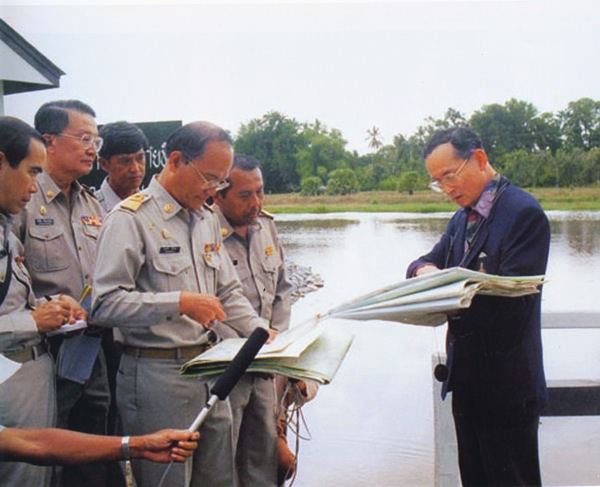
พระบาทสมเด็จพระเจ้าอยู่หัวกับโครงการพัฒนาแหล่งน้ำ
ตลอดระยะเวลา 60 ปีที่พระบาทสมเด็จพระเจ้าอยู่หัวทรงครองสิริราชสมบัติ พระองค์ทรงปฏิบัติพระราชกรณียกิจนานัปการ และครอบคลุมการพัฒนาเกือบทุกแขนง ทั้งในด้านการพัฒนาแหล่งน้ำ โครงการทางด้านการเกษตร โครงการทางด้านพลังงาน ฯลฯ นับพันโครงการ โดยเฉพาะโครงการพัฒนาแหล่งน้ำนั้น เป็นที่รู้กันมานานแล้วว่า พระบาทสมเด็จพระเจ้าอยู่หัวทรงสนพระทัยและทรงเชี่ยวชาญเรื่องน้ำมากเป็นพิเศษ อย่างไรก็ตาม โครงการพัฒนาแหล่งน้ำเหล่านี้นับตั้งแต่เริ่มแรกก็เป็นการดำเนินการที่ควบคู่ไปกับรัฐบาล โดยระมัดระวังไม่ให้ซ้ำซ้อนกับงานพัฒนาของรัฐบาล ซึ่งในประเด็นนี้ พลอากาศตรี กำธน สินธวานนท์ ได้เสนอความเห็นโดยสรุปว่า เกิดจากการที่พระองค์ได้ทรงงานด้วยความละเอียดรอบคอบ และเริ่มทรงงานจากโครงการขนาดเล็ก อันเป็นการช่วยเสริมช่องว่างของรัฐบาลด้วย
หลังจากพระบาทสมเด็จพระเจ้าอยู่หัวเสด็จฯ ขึ้นครองราชย์ปี พ.ศ.๒๕๘๙ พระองค์ได้เสด็จฯกลับไปศึกษาต่อที่ประเทศสวิตเซอร์แลนด์ โดยทรงเปลี่ยนไปเรียนด้านการปกครองและกฎหมายแทนสาขาวิศวกรรมที่ทรงศึกษาแต่เดิมหลังจากทรงสำเร็จการศึกษาและเสด็จนิวัติประเทศไทยแล้ว พระองค์ได้เสด็จพระราชดำเนินเพื่อเยี่ยมราษฎรดูแลทุกข์สุขเพื่อทราบถึงต้นเหตุแห่งปัญหา เสด็จฯไปตามจังหวัดต่างๆ ทั่วประเทศ เพื่อเตรียมหาข้อเท็จจริงก่อนจะเห็นได้ว่าพระราชทานกรณียกิจในช่วงแรกของพระองค์ยังไม่มีโครงการพระราชดำริเลย
การที่พระบาทสมเด็จพระเจ้าอยู่หัวเสด็จะพระราชดำเนินหรือแปรพระราชฐานไปตามจังหวัดต่างๆ นั้น หม่อมราชวงศ์คึกฤทธิ์ ปราโมช เคยกล่าวไว้ว่า พระองค์ท่านไปตั้งออฟฟิศเล็กๆ เพื่อทรงดูแลประชาชนรอบๆ ที่ประทับ อย่างไรก็ตาม พระราชกรณียกิจในช่วงเริ่มแรกนี้ พระองค์ไม่ได้ทรงสนพระทัยในเรื่องใหญ่โตมากนัก แต่ทรงมองว่า ตรงจุดไหนมีเรื่องให้พระองค์ทรงช่วย พระองค์ก็จะทรงช่วยและในระหว่างที่เสด็จฯไปเยี่ยมราษฎรทุกครั้ง ยังทรงนำหน่วยงานของสำนักคณะกรรมพัฒนาการพัฒนาการเศรษฐกิจและสังคมแห่งชาติหรือสภาพัฒน์ฯไปด้วยทุกครั้ง ซึ่งหน่วยงานนี้คล้ายๆ กับเป็นเลขานุการส่วนพระองค์ไปในตัวด้วย ซึ่งต่อมาเราเรียกหน่วยงานนี้ว่า สำนักงาน............
ในการทรงงานนั้น พระบาทสมเด็จพระเจ้าอยู่หัวทรงมีวิธีของพระองค์เอง ทรงทอดพระเนตร ทรงศึกษาและสอบถามจากชาวบ้าน ตรวจสอบแผนที่ เรียกเจ้าหน้าที่มาถาม แล้วจึงทรงคิดออกมาเป็นแผนงาน จากนั้นจะทรงเรียกเจ้าหน้าที่ที่เกี่ยวข้องมาดู เมื่อเห็นว่าสามารถทำโครงการพัฒนาเหล่านั้นได้ จึงทรงตัดสินพระทัยทำ สภาพัฒน์ฯ จะคอยถวายรายงานว่า โครงการพัฒนาที่จะทรงทำนั้นโครงการที่ตรงกับรัฐบาลหรือไม่ ถ้ารัฐบาลทำ จะทรงเลี่ยงมาทำเรื่องเล็กๆ ที่ไม่ซ้ำซ้อนกัน แต่หากเป็นเรื่องใหญ่หรือเป็นโครงการที่ต้องใช้เงินเป็นจำนวนมาก พระองค์จะทรงให้สภาพัฒน์ฯไปเสนอต่อรัฐบาล เพราะฉะนั้นแต่ละโครงการจึงไม่ซ้ำกัน เรียกได้ว่า พระองค์ทรงทำงานของพระองค์ รัฐบาลก็ทำงานของรัฐบาล แต่พระราชกรณียกิจด้านการพัฒนาเหล่านี้ บางครั้งก็ใหญ่โตขึ้นเรื่อยๆ อาจเป็นโครงการที่เสนอรัฐบาลแล้วไม่มีความคืบหน้า ซึ่งอาจเกิดจากรัฐบาลยังไม่พร้อม อย่างเช่น โครงการปากพนัง จังหวัดนครศรีธรรมราช ซึ่งได้เสนอรัฐบาลไปสามปีแล้ว ทว่ายังไม่มีการดำเนินการใดๆ พระบาทสมเด็จพระเจ้าอยู่หัวจึงทรงรับไว้เป็นโครกการส่วนพระองค์
ในการทรงงานนั้น พระบาทสมเด็จพระเจ้าอยู่หัว
ทรงมีวิธีของพระองค์เอง ทรงทอดพระเนตร
ทรงศึกษาและสอบถามจากชาวบ้าน ตรวจสอบ
แผนที่ เรียกเจ้าหน้าที่มาถาม แล้วจึงทรง
คิดออกมาเป็นแผนงาน จากนั้นจะทรงเรียก
เจ้าหน้าที่ที่เกี่ยวข้องมาดู เมื่อเห็นว่าสามารถ
ทำโครงการพัฒนาเหล่านั้นได้ จึงทรง
ติดสินพระทัยทำ
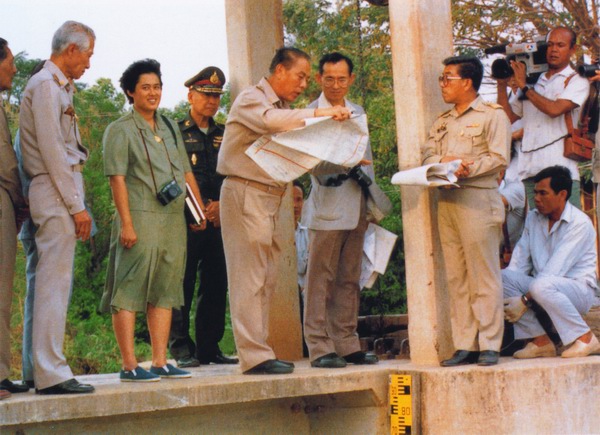
นอกจากนี้ พระบาทสมเด็จพระเจ้าอยู่หัวยังทรงระวังพระองค์เองว่า โครงการพัฒนาต่างๆ ตามพระราชดำรินั้นต้องไม่ใช่เป็นการไปแย่งงานของรัฐบาล แต่เป็นการช่วยเสริมช่องว่าง เดิมทีโครงการตามพระราชดำริต่างๆ เหล่านี้ใช้งานจากพระราชทรัพย์ส่วนพระองค์ ต่อมาจึงมีการจัดตั้งมูลนิธิชัยพัฒนาขึ้นเพื่อช่วยแก้ปัญหาต่างๆ เนื่องจากเป็นที่รู้กันว่าเงินของราชการนั้นเป็นเงินงบประมาณ ซึ่งจะหมดในปลายปี เมื่อรัฐไม่มีค่าใช้จ่ายในการทำงานต่างๆ มูลนิธิจึงจะเข้ามาช่วยเหลือด้วยการให้ยืมเงินไปทำงานก่อน
หลักการทรงงานของพระบาทสมเด็จพระเจ้าอยู่หัวนั้นจะทรงถือหน้าที่เป็นสำคัญ ไม่ได้ถือเรื่องตำแหน่งหรือยศของคนทำงาน การทรงงานของพระองค์นั้นเปรียบได้กับเรือลำหนึ่งที่มีเรือเอกเป็นกัปตัน แต่ถ้าเรือลำนั้นใช้เครื่องยนต์ปรมาณู คนที่รู้เรื่องเครื่องยนต์อาจเป็นจ่า แต่ก็ต้องฟังเรือเอกว่าจะให้เลี้ยวซ้ายหรือเลี้ยวขวา จะหยุดหรือยิงอย่างไร เป็นการทำงานด้วยหน้าที่ พระองค์จะทรงละเอียดอ่อนเรื่องนี้ ซึ่งทำให้สามารถดำเนินพระราชกรณียกิจด้านการพัฒนาได้อย่างราบรื่น
การไฟฟ้าฝ่ายผลิตแห่งประเทศไทยกับโครงการพัฒนาแหล่งน้ำตามพระราชดำริ
สำหรับโครงการพัฒนาแหล่งน้ำสำคัญ ๆ ที่การไฟฟ้าฝ่ายผลิตแห่งประเทศไทย (กฟผ.) มีโอกาสถวายงานตามพระราชดำริแด่พระบาทสมเด็จพระเจ้าอยู่หัวนั้น คุณเกษม จาติกวนิช อดีตผู้ว่าการการไฟฟ้าฝ่ายผลิตแห่งประเทศไทยกล่าวว่า "พระบาทสมเด็จพระเจ้าอยู่หัวทรงมีความรอบรู้เรื่องเขื่อน ทรงศึกษาเรื่องเขื่อนมาเป็นอย่างดี ทรงมีสายพระเนตรยาวไกล คือ ทรงคำนึงถึงประโยชน์ของประชาชนชาวไทยโดยรวมก่อน ดังนั้น การสร้างเขื่อนแต่ละเขื่อนจึงไม่ใช่เพียงการเอื้อประโยชน์แก่ผู้ใช้ไฟฟ้าเท่านั้น แต่ยังเอื้อประโยชน์ถึงเกษตรกร ชาวนา หรือเพื่อการป้องกันน้ำท่วมอีกด้วย โดครงการพระราชดำริหลายโครงการสำเร็จได้ด้วยพระบารมีของพระบาทสมเด็จพระเจ้าอยู่หัว เช่น โครงการเขื่อนป่าสักชลสิทธิ์ซึ่งเป็นโครงการที่มีประโยชน์เรื่องการป้องกันน้ำท่วมได้อย่างชัดเจน ถึงแม้จะไม่มากเท่ากับเขื่อนภูมิพล ทว่าผลประโยชน์อื่นๆ ที่เกษตรกรจะได้รับมีมากมายมหาศาล เนื่องจากเป็นเขื่อนที่ตั้งอยู่ในเขตพื้นที่ที่มีการทำนาเป็นจำนวนมาก............


นอกจากนี้ ในการสร้างเขื่อนแต่ละครั้ง พระบาทสมเด็จพระเจ้าอยู่หัวจะทรงให้ความสำคัญกับเรื่องการย้ายชาวบ้าน ทรงกำชับว่าต้องหางบประมาณเพื่อจ่ายค่าตอบแทนชาวบ้านอย่างเป็นธรรม ประชาชนที่จะต่อต้าน พอรู้ว่าเป็นพระราชดำริของพระบาทสมเด็จพระเจ้าอยู่หัว ก็ยอมทำตามพระราชประสงค์ยกตัวอย่างเช่นการสร้างเขื่อนป่าสักชลสิทธิ์ หากให้ทางราชการเป็นผู้สร้าง เชื่อว่าอีก ๑๐๐ ปีก็อาจยังคงไม่ได้สร้าง เพราะผู้ที่ผู้อาศัยคงไม่ยอมย้ายออกแต่เมื่อเป็นพระราชดำริของพระบาทสมเด็จพระเจ้าอยู่หัวที่ทรงชี้ให้เห็นถึงประโยชน์ของกโครงการ ทุกคนจึงเชื่อและรับสรองพระราชดำริ ไม่แต่เฉพาะเรื่องเขื่อนเท่านั้น เรื่องออื่นๆ ประชาชนชาวไทยก็อาศัยพระบารมีของพระองค์เช่นกัน เรียกว่าด้วยพระบารมีสามารถเปลี่ยนเรื่องใหญ่โตให้จบลงได้ในวันเดียว.....
จะขอย้อนมาเรื่องต้นกำเนิดของเขื่อนสำหรับผลิตไฟฟ้าในประเทศไทย เดิมทีประเทศไทยมีโรงงานผลิตไฟฟ้าวัดเลียบและโรงไฟฟ้าสามเสน ใช้ฟืนและแกลบเป็นเชื่อเพลิงในการผลิตๆไฟฟ้า เมื่อครั้งสงครามที่ข้าเปลือกขายไม่ได้ราคา ก็เคยใช้ข้าวเปลือกเหล่านี้เป็นเชื่อเพลิงผลิตไฟฟ้ามาแล้ว แต่ไฟฟ้า
ในการสร้างเขื่อนแต่ละครั้ง พระบาทสมเด็จ
พระเจ้าอยู่หัวจะทรงให้ความสำคัญกับเรื่องการ
ย้ายชาวบ้าน ทรงกำชับว่าต้องหางบประมาณ
เพื่อจ่ายค่าตอบแทนชาวบ้านอย่างเป็นธรรม
ประชาชนที่จะต่อต้าน พอรู้ว่าเป็นพระราชดำริ
ของพระบาทสมเด็จพระเจ้าอยู่หัว ก็ยอมทำตาม
พระราชประสงค์
ก็ยังไม่พอใช้ ต้องดับไฟเป็นเขตๆ ทุกวัน เมื่อมีพระราชบัญญัติการไฟฟ้ายันฮีในปี พ.ศ.๒๕๐๐ จึงก่อให้เกิดการไฟฟ้าฝ่ายผลิตขึ้น มีการก่อสร้างเขื่อนภูมิพลหรือชื่อเดิมว่าเขื่อนยันฮี ซึ่งเป็นเขื่อนที่ใหญ่ที่สุดในประเทศไทย และแทบจะใหญ่ที่สุดในเอเชียในเวลานั้น ซึ่งในขณะนั้นพระบาทสมเด็จพระเจ้าอยู่หัวทรงครองราชย์มาได้ ๑๑ ปี จึงอากเรียกได้ว่าพัฒนาการของเขื่อนผลิตๆฟฟ้าในประเทศไทยนั้นมีระยะเวลาที่เท่า ๆ กับการครองราชย์ของพระองค์......
เขื่อนภูมิพลเป็นเขื่อนที่ให้ประโยชน์ทั้งการเกษตรและการเกษตรและการไฟฟ้าในตอนเริ่มต้นประเมินกันว่ามีค่าใช้จ่ายในการก่อสร้างประมาณ ๕๐ ล้านดอลลาร์ ซึ่งในขณะนั้นอัตราแลกเปลี่ยนเงินไทยและเงินดอลลาร์สหรัฐประมาณ ๑๒ บาทต่อดอลลาร์ เมื่อคิดเป็นเงินไทยประมาณหนึ่งพันล้านบาท ซึ่งค่อนข้างสูงมากในเวลานั้น มีคำถามมากมายว่าจะไปเอาเงินจำนวนมากขนาดนั้นมาจากไหน ในที่สุดก็ไปกู้จากธนาคารโลก ซึ่งคิดดอกเบี้ย ๕ เปอร์เซ็นต์เป็นเวลา ๒๐ ปี ซึ่งหลายคนไม่เห็นด้วย เพราะคิดว่าเป็นการสร้างหนี้สินให้คนรุ่นลูกหลานนานถึง ๒๐ ปีแต่อย่างไรก็ตาม ในที่สุดก็มีการสร้างเขื่อนจนเป็นผลสำเร็จ โดยธนาคารโลกมีข้อกำหนดว่า ต้องนำเงินรายได้จากเขื่อนมาใช้คืน ไม่ใช่นำเงินงบประมาณมาใช้หนี้ ซึ่งเมื่อคำนวณรายได้จากการขายไฟฟ้าแล้ว ปรากว่าพอเลี้ยงตัวเองได้โดยไม่ต้องพึ่งพางบประมาณ เขื่อนภูมิพลจึงเกิดขึ้นมา แต่ทุกคนก็รู้ว่าเขื่อนนี้เป็นเขื่อนอเนกประสงค์ ใช้ได้ทั้งไฟและเกษตรกรรม โดยเฉพาะทุ่งราบภาคกลางที่สามารถทำนาได้มากกว่าปีละครั้ง และเกษตรกรก็ไม่ต้องเสียค่าน้ำที่เขื่อนส่งมาให้ด้วย เพราะเขื่อนมีเงินรายได้จากการขายไฟฟ้าไปใช้หนี้คืนธนาคารโลกอยู่แล้ว"
แนวพระราชดำริด้านการพัฒนาแหล่งน้ำและเขื่อน
พลอากาศตรี กำธน สินธวานนท์ กล่าวถึงแนวพระราชดำริด้านการพัฒนาแหล่งน้ำและเขื่อนของพระบาทสมเด็จพระเจ้าอยู่หัวว่า "พระองค์ทรงเริ่มโครงการพัฒนาจากการเสด็จฯ เยี่ยมราษฎรทั่วประเทศ ทรงรับทราบปัญหาสำคัญเรื่องการขาดแคลน 'แหล่งน้ำ' ของพสกนิกรส่วนใหญ่ ซึ่งมีอาชีพเกษตรกรรม ดังนั้น การแปรพระราชฐานไปที่ใดก็ตามพระองค์จะสมใจแต่เรื่องน้ำเป็นหลัก เพื่อหาทางให้มีการชลประทานไปสู่พื้นที่ที่ราษฎรเพาะปลูก และหากพบว่ามีแหล่งน้ำที่ใด พระองค์ก็จะทรงส่งเสริมให้มีการสร้างฝาย สร้างเขื่อน และด้วยเหตุนี้พระองค์จึงให้ความสนพระทัยในเรื่องเขื่อนด้วย ทรงสนพระทัยว่าเขื่อนขนาดนี้ สูงเท่านี้ ควรจะมีเครื่องผลิตไฟฟ้าและจ่ายไฟอย่างไร ทรงเข้าพระทัยดีแม้กระทั่งว่าพื้นที่อ่างน้ำขนาดเท่านี้จะโดนแดดส่งลงมาน้ำระเหยไปเท่าไร ทรงเคยรับสั่งว่า โครงการทฤษฎีใหม่ที่ว่าให้มีการขุดบ่อน้ำ พื้นที่เท่านี้มีน้ำเท่านี้ ถ้าราษฎรไม่ใช้น้ำในอ่างภายในเวลาเท่าไร น้ำจะระเหยไปหมด เพราะฉะนั้นตอนน้ำเต็มอ่างก็ควรใช้ประโยชน์เสียก่อนที่น้ำจะระเหยไปในอากาศหมด.....
พระบาทสมเด็จพระเจ้าอยู่หัวทรงไม่ได้เจาะจง
เรื่องการใช้น้ำเพียงอย่างเดียว ทรงเข้าใจระบบ
ของการไฟฟ้าอย่างดี ไม่ว่าจะเป็นเรื่องขั้นตอน
การผลิตไฟฟ้า เรื่องเครื่องกำเนิดไฟฟ้า และ
ยังทรงรู้สึกไปกว่านั้น คือการทรงพระราชทาน
แนวพระราชดำริในการใช้ประโยชน์จากแหล่งน้ำ
ในการผลิตไฟฟ้าด้วย
อย่างไรก็ตาม พระบาทสมเด็จพระเจ้าอยู่หัวทรงไม่ได้เจาะจงเรื่องการใช้น้ำเพียงอย่างเดียว ทรงเข้าใจระบบของการไฟฟ้าอย่างดีไม่ว่าจะเป็นเรื่องขั้นตอนการผลิตไฟฟ้า เรื่องเครื่องกำเนิดไฟฟ้า และยังทรงรู้ลึกไปกว่านั้น คือการทระพระราชทานแนวพระราชดำริในการใช้ประโยชน์จากแหล่งน้ำในการผลิตไฟฟ้าด้วย เช่นที่หมู่บ้าน 'บ้านยาง' บริเวณเชิงดอยของอ่างขาง ซึ่งหม่อมเจ้าภีศเดช รัชนี ทรงดูแลอยู่ เดิมทีมีแหล่งน้ำไหลอยู่ตลอดในบริเวณนั้น พระบาทสมเด็จพระเจ้าอยู่หัวเสด็จฯไปแล้วก็ตรัสว่า ที่นั่นพระองค์มีโรงงานทำผลไม้กระป๋อง (ปัจจุบันคือโรงงานผลิตเครื่องกระป๋องตรา 'ดอยคำ' ) แต่ไม่มีไฟฟ้า จึงทรงให้ท่านชายภีศเดชมาตาม กฟผ.ไปดูว่ามีน้ำมากพอสำหรับทำไฟฟ้าหรือไม่ กฟผ.รับพระราโชบายมา และทำการก่อสร้างโรงไฟฟ้าบ้านยาง โดยติดตั้งเครื่องกำเนิดไฟฟ้าเครื่องละ ๕๖ กิโลวัตต์ ๒ เครื่อง พระบาทสมเด็จพระเจ้าอยู่หัวได้เสด็จไปทรงเปิด ให้ด้วยพระองค์เอง โรงงานเครื่องกระป๋องและชาวบ้านในบริเวณนั้น จึงได้ใช้ประโยชน์จากเครื่องกำเนิดไฟฟ้าดังกล่าวด้วย"
ในประเด็นดังกล่าว คุณเกษม จาติกวนิช กล่าวเสริมว่า "การสร้างเขื่อนขนาดเล็กเพื่อผลิตกระแสไฟฟ้านั้น หากปล่อยให้ กฟผ.ไปทำลำพังอาจมีคนแย้งเรื่องความคุ้มค่า และอาจมีคนถามว่า มันเรื่องอะไรของ กฟผ. ที่จะไปทำโรงไฟฟ้าขนาดเล็กบนดอย แต่เนื่องจากพระบาทสมเด็จพระเจ้าอยู่หัวทรงดูแลทุกข์สุขของประชาชน เมื่อทรงรับสั่ง กฟผ.จึงได้สนองพระราชดำริ อยากให้พวกเราเห็นว่า การดูแลผลประโยชน์และผลตอบแทนเหล่านี้ไม่ควรมองพียงด้านเดียว แต่ต้องดูประโยชน์ที่จะเกิดขึ้นอย่างรอบด้าน เรียกว่าพระวิสัยทัศน์ของพระบาทสมเด็จพระเจ้าอยู่หัวนั้นทรงกว้างขวางมาก.....
แม้แต่เรื่องเขื่อนภูมิพล เมื่อครั้งที่พระบาทสมเด็จพระเจ้าอยู่หัวเสด็จฯ ประเทศอิหร่าน พระเจ้าชาห์แห่งอิหร่านได้มีพระราชดำรัสเรื่องเขื่อนในประเทศอิหร่านกับพระองค์ เมื่อพระเจ้าชาห์เสด็จฯเยือนประเทศไทย พระบาทสมเด็จพระเจ้าอยู่หัวก็ทรงอยากให้พวกเรา กฟผ. แสดงให้ต่างชาติเห็นว่าพวกเราก็มีดี ก็ทรงให้ กฟผ.สร้างที่ประทับที่เขื่อน และให้เราต้อนรับพระเจ้าชาห์ โดยพระองค์ไม่ได้เสด็จฯด้วย พระองค์ทรงวางพระทัยพวก กฟผ. ทรงภูมิพระทัยว่าประเทศไทยมีเขื่อนขนาดใหญ่เช่นกัน กฟผ. ก็สนองพระราชประสงค์ได้อย่างสมบูรณ์ พระเจ้าชาห์ทรงคล้ายกับพระเจ้าอยู่หัวคือ ทรงสนพระทัยเรื่องเขื่อน เรื่องเครื่องกำเนิดไฟฟ้า กฟผ.ถวายรายงานว่าเขื่อนภูมิพลสูงเท่าไหร่ ความจุเท่าไหร่ ตอนแรกพระเจ้าชาห์ทรงมีทีท่าทางว่ามีขนาดใหญ่ แต่พอทรงประทับเรือลงไปในอ่างเก็บน้ำของเขื่อนภูมิพลก็ทรงเชื่อ ทรงตรัสว่า 'นี่มันไม่ใช่อ่าง นี่มันทะเล' ....
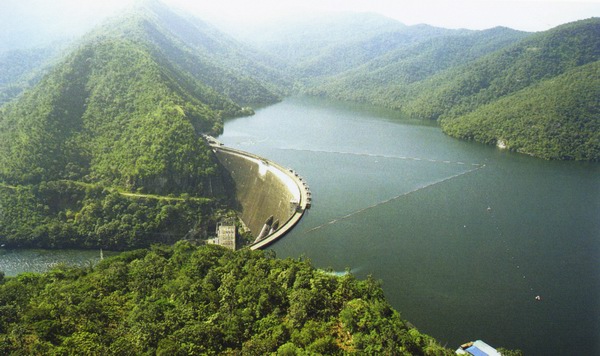
นอกจากนี้ พระบาทสมเด็จพรเจ้าอยู่หัวยังทรงสนพระทัยเรื่องเขื่อนภูมิพลเสมอ เคยรับสั่งด้วยความเป็นห่วงว่า 'วันหนึ่งถ้าตะกอนจะเต็มแล้วจะทำอย่างไร' กฟผ.ก็ตอบไม่ได้เหมือนกัน แม้ตามหลักวิชาการแล้วไม่น่าจะเต็ม ตรัสว่า 'ถ้าไม่คิดไว้ก่อน บอกว่ายังไม่ถึงเวลาคิด ถ้าถึงเวลาแล้วจะคิดออกไหม' เมื่อกราบบังคมทูลไปว่าคิดออก พระองค์ท่านก็ตรัสว่า 'ถ้าคิดออกให้เขียนไว้ในกกระดาษแล้วเอาไปใส่ในไหไปฝังไว้เป็นลายแทง เผื่อว่าอีก ๔๐๐ ปีจะมีใครมาขุดเอาไปใช้ เพราะว่าเขื่อนมันเต็ม' ซึ่งในความเป็นจริง คำว่าเต็มนี้ไม่ได้หมายถึงต้องเต็มตัวเขื่อน แค่เต็มที่ระยะ ๒๓๐ เมตร ในระดับ ELEVATION เป็นระดับปากท่อที่จะปล่อยน้ำลงปั่นเครื่องปั่นไฟ ซึ่งน้ำก็จะไม่เข้าท่อแล้ว เพราะฉะนั้นอายุของเขื่อนก็จะหมดตรงนั้น กฟผ. จึงได้ไปทำการวิจัยว่าตะกอนที่ตกมาแล้ว ตกตรงไหนบ้าง ปรากฏว่าว่ามันยังตกมาไม่ถึงตัวเขื่อน ก็ไปกราบทูลให้ทรงทราบ เหล่านี้แสดงให้เห็นว่าพระองค์ทรงเป็นห่วงอยู่เสมอ ไม่ใช่ว่าทำเสร็จแล้วก็ปล่อยไป"
หลักในการจัดทำโครงการพัฒนา พระบาทสมเด็จพระเจ้าอยู่หัวจะทรงคำนึงถึงประโยชน์สุขของราษฎรเป็นหลักไม่ว่าจะเป็นเพียงคนกลุ่มเล็กๆ หรือมีจำนวนน้อยแค่ไหน
เช่น เมื่อครั้งที่พระบาทสมเด็จพระเจ้าอยู่หัวเสด็จฯไปเปิดเขื่อนจุฬาภรณ์ ซึ่งก็เป็นที่ประหลาดว่า ไม่ว่าฝนจะตกฟ้าจะร้อง ถ้าพระองค์เสด็จฯมาถึง ฟ้าจะเปิดทุกที คืนนั้นหลังจากทรงเปิดเขื่อนแล้วได้ทรงประทับแรมที่เขื่อนด้วยทรงมีรับสั่งว่า หมู่บ้านใต้เขื่อนจุฬาภรณ์ไม่มีน้ำ ให้ กฟผ. ไปดูว่าสามารถช่วยอะไรชาวบ้านได้บ้าง ซึ่งที่มาที่ไปดังกล่าวพลอากาศตรี กำธนกล่าวว่า "ในการสร้างเขื่อนจุฬาภรณ์นั้น ชาวบ้านหลายคนเชื่อว่า กฟผ. เก็บน้ำของชาวบ้านเอาไว้ ทั้งที่จริงๆ แล้วเขื่อนเก็บน้ำส่วนเกินในหน้าฝน พระองค์จึงทรงมีพระราชดำริให้ไปสร้างเขื่อนอีกแห่งเพื่อให้ชาวบ้านมีน้ำไว้ใช้ กฟผ. รับสนองพระราชประสงค์ โดยสร้างเขื่อน 'ห้วยกุ่ม' สร้างเสร็จแล้วพระบาทสมเด็จพรเจ้าอยู่หัวก็เสด็จฯ พร้อมสมเด็จพระนางเจ้าฯ พระบรมราชินีนาถ และสมเด็จพระเทพรัตนราชสุดาฯ ทรงเปิด ผู้ว่าการ กฟผ. ในเวลานั้นกราบบังคมทูลว่า...เป็นพระมหากรุณาธิคุณล้นเกล้าล้นกระหม่อมที่เสด็จฯมาเปิดเขื่อนเล็กๆ พระองค์ท่านเหลียวกลับมาบอกว่า... 'นี่เขื่อนใหญ่ที่สุดของฉันแล้ว' ... เหล่านี้ล้วนเป็นพระราชอัจฉริยะภาพของพระองค์ จะเห็นได้ว่าทรงรู้เรื่องเขื่อนดีมาก จึงทรงแนะนำได้ว่าที่โน่นควรทำ ที่นี่ไม่ควรทำ...
ย้อนกลับมาเรื่องเมื่อครั้งที่พระองค์เสด็จฯเยี่ยมการก่อสร้างเขื่อนจุฬาภรณ์นั้น เจ้าหน้าที่ กฟผ.ได้กราบบังคมทูลว่า มีสะพานแห่งหนึ่งเหนือเขื่อน ตรงบริเวณทางข้างสันเขื่อนจะพังทุกปีเพราะน้ำไหลลง พระองค์ท่านทรงดูแผนที่แล้วรับสั่งว่า 'ทำไมไม่ผันน้ำให้ลงอ่างเสีย' เพราะเหตุว่าเขื่อนจุฬาภรณ์อยู่ในที่สูง น้ำ ๑ ลูกบาศก์เมตร ผลิตไฟฟ้าได้ ๑ กิโลวัตต์ กฟผ. ก็รับสนองแนวพระราชดำริมาทำฝายตอนบนสูง ๑๔ เมตร ดูเหมือนจะใช้ชื่อว่าฝายพรมธารา ผันน้ำไม่ให้ลงมาทางเก่าที่ทำให้สะพานพังด้วยการเจาะอุโมงค์แล้วอาบน้ำนั้นลงอ่างของเขื่อนจุฬาภรณ์ ที่น่าชื่นใจก็คือ ในขณะที่ทำการก่อสร้าง สมเด็จพระเจ้าพี่นางเธอ เจ้าฟ้ากัลยาณิวัฒนา ซึ่งเสด็จมาประทับที่เขื่อนจุฬาภรณ์ ได้เสด็จลอดอุโมงค์นั้นด้วย ซึ่งนับเป็นสิริมงคลมาก ในที่สุดก็ผันน้ำลงอ่างได้ สะพานก็ไม่พัง น้ำที่ผันได้นั้นเข้าใจปีหนึ่งมีปริมาณสองล้านลูกบาศก์เมตร ได้ไฟฟ้าอีกสองล้าน ยูนิต ซึ่งได้ประโยชน์ทั้งสองทางคือ เขื่อนไม่พัง แล้วยังได้น้ำไปเติมในอ่างอีกด้วย นับเป็นการพิสูจน์ถึงพระราชอัจฉริยภาพและพระวิสัยทัศน์อันกว้างไกลของพระองค์....
ในยุคที่มีการต่อสู้กับเรื่องคอมมิวนิสต์ เขื่องบางเขื่อนสร้างขึ้นเพื่อประโยชน์ในด้านความปลอดภัยเช่นที่ช่องกล่ำอำเภอวัฒนานคร ปัจจุบัน คือจังหวัดสระแก้ว เดิมเป็นพื้นที่สีชมพู พระบาทสมเด็จพระเจ้าอยู่หัวทรงเรียกให้ กฟผ.ไปศึกษาว่ามีลำน้ำ ๓ แห่ง จะทำอะไรได้บ้าง จากนั้นได้ทรงรับสั่งให้สร้างเขื่อนขนาด ๒๔ กิโลวัตต์ เพื่อช่วย เหลือเกษตรกร ให้มีน้ำใช้ในตอนกลางวัน ส่วนไฟฟ้าผลิตในตอนกลางคืน กฟผ. ต้องไปหาอุบายด้วยการปล่อยน้ำผลิตไฟฟ้าในตอนกลางคืน แล้วให้เกษตรกรไปทำที่ดักน้ำให้ผันไปในพื้นที่เกษตร กลางวันเมื่อเกษตรกรมาทำงานก็มีน้ำรออยู่แล้วพระองค์ท่านทรงละเอียดมาก และที่เขื่อนนี้ กฟผ.ได้พัฒนาทดลองผลิตไฟฟ้าแสงแดดเป็นแห่งแรกด้วย จะเห็นได้ว่าพระองค์ท่านจะทรงคิดถึงเรื่องไฟฟ้าด้วย ไม่ใช่เรื่องนำมาใช้เพียงอย่างเดียว....

อีกเรื่องคือเขื่อนแม่งัด จังหวัดเชียงใหม่ กรมชลประทานสร้างเขื่อนใหม่ขนาดใหญ่ขึ้นมาแทนที่เขื่อนเก่า พระเจ้าอยู่หัวเสด็จฯไปเยี่ยมและมีรับสั่งว่า ถ้าเขื่อนใหญ่โตอย่างนี้ กฟผ. จะสามารถผลิตไฟฟ้าได้หรือไม่ นี่จะเป็นโครงการแรกที่ กฟผ. ได้ร่วมงานกับกรมชลประทานคือ กรมชลประทานสร้างเขื่อน กฟผ. ติดเครื่องปั่นไฟฟ้าให้ ดูเหมือนว่าได้ปริมาณไฟฟ้าหลายเมกะวัตต์ แล้วพระองค์ท่านก็เสด็จฯ ไปเปิดให้ทั้งที่เดิมทีกรมชลประทานกับ กฟผ. ไม่เคยคิดจะทำร่วมกันมาก่อน แต่พอทรงรับสั่ง ทุกคนก็มาช่วยกัน...
เขื่อนอีกแห่งที่สร้างในยุคที่มีการต่อสู้กับผู้ก่อการร้ายคอมมิวนิสต์คือ 'เขื่อนบางลาง' ที่จังหวัดยะลา เดิมทีภาคอื่นมีโรงไฟฟ้าหมดแล้ว แต่ภาคใต้ยังไม่มีโรงไฟฟ้า กฟผ. จึงเริ่มเข้าไปดำเนินการ โดยพระบาทสมเด็จพระเจ้าอยู่หัวเสด็จฯ ไปเยี่ยมทั้งหมด ๓ ครั้ง และรับสั่งว่า 'ถ้าจะแก้ปัญหาให้ได้ ต้องเข้าถึงปัญหา' ในครั้งนั้น เจ้าหน้าที่ กฟผ. หลายคนถูกคอมมิวนิสต์จับไป ถึงแม้จะมีหน่วยทหารไปอารักขาก็ตาม เพราะคอมมิวนิสต์คิดว่า กฟผ. ตัดถนนไปปราบเขา เราจึงต้องติดต่อกับผู้ก่อการร้ายด้วยการส่งจดหมายอธิบายว่า กฟผ.มาทำอะไร และด้วยพระบารมี ทางผู้ก่อการร้ายก็ตกลงยอม และยังไปชี้จุดที่มีกับระเบิดให้ด้วย ทาง กฟผ. ก็ไปเก็บระเบิดมาได้มา ๓ เข่ง คล้ายๆ กับว่ามีการหย่าทัพกันเฉพาะพื้นที่ตรงนี้....
และนอกจากนี้ ตอนที่สร้างเขื่อนดังกล่าว มีการย้ายราษฎรจากหมู่บ้านสองแห่งที่น้ำจะท่วม กฟผ. ได้ไปหาแหล่งน้ำเพื่อให้ประชาชนมีน้ำใช้ ปรากฏว่าน้ำตรงหมู่บ้านนั้นสูงมาก น้ำไหลแรง พระเจ้าอยู่หัวก็พระราชทานพระราชดำริว่าทำไมไม่ทำไฟฟ้าเสียเลย กฟผ. ต้องขุดเป็นอุโมงค์คนลอดเข้าไปเอาโอ่ง ใส่กระดานเลื่อนไปขุดดินออกมา ทำท่อ ๑,๒๐๐ เมตรลงไปข้างล่างซึ่งเป็นถ้ำ เรียกว่าโรงไฟฟ้าใต้ดินบ้านสันติ โรงไฟฟ้าที่นี่เดินเครื่องอัตโนมัติตามเขื่อนบางลาง"
เรื่องราวในความทรงจำของอดีตท่านผู้ว่าการการไฟฟ้าฝ่ายผลิตแห่งประเทศไทยทั้งสองท่านแสดงให้เห็นถึงพระราชอัจฉริยภาพ สายพระเนตรอันยาวไกล และพระวิสัยทัศน์รอบด้านเกี่ยวกับการใช้พลังงานน้ำ ซึ่งทรงคำนึงถึงประโยชน์ของประชาชนทุกหมู่เหล่า ไม่ว่าจะเป็นเกษตรกร ผู้ใช้ไฟฟ้า หรือผู้ได้รับผลกระทบจากน้ำท่วม ล้วนอยู่ในสายพระเนตรของพระบาทสมเด็จพระเจ้าอยู่หัว เพื่อประโยชน์สุขของประชาชนชาวไทยอย่างแท้จริง

ที่มา : พระบิดาแห่งการพัฒนาพลังงานไทย
พลังงานทดแทนพลังแห่งสายพระเนตร
พลังงานทดแทน...พลังแห่งสายพระเนตร
เชื้อเพลิงอัดแท่ง (แกลบอัดแท่ง)
ในปี พ.ศ.๒๕๑๘ พระบาทสมเด็จพระเจ้าอยู่หัวทรงมีพระราชดำริให้นำแกลบที่ได้จากการสีข้าวของ โรงสีข้าวตัวอย่างจากสวนจิตรลดา มาใช้ประโยชน์ในการปรับปรุงดิน และนำมาทำเป็นเชื้อเพลิงแท่ง จึงมีการจัดสร้างโรงบดแกลบขึ้นภายในโครงการส่วนพระองค์สวนจิตรลดา
การดำเนินงานในขั้นแรกเป็นการนำแกลบผสมปูนมาร์ลและปุ๋ยเคมี เพื่อใช้ในการปรับปรุงดิน ต่อมาในปี พ.ศ.๒๕๒๓ โครงการส่วนพระองค์สวนจิตรลดาจัดซื้อเครื่องอัดแกลบให้เป็นแท่ง เพื่อนใช้แทนเชื้อเพลิงชนิดอื่น รวมทั้งจำหน่ายแก่บุคคลภายนอก
โครงการแกลบอัดแท่งยังคงมีการทดลองและพัฒนาขั้นตอนการผลิตตามพระราชดำริ อยู่ตลอดเวลา อย่างเช่นในปี พ.ศ.๒๕๒๘ มีพระราชดำริให้ทดลองอัดแกลบผสมผักตบชวา เพื่อทดลองนำผักตบชวาที่เป็นวัชพืชตามแหล่งน้ำมาทำเป็นเชื้อเพลิงแท่ง
ปี พ.ศ.๒๕๒๙ สมเด็จพระเทพรัตนราชสุดาฯ สยามบรมราชกุมารี พระราชทานคำแนะนำให้ติดตั้งเตากำเนิดความร้อนแทนขดลวดความร้อนที่เครื่องอัด แกลบ เพื่อนเป็นการประหยัดกระแสไฟฟ้า
หลังจากนั้น เนื่องจากแกลบที่อัดแล้วไม่สามารถรักษาสภาพให้เป็นแท่ง เมื่อถูกน้ำหรือน้ำฝนจะแปรสภาพเป็นแกลบเหมือนเดิม จึงนำแกลบที่อัดแล้วไปเผาให้เป็นถ่าน ซึ่งช่วยให้สะดวกขึ้น เพราะไม่มีควันและได้ความร้อนสูงกว่าแกลบอัดแท่งที่ไม่ได้เผาเป็นถ่าน แกลบอัดแท่ง และถ่านที่ผลิตได้ นำไปจำหน่ายให้กับโครงการอื่น ๆ ภายในโครงการส่วนพระองค์สวนจิตรลดา เช่น ในระยะแรกของโรงงานแอลกอฮอล์ก็ใช้แกลบอัดแท่งเป็นเชื้อเพลิงเช่นกันนอกจาก นั้นยังจำหน่ายแก่บุคคลภายนอก รวมทั้งเคยส่งไปให้ผู้อพยพในค่ายผู้ประสบภัยของสหประชาชาติด้วย
จากการที่โครงการส่วนพระองค์สวนจิตรลดาจัดตั้งโรงสีข้าวตัวอย่างขึ้นในปี พ.ศ.๒๕๑๔ และต่อมาพระบาทสมเด็จพระเจ้าอยู่หัวทรงมีพระราชดำริให้นำแกลบที่ได้จากการสี ข้าวไปผลิตแกลบอัดแท่ง เพื่อนำไปเป็นเชื้อเพลิง แต่ยังมีแกลบเหลือเป็นจำนวนมาก
ในปี พ.ศ.๒๕๔๕-๒๕๔๘ การไฟฟ้าฝ่ายผลิตแห่งประเทศไทย ศึกษาและพัฒนานำแกลบที่มีคุณสมบัติเป็นเชื้อเพลิงชีวมวลมาทำประโยชน์ในภาพ พลังงานความร้อนและนำไปใช้เป็นแหล่งพลังงานให้กับเครื่องทำความเย็นแบบดูด ซึมชนิดใช้น้ำร้อน (Hot Water Fired Absorption Chiller) ผลิตน้ำเย็นสำหรับอาคารควบคุมสภาวะแวดล้อมเพื่อการเพาะเห็ดเขตหนาว และใช้กับเครื่องปรับอากาศให้กับอาคารวิจัยเห็ด อาคารวิจัยและพัฒนาผลิตภัณฑ์ รวมทั้งศาลามหามงคลภายในโครงการส่วนพระองค์สวนจิตรลดา เพื่อเป็นโครงการตัวอย่างให้แก่ผู้ที่สนใจนำไปประยุกต์ใช้ต่อไป
ระบบผลิตน้ำเย็นโดยใช้พลังงานความร้อนจากแกลบ
ระบบผลิตน้ำเย็นโดยใช้พลังงานความร้อนจากแกลบที่มีในโครงการส่วนพระองค์สวนจิตรลดา มีขั้นตอนดังนี้
1. เตาเผาแกลบแบบไซโคลนคู่ (Double Cyclonic Furnace)
เตาเผาแกลบนี้ทำหน้าที่เปลี่ยนเชื้อเพลิงชีวมวลให้เป็นพลังงานความร้อน ด้วยการเผาแกลบเพื่อให้ได้ก๊าซความร้อน ด้วยการเผาแกลบเพื่อให้ได้ก๊าซความร้อน โดยอาศัยการหมุนของกระแสอากาศและแกลบภายในเตาที่ออกแบบให้มีลักษณะเป็น ไซโคลน ประกอบด้วย ห้องเผาไหม้ ๒ ห้อง คือ ห้องเผาไหม้หลัก ทำหน้าที่เผาแกลบในช่วงแรก และห้องเผาไหม้รอง ทำหน้าที่เผาก๊าซที่เกิดจากการเผาไหม้ที่ไม่สมบูรณ์จากห้องเผาไหม้หลักซึ่ง เป็นก๊าซพิษ ดังนั้นจึงทำให้ได้ก๊าซคาร์บอนไดออกไซด์และก๊าซร้อนอุณหภูมิประมาณ ๓๐๐ องศาเซลเซียสที่ปราศจากกลิ่นและควัน เป็นแหล่งความร้อนให้กับเครื่องกำเนิดน้ำร้อน (Hot Water Generator)
2. เครื่องกำเนิดน้ำร้อน (Hot Water Generator)
เป็นอุปกรณ์แลกเปลี่ยนความร้อนจากก๊าซร้อนให้กับน้ำที่ต้องการเพิ่ม อุณหภูมิเป็นน้ำร้อน สำหรับเป็นแหล่งพลังงานของเครื่องทำน้ำเย็นแบบดูดซึม โดยน้ำหมุนเวียนรับความร้อนจากก๊าซร้อนจากก๊าซร้อนนำไปถ่ายเทให้กับเครื่อง ทำน้ำเย็นแบบดูดซึม
3. เครื่องทำน้ำเย็นแบบดูดซึม (Vapors Absorption Chiller)
เป็นเครื่องทำน้ำเย็นที่อาศัยวัฏจักรทำงานแบบดูดซึมทำหน้าที่ผลิตน้ำเย็น อุณหภูมิ ๗ องศาเซลเซียส สำหรับจ่ายให้อาคารควบคุมสภาวะแวดล้อม อาคารสำนักงานและศาลามหามงคล ระบบทำน้ำเย็นแบบนี้ นอกจากจะประหยัดพลังงานแล้ว ยังเป็นระบบที่เงียบ การบำรุงรักษาน้อย และไม่มีผลกระทบต่อสิ่งแวดล้อม
พลังงานแสงอาทิตย์
ภายในโครงการส่วนพระองค์สวนจิตรลดา ศูนย์ศึกษาการพัฒนาอันเนื่องมาจากแนวพระราชดำริโครงการหลวง ฯลฯ มีการนำพลังงานแสงอาทิตย์มาใช้หลากหลายรูปแบบ โดยพิจารณา ถึงความเหมาะสมกับการใช้งานเป็นสำคัญ และเป็นการพัฒนาคิดค้นเทคโนโลยีที่สามารถผลิตเองได้ภายในประเทศ ซึ่งนอกจากเป็นการนำพลังงานแสงอาทิตย์มาใช้ในการดำเนินการภายในโครงการอัน เนื่องมาจากพระราชดำริต่าง ๆ แล้ว ยังเป็นตัวอย่างและแหล่งความรู้แก่ประชาชนที่สนใจนำพลังงานแสงอาทิตย์ไปใช้ ประโยชน์ภายในครัวเรือนหรือกระกอบธุรกิจของตนเองอีกด้วย
พลังงานแสงอาทิตย์ที่นำมาใช้เป็นพลังงานทดแทนแบ่งออกเป็นสองรูปแบบ คือ การใช้พลังงานแสงอาทิตย์เพื่อผลิตความร้อนและการใช้พลังงานแสงอาทิตย์เพื่อ ผลิตกระแสไฟฟ้า
1. การใช้พลังงานแสงอาทิตย์เพื่อผลิตความร้อน
การใช้พลังงานแสงอาทิตย์เพื่อผลิตน้ำร้อน แบ่งออกเป็น
- การผลิตน้ำร้อนชนิดไหลเวียนตามธรรมชาติ เป็นการผลิตน้ำร้อนชนิดที่มีถังเก็บอยู่สูงกว่าแผงรับแสงอาทิตย์ใช้หลักการ หมุนเวียนตามธรรมชาติ
- การผลิตน้ำร้อนชนิดใช้ปั๊มน้ำหมุนเวียน เหมาะสำหรับการใช้ผลิตน้ำร้อนจำนวนมาก และมีการใช้อย่างต่อเนื่อง
- การผลิตน้ำร้อนชนิดผสมผสาน เป็นการนำเทคโนโลยีการผลิตน้ำร้อนจากแสงอาทิตย์มาผสมผสานกับความร้อนเหลือ ทิ้งจากการระบายความร้อนของเครื่องทำความเย็น หรือเครื่องปรับอากาศ โดยผ่านอุปกรณ์แลกเปลี่ยนความร้อน
การใช้พลังงานแสงอาทิตย์ในระบบอบแห้ง แบ่งเป็น
- - การอบแห้งระบบ Passive เป็นระบบที่เครื่องอบแห้งทำงานโดยอาศัยพลังงานแสงอาทิตย์และกระแสลมที่พัดผ่าน
- - การอบแห้งระบบ Active เป็นระบบอบแห้งที่มีเครื่องช่วยให้อากาศไหลเวียนในทิศทางที่ต้องการ เช่น มีพัดลมติดตั้งในระบบเพื่อบังคับให้มีการไหลของอากาศผ่านระบบ
- - การอบแห้งระบบ Hybrid เป็นระบบอบแห้งที่ใช้พลังงานแสงอาทิตย์ และยังต้องอาศัยพลังงานในภาพแบบอื่น ๆ ช่วยในเวลาที่มีแสงอาทิตย์ไม่สม่ำเสมอ หรือต้องการให้ผลิตผลทางการเกษตรแห้งเร็วขึ้น
2. การใช้พลังงานแสงอาทิตย์เพื่อผลิตกระแสไฟฟ้า - แบ่งออกเป็น ๓ ระบบ คือ
- เซลล์แสงอาทิตย์แบบอิสระ (PV Stand Alone System) เป็นระบบผลิตไฟฟ้าที่ได้รับการออกแบบสำหรับใช้งานในพื้นที่ชนบทที่ไม่มีระบบ สายส่งไฟฟ้า อุปกรณ์ระบบที่สำคัญประกอบด้วยแผงเซลล์แสงอาทิตย์ อุปกรณ์ควบคุมการประจุแบตเตอรี่ แบตเตอรี่ และอุปกรณ์เปลี่ยนระบบไฟฟ้ากระแสตรงเป็นไฟฟ้ากระแสสลับแบบอิสระ
- เซลล์แสงอาทิตย์แบบต่อกับระบบจำหน่าย (PV Grid connected System) เป็นระบบผลิตไฟฟ้าที่ถูกออกแบบสำหรับผลิตไฟฟ้าผ่านอุปกรณ์เปลี่ยนระบบไฟฟ้า กระแสตรงเป็นไฟฟ้ากระแสสลับเข้าสู่ระบบสายส่งไฟฟ้าโดยตรง ใช้ผลิตไฟฟ้าในเขตเมือง หรือพื้นที่ที่มีระบบจำหน่ายไฟฟ้าเข้าถึง อุปกรณ์ระบบที่สำคัญประกอบด้วยแผงเซลล์แสงอาทิตย์ อุปกรณ์เปลี่ยนระบบไฟฟ้ากระแสตรงเป็นไฟฟ้ากระแสสลับชนิดต่อกับระบบจำหน่าย ไฟฟ้า
- เซลล์แสงอาทิตย์แบบผสมผสาน (PV Hybrid System) เป็นระบบผลิตไฟฟ้าที่ถูกออกแบบสำหรับทำงานร่วมกับอุปกรณ์ผลิตไฟฟ้าอื่น ๆ เช่น ระบบเซลล์แสงอาทิตย์กับพลังงานลมและเครื่องยนต์ดีเซล ระบบเซลล์แสงอาทิตย์กับพลังงานลมและไฟฟ้าพลังน้ำ เป็นต้น
โดยภาพระบบจะขึ้นอยู่กับการออกแบบตามวัตถุประสงค์โครงการเป็นกรณีเฉพาะ หน่วยงานต่าง ๆ ของกระทรวงพลังงานสนองแนวพระราชดำริด้วยการติดตั้งระบบเซลล์แสงอาทิตย์ ผลิตกระแสไฟฟ้าในโครงการอันเนื่องมาจากพระราชดำริ เช่น ศูนย์ศึกษาการพัฒนาอันเนื่องมาจากพระราชดำริในภูมิภาคต่าง ๆ โครงการบ้านเล็กในป่าใหญ่ โครงการฟาร์มตัวอย่างบ้านพุระกำ จังหวัดราชบุรี โครงการศูนย์ศิลปาชีพเกาะเกิด จังหวัดพระนครศรีอยุธยา สถานีพัฒนาการเกษตรที่สูง จังหวัดเชียงใหม่ และโรงเรียนจิตรลดา เป็นต้น
พลังงานลม
โครงการส่วนพระองค์สวนจิตรลดามีการใช้พลังงานลมมานานกว่ายี่สิบปี โดยใช้ในการวิดน้ำเพื่อถ่ายเทน้ำของบ่อเลี้ยงปลานิล
คุณสิริพร ไศละสูต อดีตอธิบดีกรมพัฒนาพลังงานทดแทนและอนุรักษ์พลังงาน กระทรวงพลังงาน เล่าถึงการนำพลังงานลมมาใช้ตามแนวพระราชดำริว่า
"แนวพระราชดำริเรื่องการใช้พลังงานลมส่วนใหญ่เป็นเรื่องการสูบน้ำ อย่างเช่น ปราณบุรี มีภูเขาที่แห้งแล้ง เพราะคนตัดไม้ทำลายป่า พระองค์ท่านทรงมีพระราชดำริให้ปลูกป่าด้วยการใช้พลังงานลมมาใช้ในการสูบน้ำ ขึ้นไปบนภูเขา เพื่อให้ดินมีความชุ่มชื้น สร้างสภาพแวดล้อมที่เหมาะแก่การเจริญเติบโตของต้นไม้ กรมสนองพระราชดำริด้วยการนำกังหันลมไปติดไว้บนยอดเขา เมื่อกังหันหมุนก็จะทำให้เครื่องสูบน้ำทำงาน ดึงน้ำขึ้นไปให้ความชุ่มชื้นแก่ดิน ต้นไม้ก็เจริญเติบโตได้คนที่ผ่านไปแถวนั้นจะเห็นกังหันเรียงกันอยู่
วันนี้กรมมีเสาวัดลมความเร็วสูงประมาณสี่สิบเมตร แต่มีโครงการที่สร้างกังหันลมพร้อมกับการวัดลมที่ความสูงประมาณเจ็ดสิบเมตร ถึงเก้าสิบเมตร เครื่องวัดลมนี้จะช่วยในการหาข้อมูลเกี่ยวกับความเร็วลมด้วย"
การพัฒนาพลังงานลมเริ่มต้นขึ้นแล้วในประเทศไทย โดยมีแนวพระราชดำริของพระบาทสมเด็จพระเจ้าอยู่หัวเป็นแนวทางให้ผู้ปฏิบัติ งานนำไปศึกษาพัฒนาและสามารถนำมาใช้งานได้อย่างเหมาะสมกับสภาพแวดล้อมและ ทรัพยากรของประเทศไทย
เทคโนโลยีกังหันลม
กังหันลมเป็นเครื่องจักรกลชนิดหนึ่ง ที่สามารถรับพลังงานจลน์จากการเคลื่อนที่ของลมเปลี่ยนให้เป็นพลังงานกลจาก นั้นนำพลังงานกลมาใช้ประโยชน์โดยตรง เช่น การบดสีเมล็ดพืชในสมัยโบราณ การชักน้ำ การสูบน้ำ หรือผลิตพลังงานไฟฟ้าในปัจจุบัน
กังหันลมสามารถแบ่งออกตามลักษณะการจัดวางแกนของใบพัดได้ ๒ แบบ คือ
- กังหันลมแถบหมุนแนวแกนตั้ง (Vertical Axis Turbine) เป็นกังหันลมที่มีแกนหมุนและใบพัดตั้งฉากกับการเคลื่อนที่ของลมในแนวราบ
- กังหันลมแถบหมุนแนวแกนนอน (Horizontal Axis Turbine) เป็นกังหันลมที่มีแกนหมุนขนานกับการเคลื่อนที่ของลมในแนวราบ โดยมีใบพัดเป็นตัวตั้งฉากรับแรงลม
กังหันลมนำมาผลิตพลังงานได้ใน ๒ รูปแบบ คือ
- กังหันลมเพื่อสูบน้ำ (Wind Turbine for Pumping) เป็นกังหันที่ รับพลังงานจลน์จากการเคลื่อนที่ของลมและเปลี่ยนให้เป็นพลังงานกลเพื่อใช้ใน การชักหรือสูบน้ำจากที่ต่ำขึ้นที่สูง เพื่อใช้ในการทำนาเกลือ การเกษตร การอุปโภคและการบริโภค ปัจจุบันมีใช้อยู่ด้วยกัน ๒ แบบ คือ แบบระหัดและแบบสูบชัก
- กังหันลมเพื่อผลิตไฟฟ้า (Wind Turbine for Electric) เป็นกังหันที่รับพลังงานจลน์จากการเคลื่อนที่ของลมและเปลี่ยนให้เป็นพลังงาน กล จากนั้นนำพลังงานกลมาหมุนเครื่องกำเนิดไฟฟ้าเพื่อผลิตเป็นพลังงานไฟฟ้า ปัจจุบันมีการนำมาใช้งานทั้งกังหันลมขนาดเล็ก (Small wind Turbine) และกังหันลมขนาดใหญ่ (Large Wind Turbine)
การนำพลังงานทดแทนไปใช้งานที่ศูนย์ศึกษาการพัฒนาพิกุลทอง อันเนื่องมาจากพระราชดำริ จังหวัดนราธิวาส
การนำพลังงานทดแทนไปใช้งานที่ศูนย์ศึกษาการพัฒนาพิกุลทอง อันเนื่องมาจากพระราชดำริ จังหวัดนราธิวาส
ความเป็นมาและการดำเนินงานของศูนย์ศึกษาการพัฒนาพิกุลทอง อันเนื่องมาจากพระราชดำริ
พระบาทสมเด็จพระเจ้าอยู่หัวเสด็จพระราชดำเนินแปรพระราชฐานประทับแรม ณ พระตำหนักทักษิณราชนิเวศน์เป็นประจำทุกปี ตั้งแต่ พ.ศ. 2516 และในการเสด็จเยี่ยมราษฎรในถิ่นทุรกันดาร ทำให้พระองค์ทรงทราบว่าพื้นที่จำนวนมากของจังหวัดนราธิวาสมีสภาพเป็นพรุ ยากต่อการนำมาใช้ประโยชน์ทางการเกษตร เนื่องจากดินมีสารไพไรต์อยู่ในปริมาณสูง เมื่อดินแห้งลง อากาศแทรกลงไปทำปฏิกิริยากับสารไพไรต์ ทำให้เกิดกรดกำมะถัน ดินจะแปรสภาพเป็นดินเปรี้ยวจัด พืชไม่สามารถเจริญเติบโตได้ หรือบางแห่งให้ผลผลิตต่ำมาก ไม่พอต่อการบริโภค พื้นที่หลายหมื่นไร่ถูกทิ้งร้าง ราษฎรประสบความยากลำบากในการทำมาหากิน พระบาทสมเด็จพระเจ้าอยู่หัวจึงทรงมีพระราชดำริให้จัดตั้งศูนย์กลางขึ้นมา โดยให้หน่วยงานที่เกี่ยวข้องเข้ามาดำเนินการ ศึกษาวิจัย พัฒนาพื้นที่พรุแบบผสมผสาน
ศูนย์ศึกษาการพัฒนาพิกุลทองฯ ตั้งขึ้นเมื่อวันที่ 6 มกราคม พ.ศ. 2525 ดำเนินงานตามแนวทางที่ได้รับพระราชทานพระราชดำริ ดังนี้
การศึกษา ค้นคว้า ทดลอง วิจัย เพื่อพัฒนาดินในพื้นที่พรุให้สามารถนำมาใช้ประโยชน์ทางการเกษตรและด้านอื่นๆ เช่น โครงการแกล้มดิน รูปแบบการจัดการและปรับปรุงดินเปรี้ยวจัดเพื่อปลูกพืชการเกษตรแบบผสมผสานตามแนวทฤษฎีใหม่ การปลูกพืชแซมในสวนยาง การเลี้ยงปลาในพื้นที่ดินเปรี้ยว การเลี้ยงสัตว์ในสภาพพรุ การปลูกพืชทดแทน เพื่อฟื้นฟูป่าพรุ เป็นต้น
การพัฒนาแบบผสมผสาน ผลสำเร็จที่ได้จากการวิจัยภายในศูนย์ฯ นำไปขยายผลในพื้นที่ของเกษตรกรในลักษณะของการพัฒนาแบบผสมผสาน ให้ความรู้ทั้งด้านวิชาการ การดำเนินงาน การบริหาร โดยมุ่งเน้นให้ราษฎรพึ่งตนเองได้ เช่น การพัฒนาพื้นที่ดินเปรี้ยวจัดบ้านโคกอิฐโคกใน บ้านยูโย บ้านตอหลัง การปลูกปาล์มน้ำมันในพื้นที่พรุบาเจาะ
การประสานงานระหว่างส่วนราชการ เป็นการประสานงาน ประสานแผนระหว่างกรม กอง และส่วนราชการเพื่อให้เกิดประโยชน์สูงสุดแก่ประชาชน มีผลงานออกมาในลักษณะบูรณาการที่ร่วมดำเนินงานมี 29 หน่วยงาน ทั้งด้านวิชาการ ด้านการพัฒนา และด้านสาธารณูปโภค
เป็นศูนย์บริการแบบเบ็ดเสร็จ จำทำให้เป็นศูนย์รวมของการศึกษา ทดลอง และสาธิตผลงานที่ได้รับผลสำเร็จในลักษณะของพิพิธภัณฑ์ธรรมชาติที่มีชีวิต ที่ผู้สนใจเข้ามาศึกษา ดูงาน และอบรม สามารถนำไปเป็นแบบอย่างในการประกอบอาชีพได้ นอกจากนี้ยังจัดพื้นที่สวยงามให้เป็นแหล่งที่ให้ทั้งความรู้และเป็นแหล่งพักผ่อนหย่อนใจ เช่น สวนครองราชย์ 50 ปี สวน 72 พรรษา การเกษตรทฤษฎีใหม่
ศูนย์ศึกษาการพัฒนาพิกุลทองฯ ดำเนินการทั้งพื้นที่ในศูนย์ พื้นที่ต่างๆ ที่มีปัญหาในจังหวัดนราธิวาสและจังหวัดใกล้เคียง ดังนี้
1. พื้นที่ศูนย์ศึกษาการพัฒนาพิกุลทองฯ เนื้อที่ 1,740 ไร่ เป็นพื้นที่ศึกษา ทดลอง และสาธิต จัดเป็นศูนย์บริการแบบเบ็ดเสร็จ
2. พื้นที่พรุโต๊ะแดง เนื้อที่ 261,860 ไร่ เป็นเขตพื้นที่พัฒนาเพื่อการเกษตร เขตอนุรักษ์ไว้เพื่อฟื้นฟูป่าพรุให้กลับคืนสู่สภาพป่าพรุดังเดิม และป่าพรุสมบูรณ์ที่ต้องรักษาไว้อย่างเข้มงวด
3. พื้นที่หมู่บ้านรอบศูนย์ ทั้งหมด 11 หมู่บ้าน มีเนื้อที่ 23,068 ไร่ พัฒนาและส่งเสริมด้านการเกษตรและสาธารณูปโภคต่างๆ ให้ราษฎรพึ่งตนเองได้
4. ศูนย์สาขา 4 แห่ง ได้แก่ โครงการสวนยางเขาตันหยง โครงการพัฒนาหมู่บ้านปีแนมูดอ โครงการหมู่บ้านปศุสัตว์-เกษตรมูโนะ และโครงการพัฒนาพื้นที่บ้านโคกอิฐ โคกใน และบ้านยูโย โดยจัดการพื้นที่ให้ใช้ประโยชน์ได้อย่างมีประสิทธิภาพ
5. พื้นที่ที่มีพระราชดำริให้ดำเนินการ เป็นพื้นที่ที่มีปัญหาและราษฎรมีความต้องการใช้ที่ดินเพื่อการเกษตร โดยพระบาทสมเด็จพระเจ้าอยู่หัวจะทรงเป็นผู้พิจารณาหาแนวทางและความเป็นไปได้ในการพัฒนา จากนั้นจึงทรงมีพระราชดำริให้โครงการฯ เข้าไปดำเนินการ
กิจกรรมหลักภายในศูนย์ศึกษาพัฒนาพิกุลทองอันเนื่องมาจากพระราชดำริ
แผนงานวิจัย อาทิ การศึกษา ค้นคว้า ทดลอง วิจัยเกี่ยวกับการปลูกพืช เลี้ยงสัตว์ เกษตรอุตสาหกรรมที่เหมาะสมกับสภาพพื้นที่พรุและให้ผลตอบแทนสูงสุด โครงการ "แกล้งดิน" โครงการวิจัยและแนะนำข้าวพันธุ์ "ลูกแดงปัตตานี" เพื่อปลูกในดินเค็มและดินเปรี้ยว การคัดเลือกพันธุ์ไม้เพื่อฟื้นฟูสภาพป่าพรุเสื่อมโทรม เป็นต้น
แผนงานถ่ายทอดเทคโนโลยีและการฝึกอบรม เพื่อเป็นศูนย์กลางสาธิตและเผยแพร่ความรู้ทางด้านการเกษตรและอื่นๆ รวมทั้งฝึกอบรมพัฒนาอาชีพทางด้านเกษตรและศิลปหัตถกรรม
แผนงานพัฒนาเศรษฐกิจ เพื่อพัฒนาสภาพความเป็นอยู่ทั้งทางด้านเศรษฐกิจและสังคมให้ดีขึ้น
แผนงานพัฒนาสังคมและชุมชน เพื่อให้องค์กรประชาชนในหมู่บ้านรอบศูนย์ฯ ศูนย์สาขา และในพื้นที่พรุ ได้เข้ามามีส่วนร่วมในการพัฒนาด้านต่างๆ อย่างมีประสิทธิภาพ โดยส่งเสริมให้มีความรู้ด้านการใช้ภาษาไทยในชีวิตประจำวันมากขึ้น พร้อมกับพัฒนาด้านสุขภาพอนามัยให้ดีขึ้น
แผนงานพัฒนาโครงสร้างพื้นฐาน ได้แก่ แหล่งน้ำ ประปา ไฟฟ้า ถนน เป็นการพัฒนาเศรษฐกิจและสังคมเพื่อความเป็นอยู่ที่ดีขึ้นของเกษตรกรในหมู่บ้านรอบศูนย์ฯ และศูนย์สาขา
แผนงานพัฒนาทรัพยากรธรรมชาติ และสิ่งแวดล้อม ด้วยการสำรวจแบ่งเขตการใช้ที่ดินในพื้นที่พรุตามสภาพการใช้ที่ดินและจัดทำแนวเขตป่าพรุที่ชัดเจน ทำการฟื้นฟูสภาพป่าพรุเสื่อมโทรมหามาตรการป้องกันและแก้ไขสถานการณ์ไฟไหม้ป่าพรุ ตลอดจนฝึกอบรมและจัดตั้งกลุ่มองค์กร เอกชนเพื่อช่วยในการอนุรักษ์ป่าพรุ นอกจากนี้ยังได้จัดตั้ง "ศูนย์วิจัยและศึกษาธรรมชาติป่าพรุสิรินธร" ให้เป็นศูนย์กลางการวิจัยป่าพรุ เป็นแหล่งท่องเที่ยวและศึกษาธรรมชาติ ที่ให้ความรู้แก่ประชาชนและสร้างจิตสำนึกในการอนุรักษ์ป่าพรุของประเทศ
แผนงานบริหาร ติดตามประเมินผลและประชาสัมพันธ์ เพื่อเผยแพร่ประชาสัมพันธ์ผลสำเร็จของการพัฒนาไปสู่ประชาชนในวงกว้าง
งานสนองพระราชดำริ ได้แก่โครงการพัฒนาพื้นที่บ้านยูโยอันเนื่องมาจากพระราชดำริ โครงการพัฒนาพื้นที่ดินเปรี้ยวบ้านตอหลังและโครงการศึกษาอิทธิพลของหญ้าแฝกที่ปลูกในชุดดินบ้านทอน
ระบบสูบน้ำด้วยไฟฟ้าจากเซลล์แสงอาทิตย์เพื่อปรับสภาพน้ำเปรี้ยว โดยกรมโยธาธิการ (สนับสนุนโดยกองทุนเพื่อส่งเสริมการอนุรักษ์พลังงาน)
เทคโนโลยีเดิมที่ศูนย์ศึกษาการพัฒนาพิกุลทองฯ ใช้การสูบน้ำเพื่อปรับสภาพน้ำเปรี้ยวให้เป็นน้ำจืดเป็นระบบสูบน้ำด้วยไฟฟ้าที่ใช้ไฟฟ้า 220 โวลต์ และเครื่องสูบน้ำขนาด 3 แรงม้า สูบน้ำจากแหล่งน้ำขึ้นถังผสมหินปูน ความสูงประมาณ 15 เมตร จากนั้นจึงปล่อยน้ำที่ได้รับการบำบัดแล้วเข้าสู่แปลงเกษตรต่อไปแต่ระบบดังกล่างมีข้อจำกัดเพราะสามารถใช้ได้เฉพาะในพื้นที่ที่มีไฟฟ้าเข้าถึง จึงทำให้ไม่สามารถขยายผลของเทคโนโลยีปรับปรุงคุณภาพน้ำไปสู่พื้นที่พรุที่ยังไม่มีระบบส่งไฟฟ้าได้
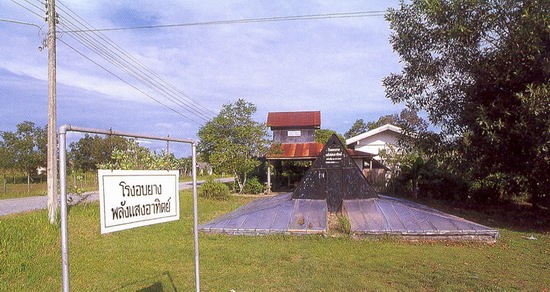
ชุดแสงไฟล่อแมลงด้วยเซลล์แสงอาทิตย์ โดยบริษัท สยามโซลาร์ แอนด์ อีเลคทรอนิคส์ จำกัด
โครงการฯ ได้นำชุดแสงไฟล่อแมลงด้วยเซลล์แสงอาทิตย์มาติดตั้งภายในบริเวณศูนย์ศึกษาการพัฒนาอ่าวคุ้งกระเบนฯ โดยประกอบด้วยเซลล์แสงอาทิตย์ขนาด 10 วัตต์ จำนวน 1 แผง หลอดไฟฟลูออเรสเซนต์ 6 วัตต์ จำนวน 1 ชุด แบตเตอรี่ขนาด 12 โวลต์ 4 แอมแปร์ชั่วโมง จำนวน 1 ลูก เซนเซอร์วัดความสว่าง 1 ชุด ชุดตั้งเวลาการทำงานของหลอดไฟกับพัดลม 1 ชุด พัดลมขนาด 2 นิ้ว 1 เครื่อง ชุดแสดงผลความจุแบตเตอรี่ 1 ชุด ถุงผ้าดักแมลง 1 ถุง และขาตั้งแบบเคลื่อนย้ายได้ 1 ชุด
ลักษณะการทำงานของระบบ เซลล์แสงอาทิตย์จะประจุกระแสไฟฟ้าลงในแบตเตอรี่ในเวลากลางวัน เมื่อดวงอาทิตย์ตกดินเซนเซอร์วัดความสว่างจะสั่งให้หลอดไฟสว่างและพัดลมหมุนเป็นเวลา 2 ชั่วโมง หลังจากนั้นหลอดไฟและพัดลมจะหยุดทำงาน เพราะโดยปกติแมลงจะออกมาเล่นไฟประมาณ 2 ชั่วโมง ในขณะที่หลอดไฟสว่างและพัดลมหมุนนั้น หากมีแมลงบินเข้าใกล้ก็จะถูกดูดให้ตกลงไปในถุง แมลงที่ได้นี้สามารถนำไปใช้เลี้ยงปลาได้ หรืออาจติดตั้งชุดแสงไฟล่อแมลงไว้กลางบ่อเลี้ยงปลาเพื่อให้แมลงตกลงไปในบ่อปลาโดยตรงเลยก็ได้
ดังนั้น กรมโยธาธิการจึงได้ออกแบบสูบน้ำด้วยเซลล์แสงอาทิตย์เพื่อปรับสภาพน้ำเปรี้ยวให้เป็นน้ำจืด ประกอบด้วยเซลล์แสงอาทิตย์ขนาด 1,480 วัตต์ เครื่องสูบน้ำมอเตอร์กระแสสลับ 1 เครื่อง เครื่องแปลงกระแสไฟฟ้า 1 เครื่อง ชุดควบคุม 1 ชุด และท่อส่งน้ำขนาดเส้นผ่าศูนย์กลาง 2.5 นิ้ว ระยะทาง 50 เมตร 1 ชุด โดยเครื่องสูบน้ำจะทำงานด้วยไฟฟ้าจากเซลล์แสงอาทิตย์ สูบน้ำเปรี้ยวที่มีสภาพเป็นกรดจากทางน้ำเปรี้ยว ผ่านท่อพีวีซี ขึ้นไปยังถังซึ่งบรรจุหินปูนคาร์บอเนต ความสูง 15 เมตร น้ำที่ไหลผ่านหินปูนจะมีค่า pH เพื่อขึ้น และเปลี่ยนสภาพเป็นน้ำจืด แล้วจึงไหลผ่านท่อด้วยแรงโน้มถ่วงไปยังแปลงเกษตร
ระบบสูบน้ำด้วยเซลล์แสงอาทิตย์นี้นอกจากจะมีประโยชน์ในการบำบัดน้ำเปรี้ยวแล้ว ในช่วงที่ไม่ได้ใช้กระแสไฟฟ้าสำหรับสูบน้ำ ยังใช้กระแสไฟฟ้ากับแสงสว่างได้ อีกทั้งยังเป็นเทคโนโลยีที่สามารถขยายผลไปสู่พื้นที่พรุที่ยังไม่มีระบบสายส่งไฟฟ้าเข้าถึงได้อีกด้วย
ปรับปรุงกังหันลมสูบน้ำ จำนวน 4 เครื่อง และติดตั้งอุปกรณ์ตรวจวัดระบบบันทึกข้อมูล โดยกรมพัฒนาและส่งเสริมพลังงาน (สนับสนุนโดยกรมพัฒนาและส่งเสริมพลังงาน และกองทุนเพื่อส่งเสริมการอนุรักษ์พลังงาน)
สืบเนื่องจากพระบาทสมเด็จพระเจ้าอยู่หัวทรงมีพระราชดำริให้ติดตั้งระบบกังหันลมสูบน้ำที่ผลิตภายในประเทศ เพื่อเป็นการทดลองประสิทธิภาพและตรวจวัดศักยภาพจำนวน 4 ระบบ ขึ้นที่บ้านตอหลัง อำเภอตากใบ จังหวัดนราธิวาส แต่ปัจจุบัน กังหันลมสูบน้ำมีสภาพชำรุดและไม่ได้ใช้งาน โครงการฯ จึงดำเนินการปรับปรุงระบบกังหันลมดังกล่าวให้มีประสิทธิภาพและสามารถใช้งานได้เต็มที่
เพื่อให้การจัดเก็บข้อมูลของระบบสูบน้ำด้วยกังหันลมมีความทันสมัย ชัดเจน และต่อเนื่องตลอดเวลา โครงการฯ จึงได้ติดตั้งอุปกรณ์วัดอัตราการไหลของน้ำแบบใช้รังสีอินฟราเรดซึ่งไม่ต้องตัดท่อน้ำ และอุปกรณ์บันทึกข้อมูลอัตโนมัติ ซึ่งจะบันทึกข้อมูลอัตราการสูบน้ำความเร็วลม และทิศทางลงในแผ่นบันทึกข้อมูลเพื่อความสะดวกในการนำข้อมูลมาวิเคราะห์ด้วยโปรแกรมคอมพิวเตอร์
ระบบผลิตไฟฟ้าด้วยเซลล์แสงอาทิตย์เชื่อมต่อสายส่ง โดยการไฟฟ้าฝ่ายผลิตแห่งประเทศไทย (สนับสนุนโดยกองทุนเพื่อส่งเสริมการอนุรักษ์พลังงาน)
ระบบผลิตไฟฟ้าด้วยเซลล์แสงอาทิตย์เชื่อมต่อสายส่งนี้ติดตั้งที่อาคารสำนักงาน ประกอบด้วยเซลล์แสงอาทิตย์ขนาด 2,100 วัตต์ อุปกรณ์ควบคุม 1 ชุด เครื่องแปลงกระแสไฟฟ้า 1 ชุด และวัตต์มิเตอร์แสดงผลการผลิตไฟฟ้า 1 ชุด
ในเวลาที่มีแสงอาทิตย์ เซลล์แสงอาทิตย์จะทำหน้าที่เปลี่ยนพลังงานแสงเป็นพลังงานไฟฟ้ากระแสตรงจากการออกแบบระบบจะให้ไฟฟ้ากระแสตรงขนาดแรงดัน 220-240 โวลต์ และกระแสไฟฟ้า 6-8 แอมแปร์ ไฟฟ้ากระแสตรงที่ผลิตได้จะไหลผ่านเครื่องแปลงกระแสไฟฟ้าและถูกเปลี่ยนเป็นไฟฟ้ากระแสสลับที่มีแรงดัน 220 โวลต์ และมีคุณสมบัติเหมือนกับกระแสไฟฟ้าในระบบไฟฟ้าที่มีอยู่เดิม ดังนั้นกระแสไฟฟ้าที่ผลิตได้จากระบบนี้จึงสามารถใช้ได้กับเครื่องใช้ไฟฟ้าที่มีอยู่ทุกชนิด โดยในกรณีที่กระแสไฟฟ้าที่ผลิตได้จากเซลล์แสงอาทิตย์มีมากกว่าความต้องการใช้ไฟฟ้าในขณะนั้น กระแสไฟฟ้าส่วนเกินจะถูกขายคืนเข้าในระบบสายส่งของการไฟฟ้าฯ ในทางกลับกันหากความต้องการใช้กระแสไฟฟ้าในขณะนั้นมีมากกว่ากระแสไฟฟ้าที่ผลิตได้กระแสไฟฟ้าส่วนที่ขาดก็จะถูกซื้อเสริมเข้ามาจากระบบสายส่งของการไฟฟ้าฯ ตามปกติ ซึ่งการทำงานของระบบได้รับการออกแบบให้เป็นการทำงานแบบอัตโนมัติดังนั้นจึงไม่ต้องมีการปิด-เปิดระบบแต่อย่างใดในแต่ละวัน
ผลจากการติดตั้งระบบ ทำให้ปริมาณกระแสไฟฟ้าที่ซื้อจากระบบสายส่งของการไฟฟ้าฯ ลดลงเท่ากับปริมาณกระแสไฟฟ้าที่ผลิตได้จากระบบเซลล์แสงอาทิตย์ ซึ่งเท่ากับว่าจะสามารถช่วยลดการใช้เชื้อเพลิงบรรพชีวิน เช่น น้ำมัน ก๊าซธรรมชาติ หรือถ่านหิน ในการผลิตกระแสไฟฟ้าลง อันจะส่งผลให้มลพิษที่เกิดจากการเผาไหม้เชื้อเพลิงดังกล่าวลดลงได้อีกทางหนึ่ง
ขยายขอบเขตระบบจำหน่ายไฟฟ้า โดยการไฟฟ้าส่วนภูมิภาค
การไฟฟ้าส่วนภูมิภาคได้ดำเนินโครงการขยายเขต ระบบจำหน่ายไฟฟ้าให้โครงการพัฒนาพื้นที่บ้านยูโยอันเนื่องมาจากพระราชดำริ อำเภอตากใน จังหวัดนราธิวาส ซึ่งมีบ้านเรือนราษฎร 213 หลังคาเรือน จำนวนประชากร 1,116 คน เพื่อสนับสนุนในการพัฒนาปรับปรุงดินเปรี้ยวให้สามารถทำการเกษตรได้ในพื้นที่ดูแลของศูนย์ศึกษาการพัฒนาพิกุลทองฯ โดยก่อสร้างระบบจำหน่ายไฟฟ้าแรงดันสูง 1 เฟส 19 กิโลโวลต์ เป็นระยะทาง 4.4 กิโลเมตร และระบบจำหน่ายแรงดันต่ำเป็นระยะทาง 4.7 กิโลเมตร พร้อมติดตั้งหม้อแปลง ขนาด 30 กิโลโวลต์แอมแปร์ จำนวน 3 เครื่อง ใช้งบประมาณทั้งสิ้น 2,299,836 บาท แบ่งเป็นงบประมาณจากการไฟฟ้าส่วนภูมิภาค 710,779 บาท และจากสำนักงาน กปร. 1,589,057 บาท
เครื่องสกัดสารกำจัดศัตรูพืชด้วยพลังงานแสงอาทิตย์ โดยบริษัท โซลาร์ตรอน จำกัด
เครื่องสกัดสารกำจัดศัตรูพืชด้วยพลังงานแสงอาทิตย์ประกอบด้วยแผงรับพลังงานแสงอาทิตย์ 1 ชุด ถังสกัดสารไส้กรอง ท่อน้ำเข้าถังและท่อน้ำเข้าแผง วาล์วเช็คระดับน้ำ ขารับแผงและถัง เป็นอุปกรณ์ที่นำพลังงานความร้อนจากแสงอาทิตย์มาใช้ ประโยชน์ในการต้มสกัดสารชีวภาพ ซึ่งมีอยู่ในสมุนไพรบางชนิด เช่น ตะไคร้ หอม สะเดา ข่า และอื่นๆ โดยการทำงานจะเริ่มต้นขึ้นเมื่อแสงอาทิตย์ตกกระทบแผงรับแสงอาทิตย์ พลังงานความร้อนจะถูกดูดซับและส่งถ่ายความร้อนให้กับน้ำที่อยู่ในระบบ ทำให้น้ำร้อนและลอยตัวขึ้นที่สูงแล้วไหลไปตามท่อหุ้มฉนวนเข้าสู่ถังสกัดสารกำจัดศัตรูพืชหรือหม้อต้มซึ่งใส่สมุนไพรไว้ ขณะเดียวกันน้ำส่วนล่างของหม้อต้มก็จะไหลไปตามท่อหุ้มฉนวนด้านตรงข้ามเข้าสู่แผงรับแสงอาทิตย์เพื่อรับพลังงานความร้อนจากแผงเป็นวัฏจักรเรียกว่า ระบบไหลเวียนตามธรรมชาติ น้ำในหม้อต้มจะมีอุณหภูมิสูงขึ้นเรื่อยๆ จนถึงประมาณ 90 องศาเซลเซียส โดยใช้เวลาวันละ 6-8 ชั่วโมง ก็จะได้น้ำสารสกัดจากพืชสมุนไพร 75-100 ลิตรต่อวัน เมื่อปล่อยให้เย็นก็สามารถนำน้ำสารสกัดไปฉีดพ่นพืชผักผลไม้ได้ทันที เพื่อป้องกันศัตรูพืชที่จะมาทำลาย
ชุดกรองน้ำดื่มระบบรีเวิร์สออสโมซิสทำงานด้วยไฟฟ้าจากเซลล์แสงอาทิตย์ โดยมหาวิทยาลัยเทคโนโลยีพระจอมเกล้าธนบุรี
ชุดกรองน้ำดื่มระบบรีเวิร์สออสโมซิสเป็นเครื่องฟอกน้ำจืด น้ำกร่อย หรือ น้ำทะเลให้เป็นน้ำจืดบริสุทธิ์ โดยมีหลักในการทำงาน คือ ใช้เยื่อเมมเบรน (membrane) ซึ่งเป็นเยื่อบางๆ คล้ายแผ่นกระดาษแต่มีเนื้อละเอียดถึง 0.0001 ไมครอน ทำให้โมเลกุลของสารละลายในน้ำไม่สามารถลอดผ่านไปได้ โดยเยื้อเมมเบรนจะทำงานควบคู่กับเครื่องสูบน้ำแรงดันสูงที่ทำหน้าที่ผลักดันน้ำดิบให้ผ่านเยื่อเมมเบรนเครื่องสูบน้ำดังกล่าวทำงานด้วยไฟฟ้าที่ผลิตจากเซลล์แสงอาทิตย์
ระบบที่นำมาติดตั้งนี้ประกอบด้วยแผงเซลล์แสงอาทิตย์ขนาด 60 วัตต์ แบตเตอรี่ขนาด 624 วัตต์ต่อชั่วโมง ชุดควบคุม และเครื่องสูบน้ำแรงดันสูง โดยการทำงานจะเริ่มจากการเปิดวาล์วให้น้ำดิบเข้าสู่ระบบไฟฟ้าจากเซลล์แสงอาทิตย์จะเดินเครื่องสูบน้ำให้ทำงานเพื่อเพิ่มความดันให้น้ำดิบ อัดน้ำผ่านส่วนไส้กรองคาร์บอนทั้งชนิดเม็ดและชนิดผง ส่วนเยื่อกรองเมมเบรน และส่วนไส้กรองคาร์บอนอันสุดท้ายจนได้เป็นน้ำบริสุทธิ์
ชุดแสงไฟล่อแมลงด้วยเซลล์แสงอาทิตย์ โดยบริษัท สยามโซลาร์ แอนด์ อีเลคทรอนิคส์ จำกัด
แต่เดิมที่ศูนย์ศึกษาการพัฒนาพิกุลทองฯ ยังไม่มีเครื่องล่อแมลงที่จะใช้กำจัดแมลงบางชนิดที่เป็นศูนย์พืช จึงได้นำชุดแสงไฟล่อแมลงด้วยเซลล์แสงอาทิตย์มาติดตั้งภายในบริเวณศูนย์ฯ อุปกรณ์ชนิดนี้ประกอบด้วยเซลล์แสงอาทิตย์ขนาด 10 วัตต์ จำนวน 1 แผง หลอดไฟฟลูออเรสเซนต์ 6 วัตต์ จำนวน 1 ชุด แบตเตอรี่ขนาด 12 โวลต์ 4 แอมแปร์ชั่วโมง จำนวน 1 ลูก เซนเซอร์วัดความสว่าง 1 ชุด ชุดตั้งเวลาการทำงานของหลอดไฟกับพัดลม 1 ชุด พัดลมขนาด 2 นิ้ว 1 เครื่องชุดแสดงผลความจุแบตเตอรี่ 1 ชุด ถุงผ้าดักแมลง 1 ถุง และขาตั้งแบบเคลื่อนย้ายได้ 1 ชุด
เซลล์แสงอาทิตย์จะประจุกระแสไฟฟ้าลงในแบตเตอรี่ในเวลากลางวัน เมื่อดวงอาทิตย์ตกดิน เซนเซอร์วัดความสว่างจะสั่งให้หลอดไฟสว่างและพัดลมหมุนเป็นเวลา 2 ชั่วโมง เพราะโดยปกติแมลงจะออกมาเล่นไฟประมาณ 2 ชั่วโมง โดยในขณะที่หลอดไฟสว่างและพัดลมหมุนนั้น หากมีแมลงบินเข้าใกล้ก็จะถูกดูดให้ตกลงไปในถุง และแมลงที่ได้นี้สามารถนำไปใช้เลี้ยงปลาได้ นอกจากนี้ ชุดแสงไฟล่อแมลงยังสามารถติดตั้งไว้กลางบ่อเลี้ยงปลาเพื่อให้แมลงตกลงไปในบ่อปลาโดยตรงได้ด้วย
ระบบผลิตก๊าซชีวภาพจากมูลสัตว์ โดยกรมส่งเสริมการเกษตร
ลักษณะบ่อผลิตก๊าซชีวภาพเป็นบ่อแบบโดมคงที่ขนาด 8 ลูกบาศก์เมตร โดยใช้วัตถุดิบที่ใช้ในการหมักเพื่อผลิตเป็นก๊าซชีวภาพนั้น ใช้มูลจากคอกโคนมสาธิตจำนวน 6 ตัว สามารถผลิตก๊าซชีวภาพได้ประมาณวันละ 3-5 ลูกบาศก์เมตร ซึ่งพอเพียงที่จะนำมาใช้เป็นพลังงานในการต้มนมแพะและโคนมที่ผลิตได้ภายในศูนย์ฯ ใช้เป็นพลังงานในการกกลูกไก่และลูกเป็ด ทำให้ประหยัดพลังงานก๊าซหุงต้มเดือนละ 2 ถัง (ขนาด 15 กิโลกรัม) ส่วนพลังงานที่เหลือทางศูนย์ฯ จะเดินท่อก๊าซไปบ้านพักคนงานบริเวณโดยรอบเพื่อนำไปใช้ประโยชน์
เครื่องวัดพลังงานแสงอาทิตย์ โดยมหาวิทยาลัยเทคโนโลยีพระจอมเกล้าธนบุรี
เครื่องวัดพลังงานแสงอาทิตย์ ประกอบด้วย 2 ส่วน ได้แก่
1.ส่วนเซนเซอร์หรือไพรานอมิเตอร์ ประกอบด้วยเซลล์แสงอาทิตย์ชนิดผลึกซิลิคคอนขนาด 1 ตารางเซนติเมตร และขั้วของเซลล์และอาทิตย์
2.ส่วนอินติเกรตสัญญาณ ทำหน้าที่แสดงผลและอินติเกรตค่าความเข้มรังสีดวงอาทิตย์เป็นพลังงาน
ประโยชน์ของเครื่องวัดพลังงานแสงอาทิตย์ คือสามารถวัดค่าพลังงานแสงอาทิตย์ในช่วงเวลาต่างๆ ซึ่งทำให้ทราบประสิทธิภาพการทำงานของระบบพลังงานทดแทนที่ใช้พลังงานแสงอาทิตย์ อันเป็นประโยชน์ต่อการพัฒนาระบบและอุปกรณ์ต่างๆ ในอนาคตได้
มุ้งแอร์สุขภาพรุ่นประหยัดพลังงาน โดยนายศฤงคาร รัตนางศุ (สมาคมการประดิษฐ์ไทย)
เมุ้งติดแอร์ ประกอบด้วยโครงเหล็กขนาดเล็กแบบถอดประกอยได้ มีหลังคาทรงโค้งคล้ายทรงโดมและมีทางเข้าออก โดยตัวมุ้งผลิตจากผ้าชนิดพิเศษและมีน้ำหนักเบาเป็นลักษณะ 2 ชั้น ชั้นนอกโปร่งและชั้นในทึบเพื่อเป็นฉนวนความร้อน โดยมีช่องแอร์สำหรับต่อเข้ากับเครื่องปรับอากาศเคลื่อนที่ขนาดเล็กที่มีระบบฟอกอากาศ ด้านหน้าพ่นลมเย็น ด้านหลังพ่นลมร้อนซึ่งสามารถใช้เป็นเครื่องทำความอุ่นให้กับมุ้งติดแอร์ได้ เครื่องปรับอากาศเคลื่อนที่ขนาดเล็กนี้สามารถนำมาใช้ทดแทนพัดลมซึ่งให้ลมเย็นกว่าพัดลมไอน้ำ และเนื่องจากเป็นเครื่องปรับอากาศเล็กจึงสิ้นเปลืองพลังงานไฟฟ้าน้อยมาก
ระบบเครื่องขยายเสียงพลังงานแสงอาทิตย์ โดยบริษัท โซลาร์ตรอน จำกัด
ระบบประกอบด้วยแผงเซลล์แสงอาทิตย์ขนาด 6 วัตต์ 12 โวลต์ 0.3 แอมแปร์ จำนวน 1 แผง แบตเตอรี่แบบ sealed lead acid ขนาด 12 โวลต์ 0.7 แอมแปร์ จำนวน 1 ลูก และเครื่องขยายเสียง พร้อมไมโครโฟนแบบมีสายและแบบไร้สาย จำนวน 1 ชุด ชุดเครื่องขยายเสียงถูกดัดแปลงให้สามารถใช้ได้ทั้งไฟฟ้ากระแสตรงและไฟฟ้ากระแสสลับ มีขนาดกำลังขยาย 50 วัตต์ โดยสามารถใช้งานได้ทั้งไมโครโฟนแบบมีสายและแบบไร้สายซึ่งใช้กระแสไฟฟ้าขนาด 0.5 แอมแปร์ และสามารถใช้งานติดต่อกันเป็นเวลา 3 ชั่วโมงต่อวัน เหมาะสำหรับการใช้งานในภาคสนามและเลือกใช้ตามความเหมาะสมได้อีกด้วย
คุณชัยวัฒน์ สิทธิบุศย์ ผู้อำนวยการศูนย์ศึกษาการพัฒนาพิกุลทองฯ ให้สัมภาษณ์ถึงสภาพการใช้งานและประโยชน์ที่ได้รับจากระบบพลังงานทดแทนที่โครงการฯ นำมาติดตั้งในพื้นที่ ดังรายละเอียดต่อไปนี้
สภาพการใช้พลังงานที่มีอยู่เดิมภายในพื้นที่
คุณชัยวัฒน์ : "สำหรับการใช้พลังงานทดแทนที่ภาคใต้ถือว่ามีค่อนข้างน้อยกว่าที่อื่น อาจจะเป็นเพราะคนที่มียังไม่ค่อยกระตือรือร้น ไม่ค่อยสนใจ หรืออาจจะเป็นเพราะยังไม่มีข้อมูล ไม่มีความรู้ก็ได้ แต่สำหรับผมคิดว่าน่าสนใจและน่าจะนำมาใช้ เพราะอย่างพลังงานลมหรือพลังงานแสงอาทิตย์ ที่นี่ก็มีความเหมาะสมแต่ก็ยังมีการใช้น้อยมาก ส่วนพลังงานอีกอย่างหนึ่งที่น่าจะใช้มากสำหรับที่นี่ก็คือน้ำ เพราะที่นี่มีน้ำเยอะ มีน้ำเหลือเฟือเลย เราก็น่าจะมีการศึกษาเกี่ยวกับการนำน้ำมาใช้เป็นพลังงานทดแทนในรูปแบบอื่นด้วยเหมือนกัน
ผลที่ได้รับจากการนำพลังงานทดแทนมาใช้ภายในศูนย์ฯ
คุณชัยวัฒน์ : "สำหรับกังหันลม ผมพูดตรงๆ ว่ากังหันลมที่มีอยู่ในปัจจุบันยังไม่ค่อยได้ผลดีนัก เพราะว่าระบบมันจะใช้ได้ดีในช่วงแรกๆ แต่พอสักระยะหนึ่งมักจะมีปัญหาเกี่ยวกับอุปกรณ์ที่มีอายุการใช้งานที่สั้น ถ้ามีการพัฒนาให้กังหันลมมีประสิทธิภาพมากกว่านี้ก็น่าจะใช้ได้ดี หรืออย่างระบบบำบัดน้ำเปรี้ยวที่แต่เดิมเราใช้ไฟฟ้าก็มีการนำระบบเซลล์แสงอาทิตย์ใช้แทน แต่ยังมีข้อจำกัดอยู่ตรงที่ต้องใช้คนไปเปิดปิดจึงไม่ค่อยสะดวก ซึ่งหากมีการเก็บพลังงานแสงอาทิตย์ไว้ในแบตเตอรี่และมีระบบเปิดปิดด้วยก็จะทำให้ไม่ต้องใช้คนมากเท่านี้
"ส่วนพลังงานก๊าซชีวภาพ สำหรับภาคใต้นี่ถือว่าเป็นพลังงานที่เหมาะสมและดีมากเลยทีเดียว เพราะข้อเท็จจริงแล้วในภาคใต้นี้ ครอบครัวเกษตรกรทุกครอบครัวมักจะต้องเลี้ยงวัว เลี้ยงสัตว์ เขาเลี้ยงวัวกันทุกบ้าน พลังงานก๊าซชีวภาพจึงเป็นระบบที่เข้ากับชีวิตความเป็นอยู่ของคนที่นี่เป็นอย่างดี"
ความคิดเห็นเกี่ยวกับโครงการนำพลังงานทดแทนมาติดตั้งในศูนย์ฯ
คุณชัยวัฒน์ : "สำหรับการใช้พลังงานทดแทนที่ภาคใต้ถือว่ามีค่อนข้างน้อยกว่าที่อื่น อาจจะเป็นเพราะคนที่มียังไม่ค่อยกระตือรือร้น ไม่ค่อยสนใจ หรืออาจจะเป็นเพราะยังไม่มีข้อมูล ไม่มีความรู้ก็ได้ แต่สำหรับผมคิดว่าน่าสนใจและน่าจะนำมาใช้ เพราะอย่างพลังงานลมหรือพลังงานแสงอาทิตย์ ที่นี่ก็มีความเหมาะสมแต่ก็ยังมีการใช้น้อยมาก ส่วนพลังงานอีกอย่างหนึ่งที่น่าจะใช้มากสำหรับที่นี่ก็คือน้ำ เพราะที่นี่มีน้ำเยอะ มีน้ำเหลือเฟือเลย เราก็น่าจะมีการศึกษาเกี่ยวกับการนำน้ำมาใช้เป็นพลังงานทดแทนในรูปแบบอื่นด้วยเหมือนกัน
คุณชัยวัฒน์ : "การนำพลังงานทดแทนมาติดตั้งที่ศูนย์ฯ นี่ ผมว่าน่าจะได้ผลดีมาก เพราะว่าศูนย์ฯ ที่นี่มีคนมาเที่ยวมาดูมาก เมื่อมีคนมาดูงานและเห็นว่าเรามีการใช้พลังงานทดแทน ก็จะเป็นแรงผลักดันให้เขาอยากจะหาพลังงานทดแทนมาใช้บ้าง หรืออาจจะส่งผลให้เกิดความคิดที่จะช่วยกันประหยัดพลังงาน การติดตั้งระบบพลังงานทดแทนที่ศูนย์ฯ นอกจากจะเป็นตัวอย่างให้คนได้เห็นแล้ว ยังช่วยให้เกิดแนวคิดด้านการประหยัดพลังงานอีกด้วย
"ซึ่งผมว่าเราทุกคนน่าจะตระหนักถึงเรื่องการประหยัดพลังงานให้มากขึ้น แล้วก็น่าจะมีการศึกษาเพื่อหาหนทางพัฒนาพลังงานทดแทนใช้ให้ได้ประโยชน์มากขึ้น ไม่ว่าจะเป็นพลังงาน หรือก๊าซชีวภาพจะต้องมีการศึกษาหาวิธีการใช้ประโยชน์ต่อไป รวมทั้งการประชาสัมพันธ์ให้ความรู้ความเข้าใจในเรื่องพลังงานทดแทนแก่คนทั่วไปก็ควรจะทำด้วย เพราะจะเป็นประโยชน์ต่อการพัฒนาและการประหยัดพลังงานของประเทศในอนาคต"
ที่มา : พระบิดาแห่งการพัฒนาพลังงานไทย















